Oil and Gas Industry Analysis
VerifiedAdded on 2021/04/24
|54
|13333
|186
AI Summary
This assignment involves analyzing various aspects of the oil and gas industry, including refineries, petrochemicals, deregulation, privatization, health and safety reports, dynamic capabilities, and more. The student is expected to provide a comprehensive review of these topics, including references from reputable sources such as academic journals, government websites, and industry reports.
Contribute Materials
Your contribution can guide someone’s learning journey. Share your
documents today.
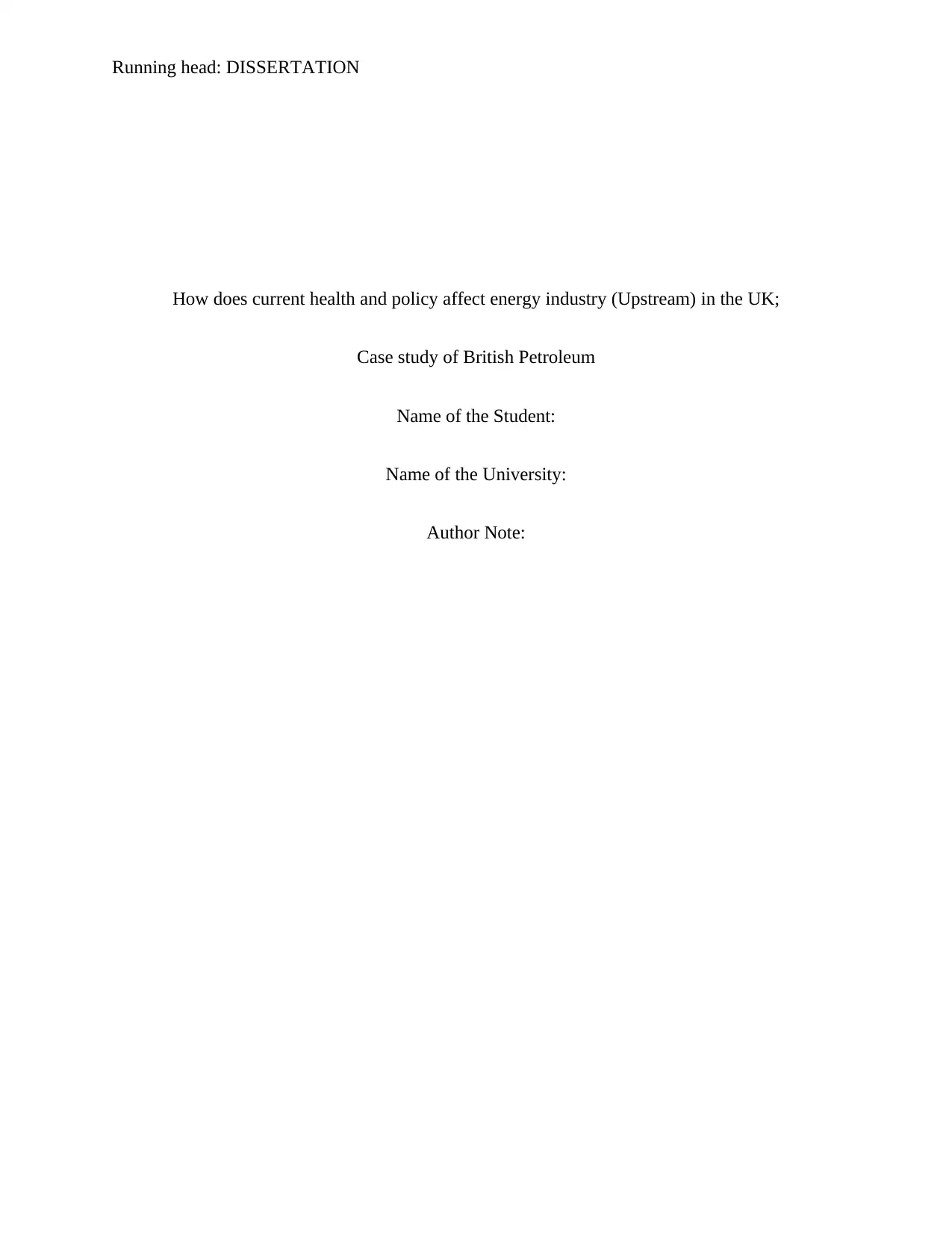
Running head: DISSERTATION
How does current health and policy affect energy industry (Upstream) in the UK;
Case study of British Petroleum
Name of the Student:
Name of the University:
Author Note:
How does current health and policy affect energy industry (Upstream) in the UK;
Case study of British Petroleum
Name of the Student:
Name of the University:
Author Note:
Secure Best Marks with AI Grader
Need help grading? Try our AI Grader for instant feedback on your assignments.
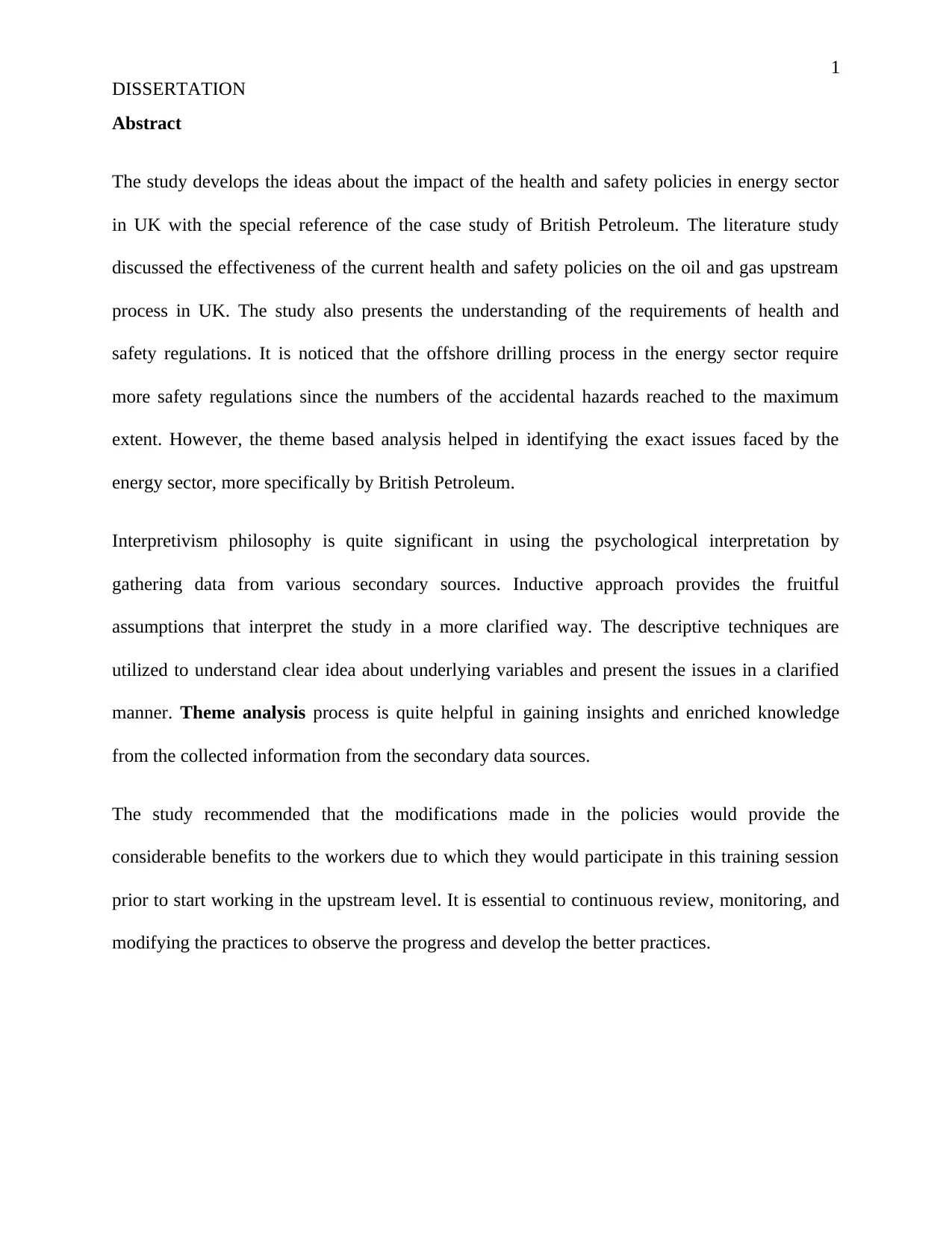
1
DISSERTATION
Abstract
The study develops the ideas about the impact of the health and safety policies in energy sector
in UK with the special reference of the case study of British Petroleum. The literature study
discussed the effectiveness of the current health and safety policies on the oil and gas upstream
process in UK. The study also presents the understanding of the requirements of health and
safety regulations. It is noticed that the offshore drilling process in the energy sector require
more safety regulations since the numbers of the accidental hazards reached to the maximum
extent. However, the theme based analysis helped in identifying the exact issues faced by the
energy sector, more specifically by British Petroleum.
Interpretivism philosophy is quite significant in using the psychological interpretation by
gathering data from various secondary sources. Inductive approach provides the fruitful
assumptions that interpret the study in a more clarified way. The descriptive techniques are
utilized to understand clear idea about underlying variables and present the issues in a clarified
manner. Theme analysis process is quite helpful in gaining insights and enriched knowledge
from the collected information from the secondary data sources.
The study recommended that the modifications made in the policies would provide the
considerable benefits to the workers due to which they would participate in this training session
prior to start working in the upstream level. It is essential to continuous review, monitoring, and
modifying the practices to observe the progress and develop the better practices.
DISSERTATION
Abstract
The study develops the ideas about the impact of the health and safety policies in energy sector
in UK with the special reference of the case study of British Petroleum. The literature study
discussed the effectiveness of the current health and safety policies on the oil and gas upstream
process in UK. The study also presents the understanding of the requirements of health and
safety regulations. It is noticed that the offshore drilling process in the energy sector require
more safety regulations since the numbers of the accidental hazards reached to the maximum
extent. However, the theme based analysis helped in identifying the exact issues faced by the
energy sector, more specifically by British Petroleum.
Interpretivism philosophy is quite significant in using the psychological interpretation by
gathering data from various secondary sources. Inductive approach provides the fruitful
assumptions that interpret the study in a more clarified way. The descriptive techniques are
utilized to understand clear idea about underlying variables and present the issues in a clarified
manner. Theme analysis process is quite helpful in gaining insights and enriched knowledge
from the collected information from the secondary data sources.
The study recommended that the modifications made in the policies would provide the
considerable benefits to the workers due to which they would participate in this training session
prior to start working in the upstream level. It is essential to continuous review, monitoring, and
modifying the practices to observe the progress and develop the better practices.
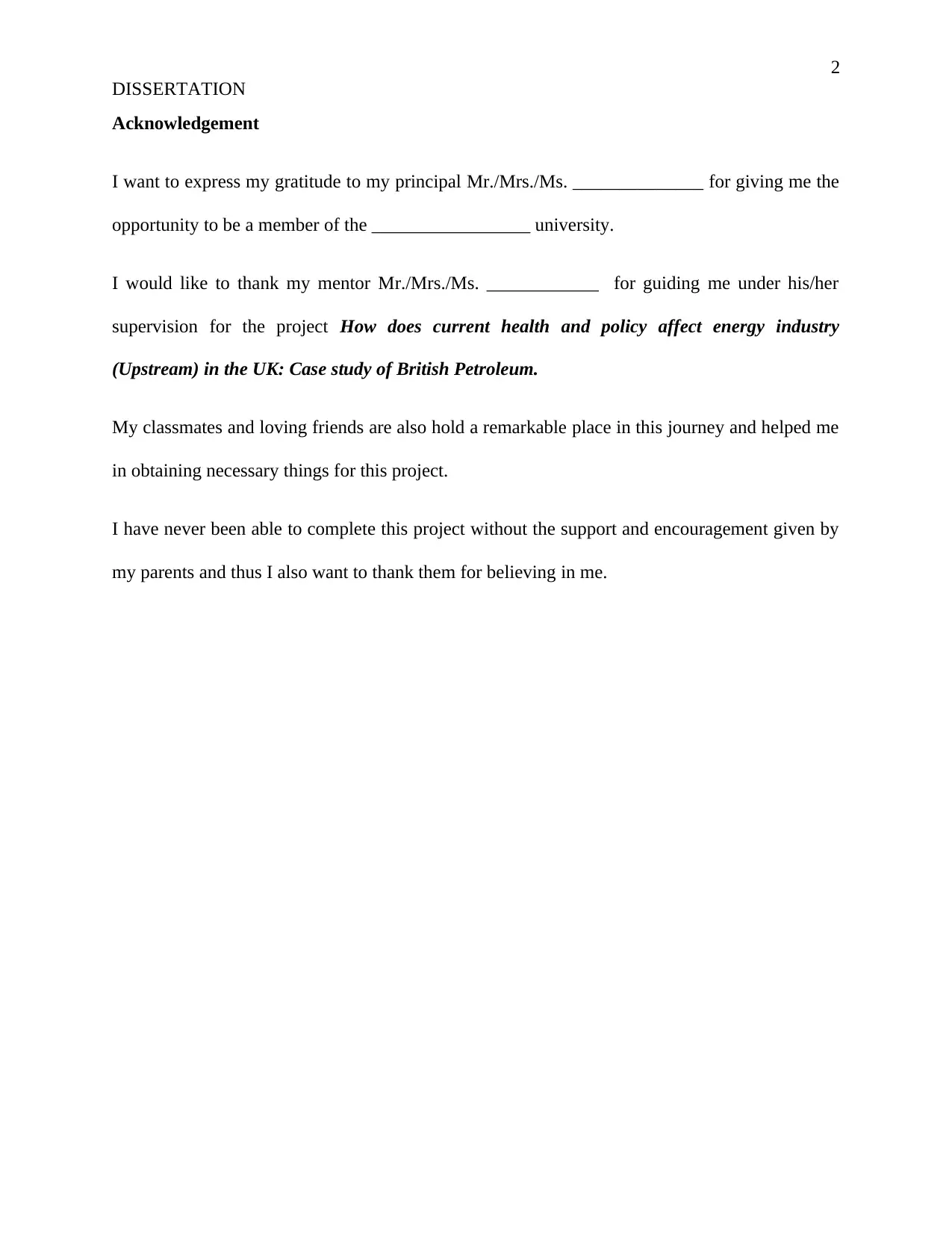
2
DISSERTATION
Acknowledgement
I want to express my gratitude to my principal Mr./Mrs./Ms. ______________ for giving me the
opportunity to be a member of the _________________ university.
I would like to thank my mentor Mr./Mrs./Ms. ____________ for guiding me under his/her
supervision for the project How does current health and policy affect energy industry
(Upstream) in the UK: Case study of British Petroleum.
My classmates and loving friends are also hold a remarkable place in this journey and helped me
in obtaining necessary things for this project.
I have never been able to complete this project without the support and encouragement given by
my parents and thus I also want to thank them for believing in me.
DISSERTATION
Acknowledgement
I want to express my gratitude to my principal Mr./Mrs./Ms. ______________ for giving me the
opportunity to be a member of the _________________ university.
I would like to thank my mentor Mr./Mrs./Ms. ____________ for guiding me under his/her
supervision for the project How does current health and policy affect energy industry
(Upstream) in the UK: Case study of British Petroleum.
My classmates and loving friends are also hold a remarkable place in this journey and helped me
in obtaining necessary things for this project.
I have never been able to complete this project without the support and encouragement given by
my parents and thus I also want to thank them for believing in me.
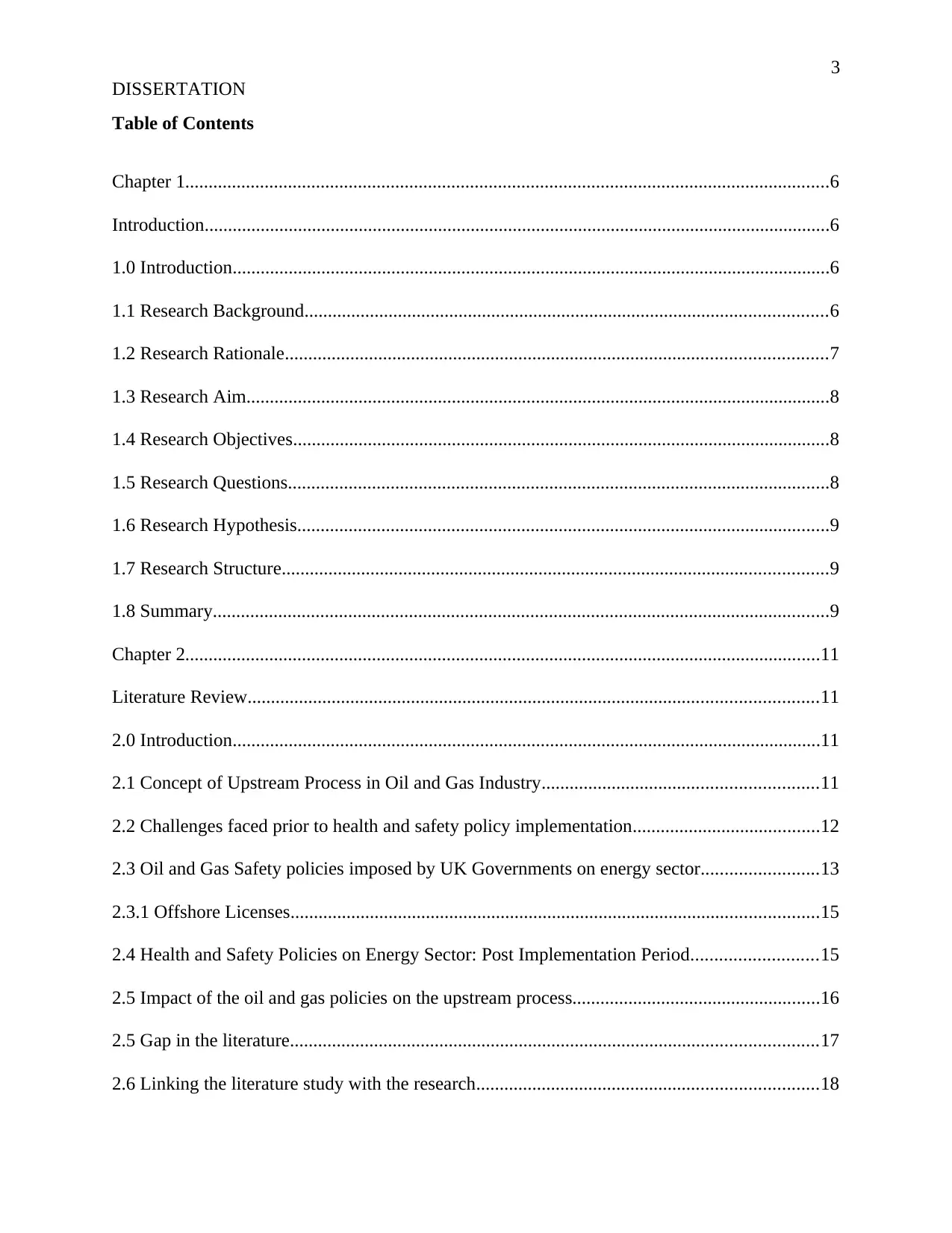
3
DISSERTATION
Table of Contents
Chapter 1..........................................................................................................................................6
Introduction......................................................................................................................................6
1.0 Introduction................................................................................................................................6
1.1 Research Background................................................................................................................6
1.2 Research Rationale....................................................................................................................7
1.3 Research Aim.............................................................................................................................8
1.4 Research Objectives...................................................................................................................8
1.5 Research Questions....................................................................................................................8
1.6 Research Hypothesis..................................................................................................................9
1.7 Research Structure.....................................................................................................................9
1.8 Summary....................................................................................................................................9
Chapter 2........................................................................................................................................11
Literature Review..........................................................................................................................11
2.0 Introduction..............................................................................................................................11
2.1 Concept of Upstream Process in Oil and Gas Industry...........................................................11
2.2 Challenges faced prior to health and safety policy implementation........................................12
2.3 Oil and Gas Safety policies imposed by UK Governments on energy sector.........................13
2.3.1 Offshore Licenses.................................................................................................................15
2.4 Health and Safety Policies on Energy Sector: Post Implementation Period...........................15
2.5 Impact of the oil and gas policies on the upstream process.....................................................16
2.5 Gap in the literature.................................................................................................................17
2.6 Linking the literature study with the research.........................................................................18
DISSERTATION
Table of Contents
Chapter 1..........................................................................................................................................6
Introduction......................................................................................................................................6
1.0 Introduction................................................................................................................................6
1.1 Research Background................................................................................................................6
1.2 Research Rationale....................................................................................................................7
1.3 Research Aim.............................................................................................................................8
1.4 Research Objectives...................................................................................................................8
1.5 Research Questions....................................................................................................................8
1.6 Research Hypothesis..................................................................................................................9
1.7 Research Structure.....................................................................................................................9
1.8 Summary....................................................................................................................................9
Chapter 2........................................................................................................................................11
Literature Review..........................................................................................................................11
2.0 Introduction..............................................................................................................................11
2.1 Concept of Upstream Process in Oil and Gas Industry...........................................................11
2.2 Challenges faced prior to health and safety policy implementation........................................12
2.3 Oil and Gas Safety policies imposed by UK Governments on energy sector.........................13
2.3.1 Offshore Licenses.................................................................................................................15
2.4 Health and Safety Policies on Energy Sector: Post Implementation Period...........................15
2.5 Impact of the oil and gas policies on the upstream process.....................................................16
2.5 Gap in the literature.................................................................................................................17
2.6 Linking the literature study with the research.........................................................................18
Paraphrase This Document
Need a fresh take? Get an instant paraphrase of this document with our AI Paraphraser
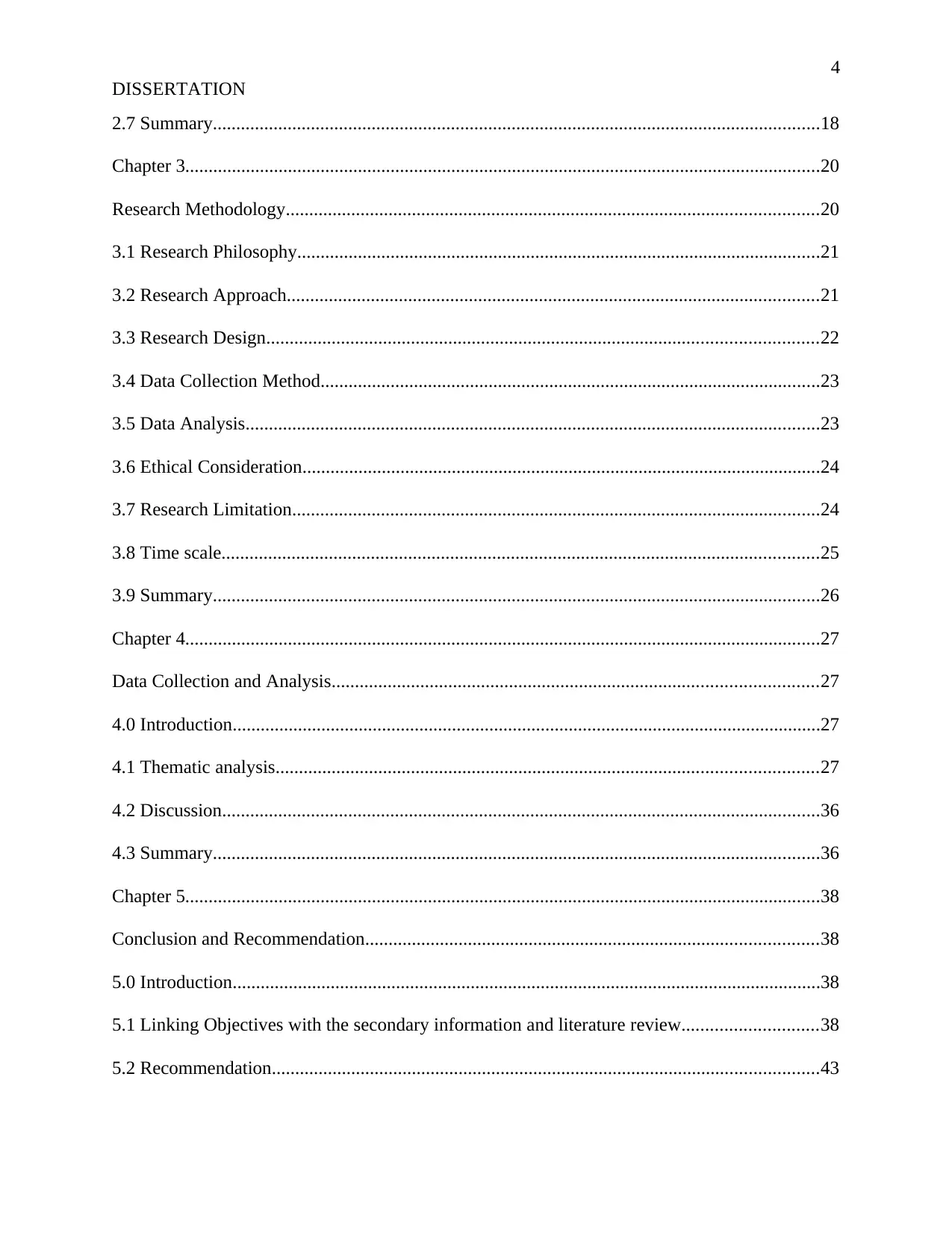
4
DISSERTATION
2.7 Summary..................................................................................................................................18
Chapter 3........................................................................................................................................20
Research Methodology..................................................................................................................20
3.1 Research Philosophy................................................................................................................21
3.2 Research Approach..................................................................................................................21
3.3 Research Design......................................................................................................................22
3.4 Data Collection Method...........................................................................................................23
3.5 Data Analysis...........................................................................................................................23
3.6 Ethical Consideration...............................................................................................................24
3.7 Research Limitation.................................................................................................................24
3.8 Time scale................................................................................................................................25
3.9 Summary..................................................................................................................................26
Chapter 4........................................................................................................................................27
Data Collection and Analysis........................................................................................................27
4.0 Introduction..............................................................................................................................27
4.1 Thematic analysis....................................................................................................................27
4.2 Discussion................................................................................................................................36
4.3 Summary..................................................................................................................................36
Chapter 5........................................................................................................................................38
Conclusion and Recommendation.................................................................................................38
5.0 Introduction..............................................................................................................................38
5.1 Linking Objectives with the secondary information and literature review.............................38
5.2 Recommendation.....................................................................................................................43
DISSERTATION
2.7 Summary..................................................................................................................................18
Chapter 3........................................................................................................................................20
Research Methodology..................................................................................................................20
3.1 Research Philosophy................................................................................................................21
3.2 Research Approach..................................................................................................................21
3.3 Research Design......................................................................................................................22
3.4 Data Collection Method...........................................................................................................23
3.5 Data Analysis...........................................................................................................................23
3.6 Ethical Consideration...............................................................................................................24
3.7 Research Limitation.................................................................................................................24
3.8 Time scale................................................................................................................................25
3.9 Summary..................................................................................................................................26
Chapter 4........................................................................................................................................27
Data Collection and Analysis........................................................................................................27
4.0 Introduction..............................................................................................................................27
4.1 Thematic analysis....................................................................................................................27
4.2 Discussion................................................................................................................................36
4.3 Summary..................................................................................................................................36
Chapter 5........................................................................................................................................38
Conclusion and Recommendation.................................................................................................38
5.0 Introduction..............................................................................................................................38
5.1 Linking Objectives with the secondary information and literature review.............................38
5.2 Recommendation.....................................................................................................................43

5
DISSERTATION
5.3 Future Scope of the Study........................................................................................................45
Chapter 6........................................................................................................................................46
Reflective Log...............................................................................................................................46
References......................................................................................................................................48
DISSERTATION
5.3 Future Scope of the Study........................................................................................................45
Chapter 6........................................................................................................................................46
Reflective Log...............................................................................................................................46
References......................................................................................................................................48
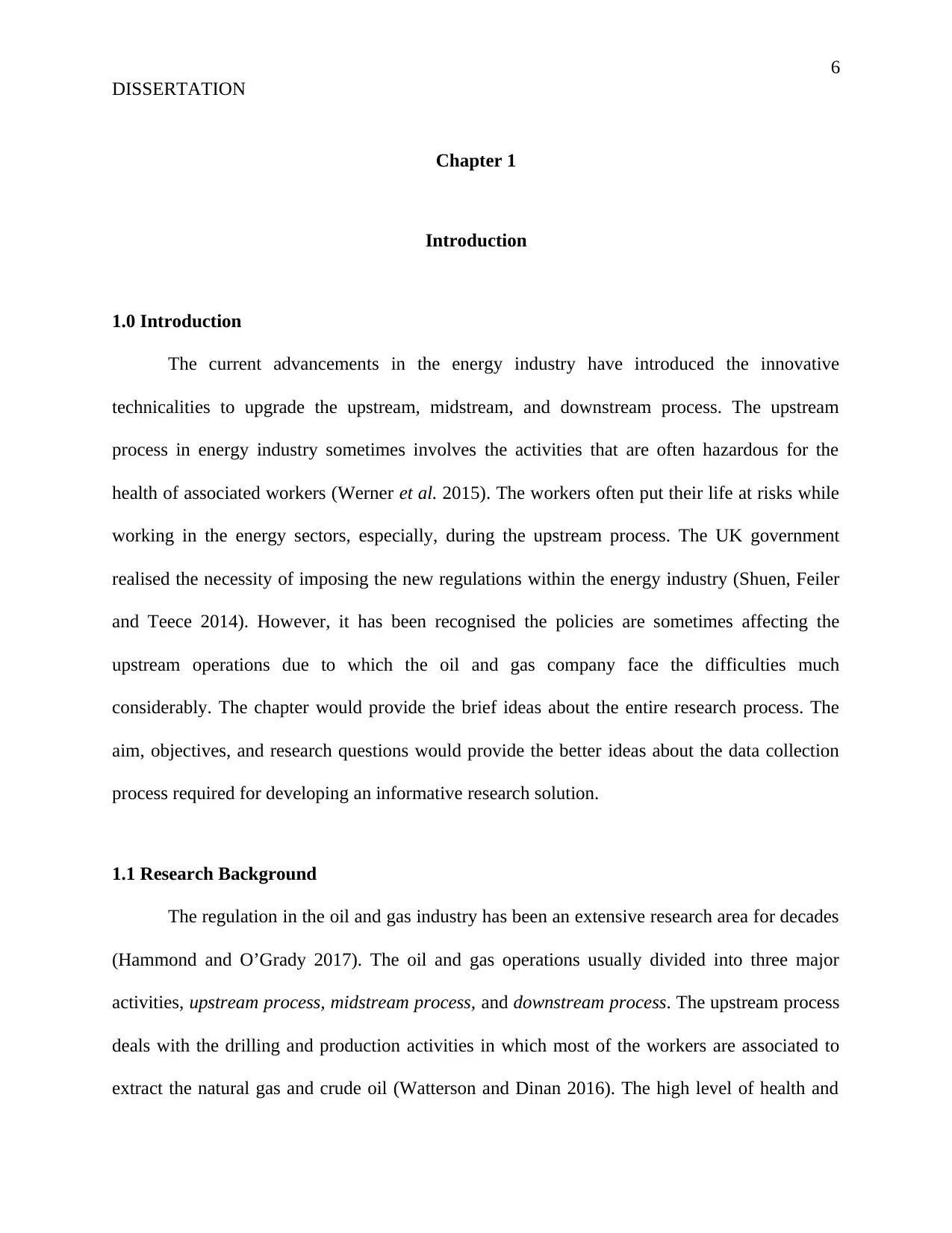
6
DISSERTATION
Chapter 1
Introduction
1.0 Introduction
The current advancements in the energy industry have introduced the innovative
technicalities to upgrade the upstream, midstream, and downstream process. The upstream
process in energy industry sometimes involves the activities that are often hazardous for the
health of associated workers (Werner et al. 2015). The workers often put their life at risks while
working in the energy sectors, especially, during the upstream process. The UK government
realised the necessity of imposing the new regulations within the energy industry (Shuen, Feiler
and Teece 2014). However, it has been recognised the policies are sometimes affecting the
upstream operations due to which the oil and gas company face the difficulties much
considerably. The chapter would provide the brief ideas about the entire research process. The
aim, objectives, and research questions would provide the better ideas about the data collection
process required for developing an informative research solution.
1.1 Research Background
The regulation in the oil and gas industry has been an extensive research area for decades
(Hammond and O’Grady 2017). The oil and gas operations usually divided into three major
activities, upstream process, midstream process, and downstream process. The upstream process
deals with the drilling and production activities in which most of the workers are associated to
extract the natural gas and crude oil (Watterson and Dinan 2016). The high level of health and
DISSERTATION
Chapter 1
Introduction
1.0 Introduction
The current advancements in the energy industry have introduced the innovative
technicalities to upgrade the upstream, midstream, and downstream process. The upstream
process in energy industry sometimes involves the activities that are often hazardous for the
health of associated workers (Werner et al. 2015). The workers often put their life at risks while
working in the energy sectors, especially, during the upstream process. The UK government
realised the necessity of imposing the new regulations within the energy industry (Shuen, Feiler
and Teece 2014). However, it has been recognised the policies are sometimes affecting the
upstream operations due to which the oil and gas company face the difficulties much
considerably. The chapter would provide the brief ideas about the entire research process. The
aim, objectives, and research questions would provide the better ideas about the data collection
process required for developing an informative research solution.
1.1 Research Background
The regulation in the oil and gas industry has been an extensive research area for decades
(Hammond and O’Grady 2017). The oil and gas operations usually divided into three major
activities, upstream process, midstream process, and downstream process. The upstream process
deals with the drilling and production activities in which most of the workers are associated to
extract the natural gas and crude oil (Watterson and Dinan 2016). The high level of health and
Secure Best Marks with AI Grader
Need help grading? Try our AI Grader for instant feedback on your assignments.

7
DISSERTATION
safety is to be maintained for minimising the risk factors associated with such drilling and
extraction natural oil and gas operational process.
British Petroleum is the most renowned oil and gas company that has been adopting the
frequent changes in keeping pace with the rapidly changing scenario. The mix energy that
provides light, heat and mobility for a billion of people is concentrating on shifting towards the
carbon sources (Watterson and Dinan 2016). The advanced technologies are driving such carbon
sources due to the growing concerns of the climate change issues. BP maintains the high level of
health and safety parameter for the workers that are on the top of their priority list (Werner et al.
2015). The sudden oil spill caused loss of numerous lives including the sea animals and injured
people as well. Therefore, the company is now looking forward to develop more safety
parameter to prevent such issues.
1.2 Research Rationale
The upstream process in oil and gas industry consists of some of the complex work
process. It usually deals with the drilling and production process. The workers often face the
accidental hazards during such drilling process (Wright and Boué 2018). Apart from the
chemical reactions and biological injuries, it has been observed that the long working hours and
stress create the psychological hazards among the workers associated with the upstream
operations (Shuen, Feiler and Teece 2014). However, the research study focuses on the issues
that were emerged due to the application of the health and safety policies. The government
understands the concerns and provided the fruitful implications by imposing the regulations on
the drilling process. The workers associated with the upstream process in BP are facing the
prevention in accessing the natural gas and crude oil due to regulatory factors (Watterson and
DISSERTATION
safety is to be maintained for minimising the risk factors associated with such drilling and
extraction natural oil and gas operational process.
British Petroleum is the most renowned oil and gas company that has been adopting the
frequent changes in keeping pace with the rapidly changing scenario. The mix energy that
provides light, heat and mobility for a billion of people is concentrating on shifting towards the
carbon sources (Watterson and Dinan 2016). The advanced technologies are driving such carbon
sources due to the growing concerns of the climate change issues. BP maintains the high level of
health and safety parameter for the workers that are on the top of their priority list (Werner et al.
2015). The sudden oil spill caused loss of numerous lives including the sea animals and injured
people as well. Therefore, the company is now looking forward to develop more safety
parameter to prevent such issues.
1.2 Research Rationale
The upstream process in oil and gas industry consists of some of the complex work
process. It usually deals with the drilling and production process. The workers often face the
accidental hazards during such drilling process (Wright and Boué 2018). Apart from the
chemical reactions and biological injuries, it has been observed that the long working hours and
stress create the psychological hazards among the workers associated with the upstream
operations (Shuen, Feiler and Teece 2014). However, the research study focuses on the issues
that were emerged due to the application of the health and safety policies. The government
understands the concerns and provided the fruitful implications by imposing the regulations on
the drilling process. The workers associated with the upstream process in BP are facing the
prevention in accessing the natural gas and crude oil due to regulatory factors (Watterson and
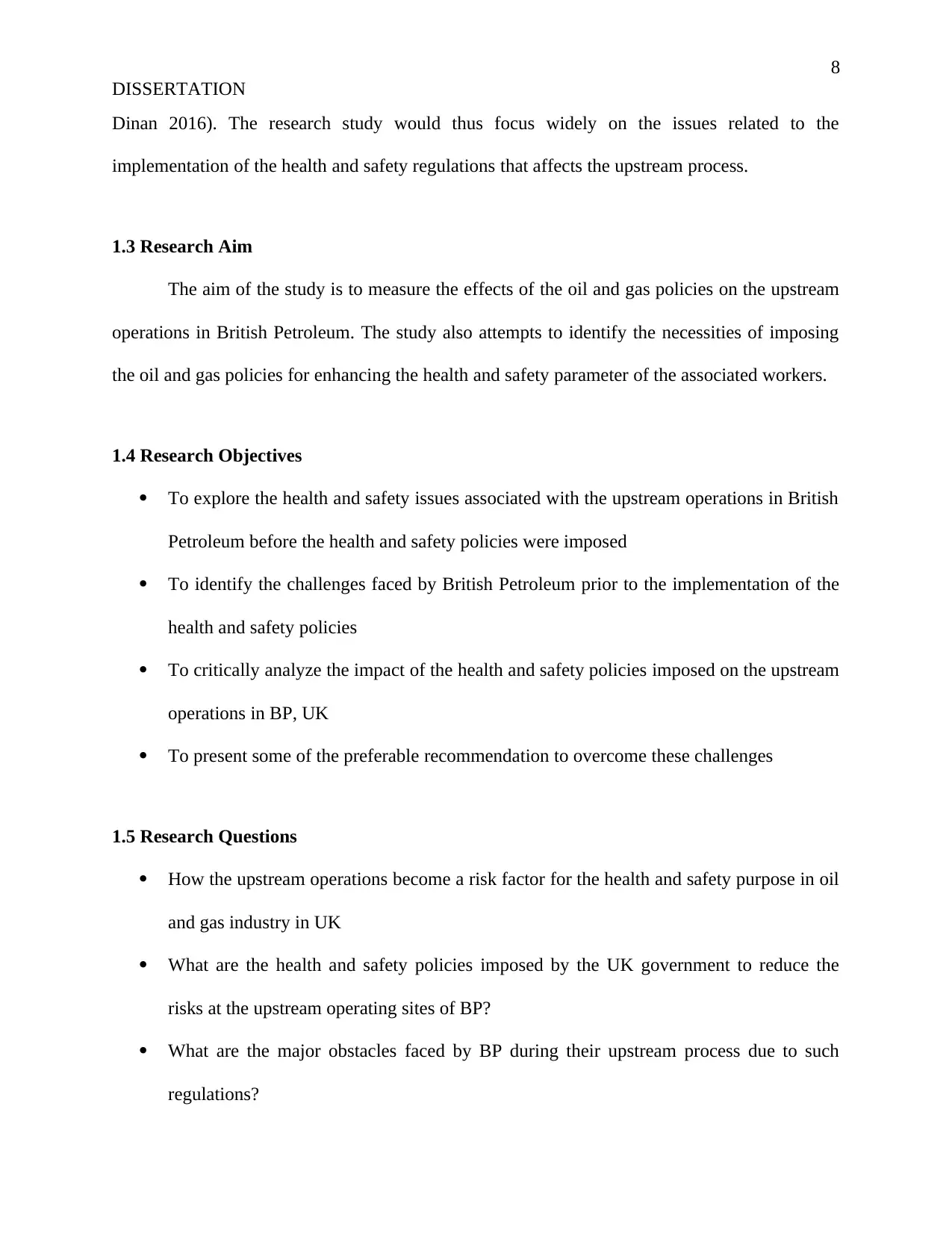
8
DISSERTATION
Dinan 2016). The research study would thus focus widely on the issues related to the
implementation of the health and safety regulations that affects the upstream process.
1.3 Research Aim
The aim of the study is to measure the effects of the oil and gas policies on the upstream
operations in British Petroleum. The study also attempts to identify the necessities of imposing
the oil and gas policies for enhancing the health and safety parameter of the associated workers.
1.4 Research Objectives
To explore the health and safety issues associated with the upstream operations in British
Petroleum before the health and safety policies were imposed
To identify the challenges faced by British Petroleum prior to the implementation of the
health and safety policies
To critically analyze the impact of the health and safety policies imposed on the upstream
operations in BP, UK
To present some of the preferable recommendation to overcome these challenges
1.5 Research Questions
How the upstream operations become a risk factor for the health and safety purpose in oil
and gas industry in UK
What are the health and safety policies imposed by the UK government to reduce the
risks at the upstream operating sites of BP?
What are the major obstacles faced by BP during their upstream process due to such
regulations?
DISSERTATION
Dinan 2016). The research study would thus focus widely on the issues related to the
implementation of the health and safety regulations that affects the upstream process.
1.3 Research Aim
The aim of the study is to measure the effects of the oil and gas policies on the upstream
operations in British Petroleum. The study also attempts to identify the necessities of imposing
the oil and gas policies for enhancing the health and safety parameter of the associated workers.
1.4 Research Objectives
To explore the health and safety issues associated with the upstream operations in British
Petroleum before the health and safety policies were imposed
To identify the challenges faced by British Petroleum prior to the implementation of the
health and safety policies
To critically analyze the impact of the health and safety policies imposed on the upstream
operations in BP, UK
To present some of the preferable recommendation to overcome these challenges
1.5 Research Questions
How the upstream operations become a risk factor for the health and safety purpose in oil
and gas industry in UK
What are the health and safety policies imposed by the UK government to reduce the
risks at the upstream operating sites of BP?
What are the major obstacles faced by BP during their upstream process due to such
regulations?
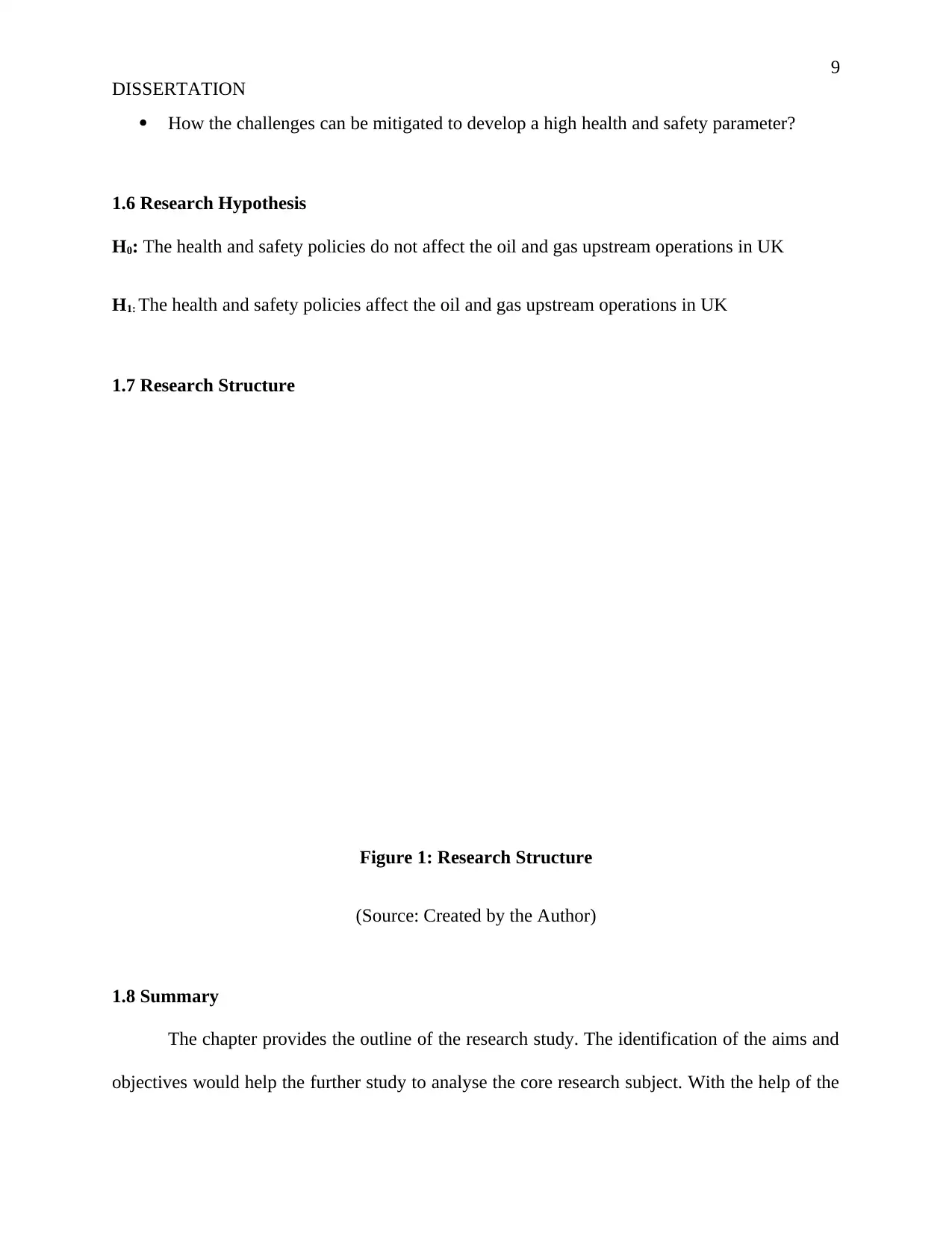
9
DISSERTATION
How the challenges can be mitigated to develop a high health and safety parameter?
1.6 Research Hypothesis
H0: The health and safety policies do not affect the oil and gas upstream operations in UK
H1: The health and safety policies affect the oil and gas upstream operations in UK
1.7 Research Structure
Figure 1: Research Structure
(Source: Created by the Author)
1.8 Summary
The chapter provides the outline of the research study. The identification of the aims and
objectives would help the further study to analyse the core research subject. With the help of the
DISSERTATION
How the challenges can be mitigated to develop a high health and safety parameter?
1.6 Research Hypothesis
H0: The health and safety policies do not affect the oil and gas upstream operations in UK
H1: The health and safety policies affect the oil and gas upstream operations in UK
1.7 Research Structure
Figure 1: Research Structure
(Source: Created by the Author)
1.8 Summary
The chapter provides the outline of the research study. The identification of the aims and
objectives would help the further study to analyse the core research subject. With the help of the
Paraphrase This Document
Need a fresh take? Get an instant paraphrase of this document with our AI Paraphraser
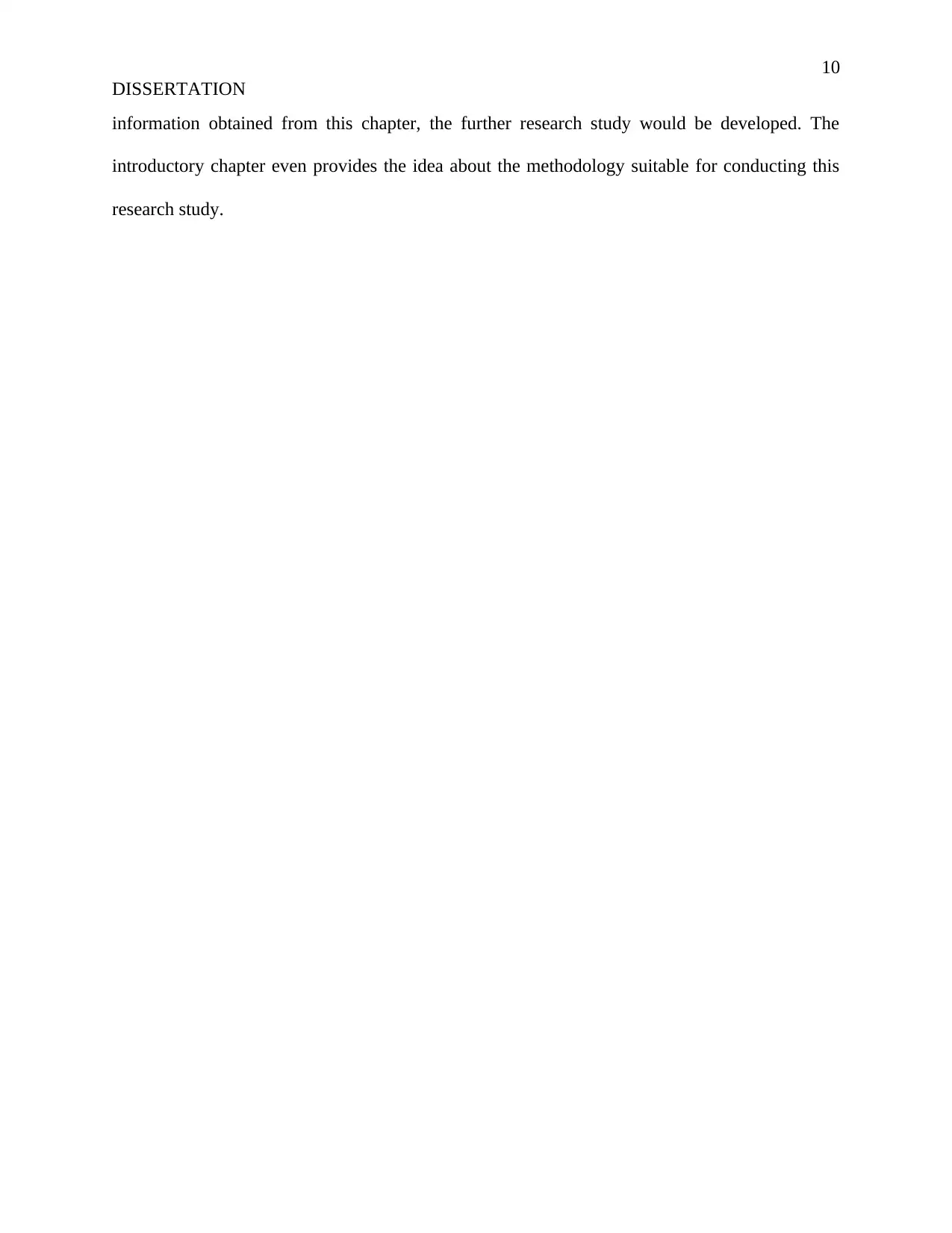
10
DISSERTATION
information obtained from this chapter, the further research study would be developed. The
introductory chapter even provides the idea about the methodology suitable for conducting this
research study.
DISSERTATION
information obtained from this chapter, the further research study would be developed. The
introductory chapter even provides the idea about the methodology suitable for conducting this
research study.
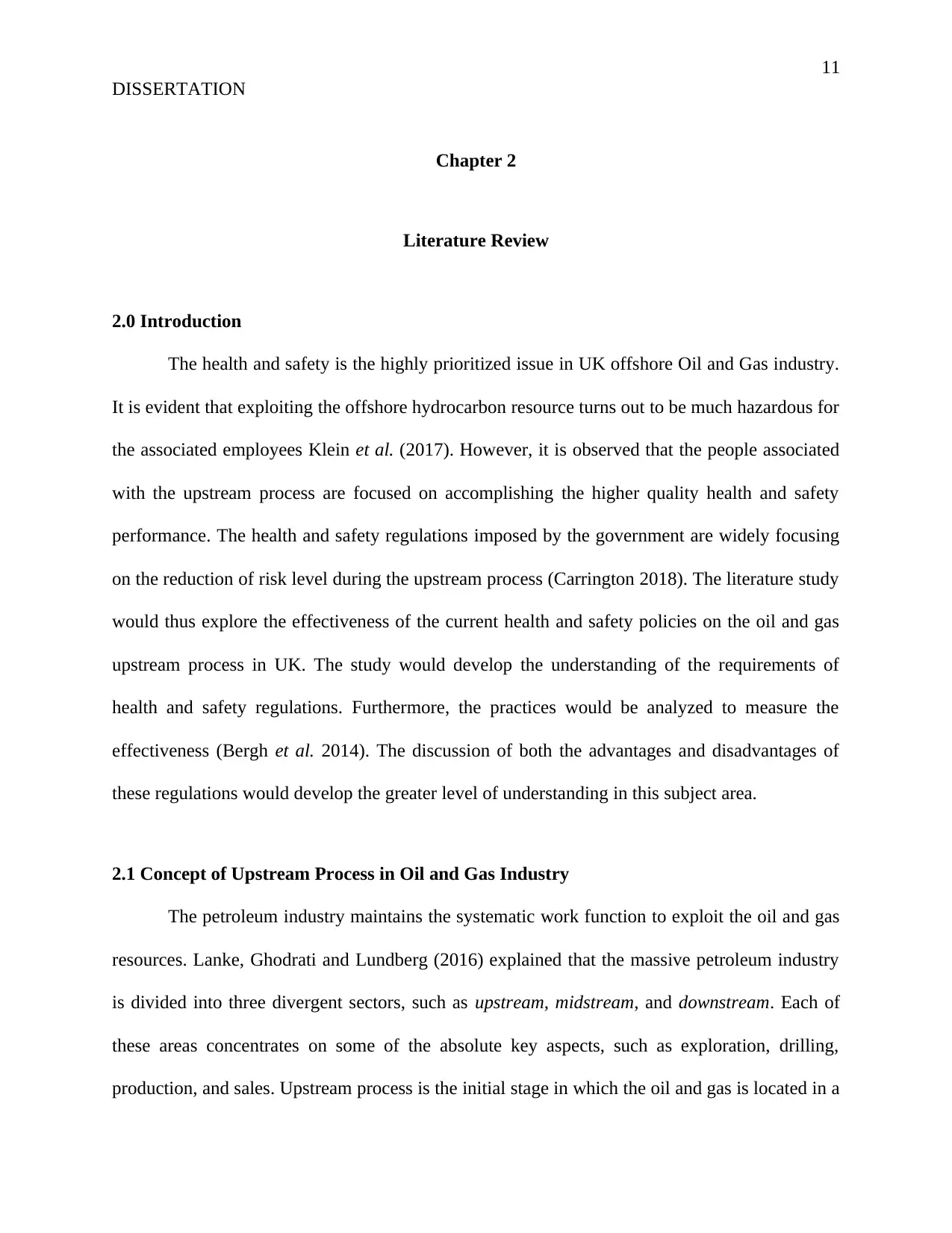
11
DISSERTATION
Chapter 2
Literature Review
2.0 Introduction
The health and safety is the highly prioritized issue in UK offshore Oil and Gas industry.
It is evident that exploiting the offshore hydrocarbon resource turns out to be much hazardous for
the associated employees Klein et al. (2017). However, it is observed that the people associated
with the upstream process are focused on accomplishing the higher quality health and safety
performance. The health and safety regulations imposed by the government are widely focusing
on the reduction of risk level during the upstream process (Carrington 2018). The literature study
would thus explore the effectiveness of the current health and safety policies on the oil and gas
upstream process in UK. The study would develop the understanding of the requirements of
health and safety regulations. Furthermore, the practices would be analyzed to measure the
effectiveness (Bergh et al. 2014). The discussion of both the advantages and disadvantages of
these regulations would develop the greater level of understanding in this subject area.
2.1 Concept of Upstream Process in Oil and Gas Industry
The petroleum industry maintains the systematic work function to exploit the oil and gas
resources. Lanke, Ghodrati and Lundberg (2016) explained that the massive petroleum industry
is divided into three divergent sectors, such as upstream, midstream, and downstream. Each of
these areas concentrates on some of the absolute key aspects, such as exploration, drilling,
production, and sales. Upstream process is the initial stage in which the oil and gas is located in a
DISSERTATION
Chapter 2
Literature Review
2.0 Introduction
The health and safety is the highly prioritized issue in UK offshore Oil and Gas industry.
It is evident that exploiting the offshore hydrocarbon resource turns out to be much hazardous for
the associated employees Klein et al. (2017). However, it is observed that the people associated
with the upstream process are focused on accomplishing the higher quality health and safety
performance. The health and safety regulations imposed by the government are widely focusing
on the reduction of risk level during the upstream process (Carrington 2018). The literature study
would thus explore the effectiveness of the current health and safety policies on the oil and gas
upstream process in UK. The study would develop the understanding of the requirements of
health and safety regulations. Furthermore, the practices would be analyzed to measure the
effectiveness (Bergh et al. 2014). The discussion of both the advantages and disadvantages of
these regulations would develop the greater level of understanding in this subject area.
2.1 Concept of Upstream Process in Oil and Gas Industry
The petroleum industry maintains the systematic work function to exploit the oil and gas
resources. Lanke, Ghodrati and Lundberg (2016) explained that the massive petroleum industry
is divided into three divergent sectors, such as upstream, midstream, and downstream. Each of
these areas concentrates on some of the absolute key aspects, such as exploration, drilling,
production, and sales. Upstream process is the initial stage in which the oil and gas is located in a

12
DISSERTATION
place to extract crude oil and natural gas (Cruz and Krausmann 2013). As per the report
presented by The Petroleum Service Association of Canada, the upstream process is referred to
as exploration and production. It has been observed that the petroleum industry employs the
dynamic group of people in the upstream process (Demski, Poortinga and Pidgeon 2014). People
like geophysicist, geologists, seismic, scientists, service rig operators, drilling contractors, and
engineers are associated in this upstream process. They focus on pinpointing the exact location
of the minerals that are locate underground and estimated the amount of the available reserves
before starting the drilling process. Watterson and Dinan (2016) stated that upstream process is
mainly occupied with the most difficult tasks as the workers need to drill and extract reserved
nature resources. Hence, the workers need to be more cautious while participating in this
process. During the upstream process, both the vibration and noise pose the significant health
risks for the associated members (Dholakia et al. 2015). The workers require using various forms
of radiation and thermal extremes. Due to the exposure to direct sunlight, extreme heat, and
extreme cold in the high altitudes the associated members may face the health risks.
2.2 Challenges faced prior to health and safety policy implementation
The conceptual analysis of the upstream process indicates that the associated workers put
their life at risks. The lack of proper health and safety regulations made the process much
challenging for the associated workers. ALNabhani, Khan and Yang (2016) inferred that the
upstream operation deals with systematic sampling of the hazardous agents that affect the health
of the associated members. It is reported that Benzene is a natural component of natural gas and
crude oil and it is used during the exposure (Fidler and Noble 2012). The substances used during
the drilling process can make the considerable hazards on human health. The previous method of
upstream included the ‘mud’ drilling process that had the considerable toxicity for both the
DISSERTATION
place to extract crude oil and natural gas (Cruz and Krausmann 2013). As per the report
presented by The Petroleum Service Association of Canada, the upstream process is referred to
as exploration and production. It has been observed that the petroleum industry employs the
dynamic group of people in the upstream process (Demski, Poortinga and Pidgeon 2014). People
like geophysicist, geologists, seismic, scientists, service rig operators, drilling contractors, and
engineers are associated in this upstream process. They focus on pinpointing the exact location
of the minerals that are locate underground and estimated the amount of the available reserves
before starting the drilling process. Watterson and Dinan (2016) stated that upstream process is
mainly occupied with the most difficult tasks as the workers need to drill and extract reserved
nature resources. Hence, the workers need to be more cautious while participating in this
process. During the upstream process, both the vibration and noise pose the significant health
risks for the associated members (Dholakia et al. 2015). The workers require using various forms
of radiation and thermal extremes. Due to the exposure to direct sunlight, extreme heat, and
extreme cold in the high altitudes the associated members may face the health risks.
2.2 Challenges faced prior to health and safety policy implementation
The conceptual analysis of the upstream process indicates that the associated workers put
their life at risks. The lack of proper health and safety regulations made the process much
challenging for the associated workers. ALNabhani, Khan and Yang (2016) inferred that the
upstream operation deals with systematic sampling of the hazardous agents that affect the health
of the associated members. It is reported that Benzene is a natural component of natural gas and
crude oil and it is used during the exposure (Fidler and Noble 2012). The substances used during
the drilling process can make the considerable hazards on human health. The previous method of
upstream included the ‘mud’ drilling process that had the considerable toxicity for both the
Secure Best Marks with AI Grader
Need help grading? Try our AI Grader for instant feedback on your assignments.
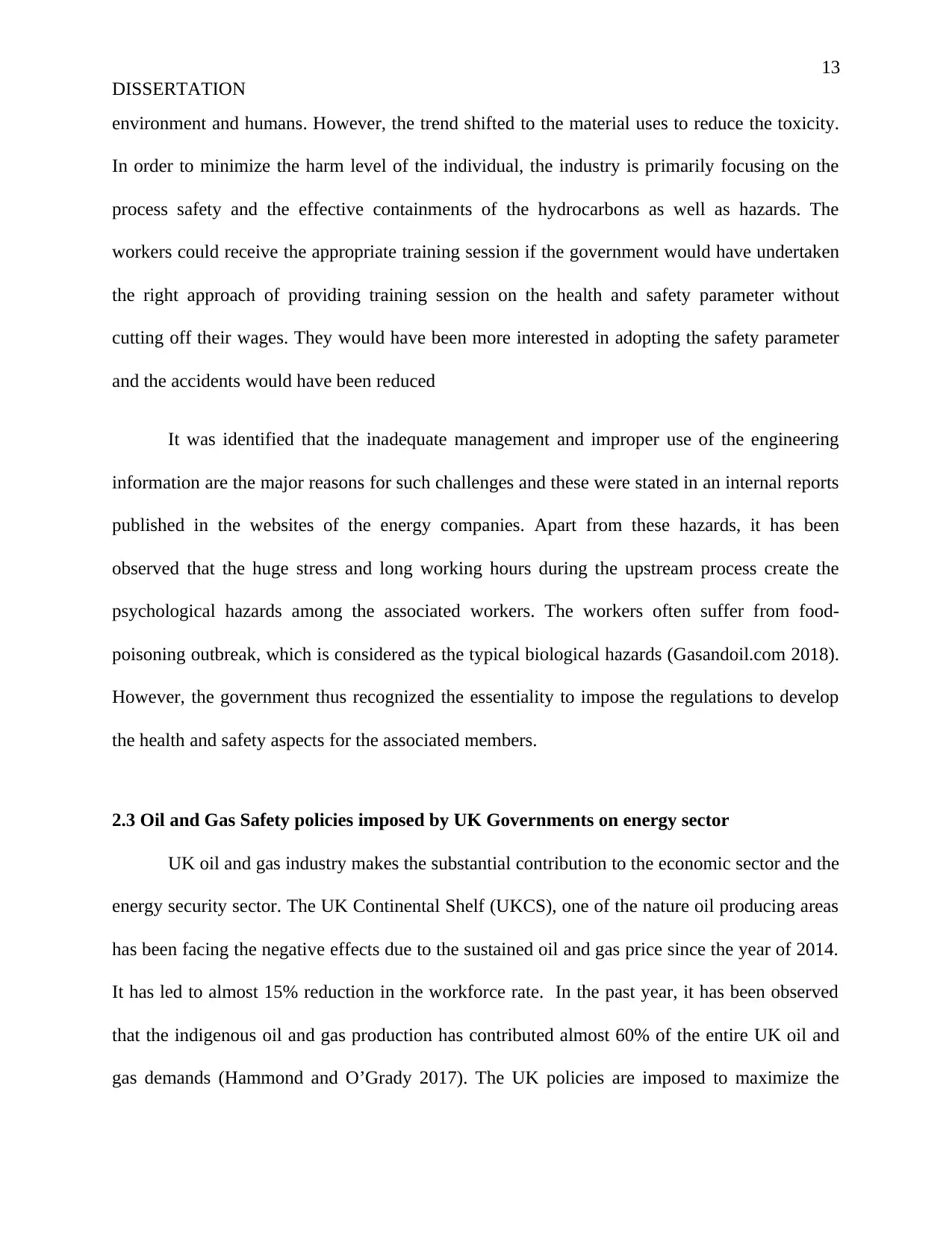
13
DISSERTATION
environment and humans. However, the trend shifted to the material uses to reduce the toxicity.
In order to minimize the harm level of the individual, the industry is primarily focusing on the
process safety and the effective containments of the hydrocarbons as well as hazards. The
workers could receive the appropriate training session if the government would have undertaken
the right approach of providing training session on the health and safety parameter without
cutting off their wages. They would have been more interested in adopting the safety parameter
and the accidents would have been reduced
It was identified that the inadequate management and improper use of the engineering
information are the major reasons for such challenges and these were stated in an internal reports
published in the websites of the energy companies. Apart from these hazards, it has been
observed that the huge stress and long working hours during the upstream process create the
psychological hazards among the associated workers. The workers often suffer from food-
poisoning outbreak, which is considered as the typical biological hazards (Gasandoil.com 2018).
However, the government thus recognized the essentiality to impose the regulations to develop
the health and safety aspects for the associated members.
2.3 Oil and Gas Safety policies imposed by UK Governments on energy sector
UK oil and gas industry makes the substantial contribution to the economic sector and the
energy security sector. The UK Continental Shelf (UKCS), one of the nature oil producing areas
has been facing the negative effects due to the sustained oil and gas price since the year of 2014.
It has led to almost 15% reduction in the workforce rate. In the past year, it has been observed
that the indigenous oil and gas production has contributed almost 60% of the entire UK oil and
gas demands (Hammond and O’Grady 2017). The UK policies are imposed to maximize the
DISSERTATION
environment and humans. However, the trend shifted to the material uses to reduce the toxicity.
In order to minimize the harm level of the individual, the industry is primarily focusing on the
process safety and the effective containments of the hydrocarbons as well as hazards. The
workers could receive the appropriate training session if the government would have undertaken
the right approach of providing training session on the health and safety parameter without
cutting off their wages. They would have been more interested in adopting the safety parameter
and the accidents would have been reduced
It was identified that the inadequate management and improper use of the engineering
information are the major reasons for such challenges and these were stated in an internal reports
published in the websites of the energy companies. Apart from these hazards, it has been
observed that the huge stress and long working hours during the upstream process create the
psychological hazards among the associated workers. The workers often suffer from food-
poisoning outbreak, which is considered as the typical biological hazards (Gasandoil.com 2018).
However, the government thus recognized the essentiality to impose the regulations to develop
the health and safety aspects for the associated members.
2.3 Oil and Gas Safety policies imposed by UK Governments on energy sector
UK oil and gas industry makes the substantial contribution to the economic sector and the
energy security sector. The UK Continental Shelf (UKCS), one of the nature oil producing areas
has been facing the negative effects due to the sustained oil and gas price since the year of 2014.
It has led to almost 15% reduction in the workforce rate. In the past year, it has been observed
that the indigenous oil and gas production has contributed almost 60% of the entire UK oil and
gas demands (Hammond and O’Grady 2017). The UK policies are imposed to maximize the

14
DISSERTATION
cost-effective recovery of the natural resources in UK. In order to provide the responses
regarding the declines in the production from the UKCS, the government commissions of UK
has provided a review of the UK offshore oil and gas. The final report of UKCS Maximizing
Recovery Review was published in 2014. It provided the formal responses to the Wood Review
and set out the proposals for implementing the recommendations. The regulations are imposed
on following sectors:
Oil and gas exploration and production
Oil and gas wells and fields
Oil and as licensing
Oil and gas infrastructure
Carbon storage licensing
The Department for BEIS (Business Energy and Industrial Strategy) is responsible for
imposing regulations on climate change and energy settings (Cotton, Rattle and Van Alstine
2014). The regulations inn petroleum licensing and upstream oil and gas industry concentrates on
following aspects:
Decommissioning of the installations in offshore oil and gas pipelines
Enforcements of the environmental legislations in terms of applying to the upstream
activities of oil and gas sector.
The state secretary takes the responsibility of the BEIS business and the associated policies.
Under the Petroleum Act 1998 and other related legislations, a number of the energy powers are
transferred. EA or the Environmental Agency is the environmental regulators for the onshore oil
and gas activities that include coal bed methane, shale gas, and underground coal gasification.
DISSERTATION
cost-effective recovery of the natural resources in UK. In order to provide the responses
regarding the declines in the production from the UKCS, the government commissions of UK
has provided a review of the UK offshore oil and gas. The final report of UKCS Maximizing
Recovery Review was published in 2014. It provided the formal responses to the Wood Review
and set out the proposals for implementing the recommendations. The regulations are imposed
on following sectors:
Oil and gas exploration and production
Oil and gas wells and fields
Oil and as licensing
Oil and gas infrastructure
Carbon storage licensing
The Department for BEIS (Business Energy and Industrial Strategy) is responsible for
imposing regulations on climate change and energy settings (Cotton, Rattle and Van Alstine
2014). The regulations inn petroleum licensing and upstream oil and gas industry concentrates on
following aspects:
Decommissioning of the installations in offshore oil and gas pipelines
Enforcements of the environmental legislations in terms of applying to the upstream
activities of oil and gas sector.
The state secretary takes the responsibility of the BEIS business and the associated policies.
Under the Petroleum Act 1998 and other related legislations, a number of the energy powers are
transferred. EA or the Environmental Agency is the environmental regulators for the onshore oil
and gas activities that include coal bed methane, shale gas, and underground coal gasification.
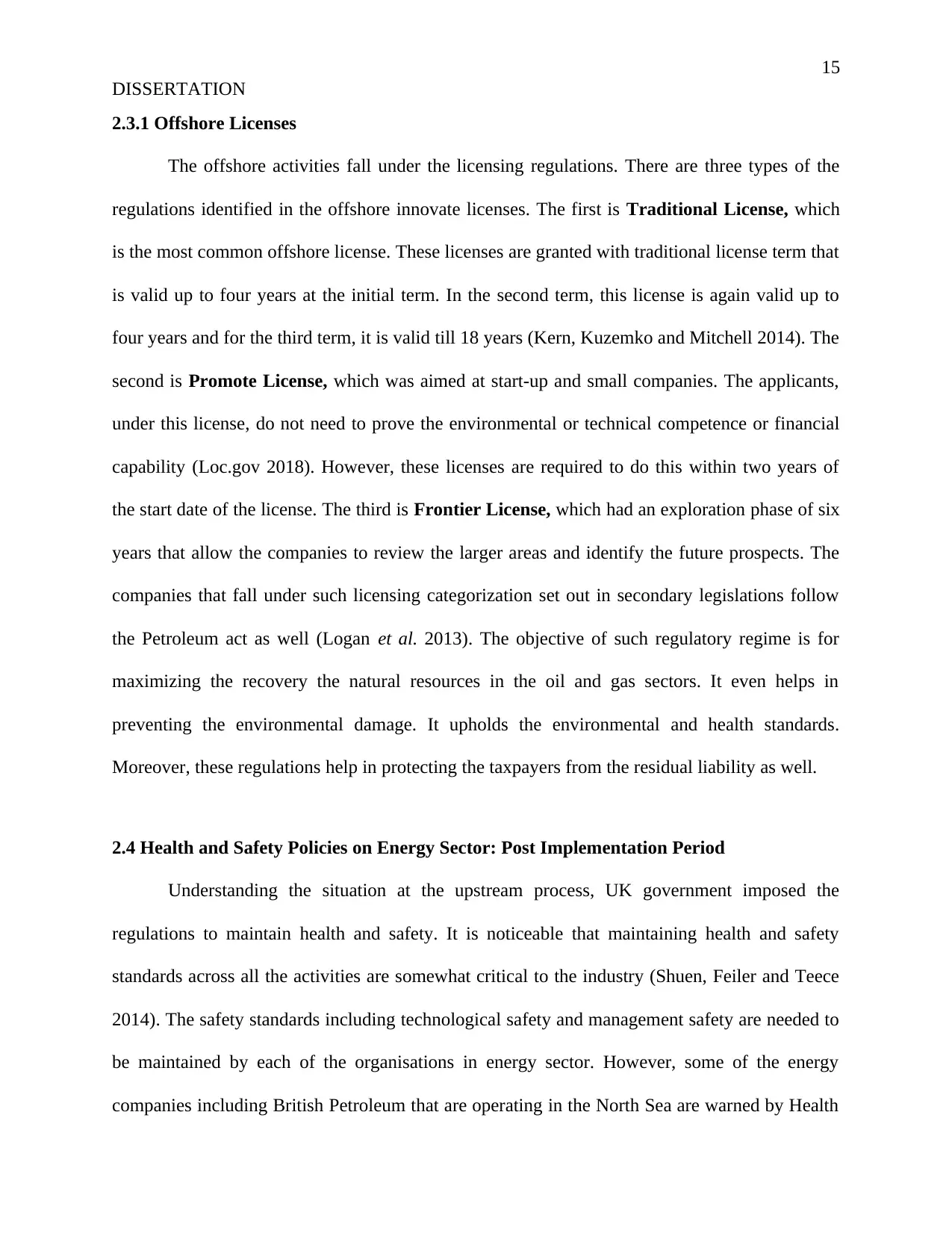
15
DISSERTATION
2.3.1 Offshore Licenses
The offshore activities fall under the licensing regulations. There are three types of the
regulations identified in the offshore innovate licenses. The first is Traditional License, which
is the most common offshore license. These licenses are granted with traditional license term that
is valid up to four years at the initial term. In the second term, this license is again valid up to
four years and for the third term, it is valid till 18 years (Kern, Kuzemko and Mitchell 2014). The
second is Promote License, which was aimed at start-up and small companies. The applicants,
under this license, do not need to prove the environmental or technical competence or financial
capability (Loc.gov 2018). However, these licenses are required to do this within two years of
the start date of the license. The third is Frontier License, which had an exploration phase of six
years that allow the companies to review the larger areas and identify the future prospects. The
companies that fall under such licensing categorization set out in secondary legislations follow
the Petroleum act as well (Logan et al. 2013). The objective of such regulatory regime is for
maximizing the recovery the natural resources in the oil and gas sectors. It even helps in
preventing the environmental damage. It upholds the environmental and health standards.
Moreover, these regulations help in protecting the taxpayers from the residual liability as well.
2.4 Health and Safety Policies on Energy Sector: Post Implementation Period
Understanding the situation at the upstream process, UK government imposed the
regulations to maintain health and safety. It is noticeable that maintaining health and safety
standards across all the activities are somewhat critical to the industry (Shuen, Feiler and Teece
2014). The safety standards including technological safety and management safety are needed to
be maintained by each of the organisations in energy sector. However, some of the energy
companies including British Petroleum that are operating in the North Sea are warned by Health
DISSERTATION
2.3.1 Offshore Licenses
The offshore activities fall under the licensing regulations. There are three types of the
regulations identified in the offshore innovate licenses. The first is Traditional License, which
is the most common offshore license. These licenses are granted with traditional license term that
is valid up to four years at the initial term. In the second term, this license is again valid up to
four years and for the third term, it is valid till 18 years (Kern, Kuzemko and Mitchell 2014). The
second is Promote License, which was aimed at start-up and small companies. The applicants,
under this license, do not need to prove the environmental or technical competence or financial
capability (Loc.gov 2018). However, these licenses are required to do this within two years of
the start date of the license. The third is Frontier License, which had an exploration phase of six
years that allow the companies to review the larger areas and identify the future prospects. The
companies that fall under such licensing categorization set out in secondary legislations follow
the Petroleum act as well (Logan et al. 2013). The objective of such regulatory regime is for
maximizing the recovery the natural resources in the oil and gas sectors. It even helps in
preventing the environmental damage. It upholds the environmental and health standards.
Moreover, these regulations help in protecting the taxpayers from the residual liability as well.
2.4 Health and Safety Policies on Energy Sector: Post Implementation Period
Understanding the situation at the upstream process, UK government imposed the
regulations to maintain health and safety. It is noticeable that maintaining health and safety
standards across all the activities are somewhat critical to the industry (Shuen, Feiler and Teece
2014). The safety standards including technological safety and management safety are needed to
be maintained by each of the organisations in energy sector. However, some of the energy
companies including British Petroleum that are operating in the North Sea are warned by Health
Paraphrase This Document
Need a fresh take? Get an instant paraphrase of this document with our AI Paraphraser
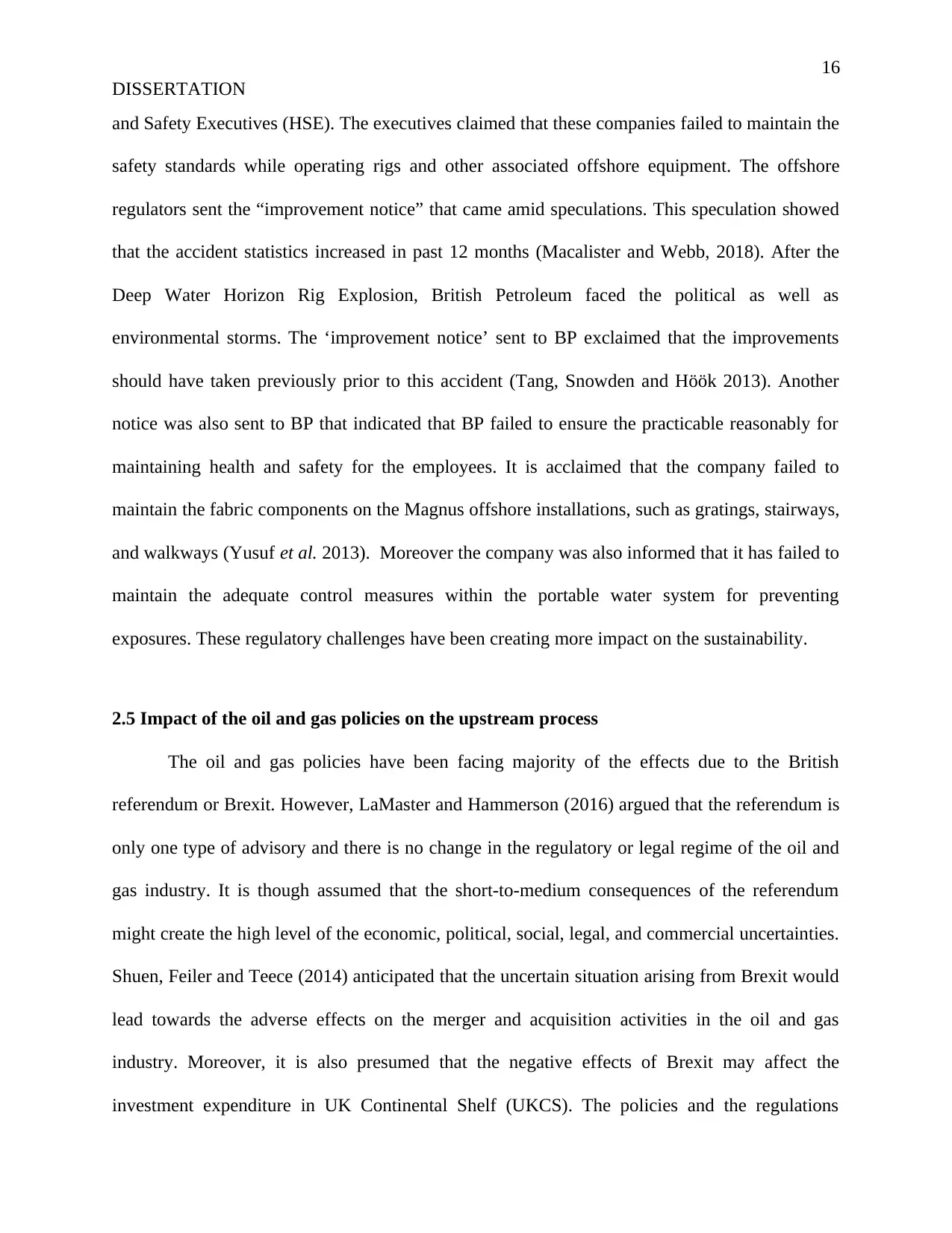
16
DISSERTATION
and Safety Executives (HSE). The executives claimed that these companies failed to maintain the
safety standards while operating rigs and other associated offshore equipment. The offshore
regulators sent the “improvement notice” that came amid speculations. This speculation showed
that the accident statistics increased in past 12 months (Macalister and Webb, 2018). After the
Deep Water Horizon Rig Explosion, British Petroleum faced the political as well as
environmental storms. The ‘improvement notice’ sent to BP exclaimed that the improvements
should have taken previously prior to this accident (Tang, Snowden and Höök 2013). Another
notice was also sent to BP that indicated that BP failed to ensure the practicable reasonably for
maintaining health and safety for the employees. It is acclaimed that the company failed to
maintain the fabric components on the Magnus offshore installations, such as gratings, stairways,
and walkways (Yusuf et al. 2013). Moreover the company was also informed that it has failed to
maintain the adequate control measures within the portable water system for preventing
exposures. These regulatory challenges have been creating more impact on the sustainability.
2.5 Impact of the oil and gas policies on the upstream process
The oil and gas policies have been facing majority of the effects due to the British
referendum or Brexit. However, LaMaster and Hammerson (2016) argued that the referendum is
only one type of advisory and there is no change in the regulatory or legal regime of the oil and
gas industry. It is though assumed that the short-to-medium consequences of the referendum
might create the high level of the economic, political, social, legal, and commercial uncertainties.
Shuen, Feiler and Teece (2014) anticipated that the uncertain situation arising from Brexit would
lead towards the adverse effects on the merger and acquisition activities in the oil and gas
industry. Moreover, it is also presumed that the negative effects of Brexit may affect the
investment expenditure in UK Continental Shelf (UKCS). The policies and the regulations
DISSERTATION
and Safety Executives (HSE). The executives claimed that these companies failed to maintain the
safety standards while operating rigs and other associated offshore equipment. The offshore
regulators sent the “improvement notice” that came amid speculations. This speculation showed
that the accident statistics increased in past 12 months (Macalister and Webb, 2018). After the
Deep Water Horizon Rig Explosion, British Petroleum faced the political as well as
environmental storms. The ‘improvement notice’ sent to BP exclaimed that the improvements
should have taken previously prior to this accident (Tang, Snowden and Höök 2013). Another
notice was also sent to BP that indicated that BP failed to ensure the practicable reasonably for
maintaining health and safety for the employees. It is acclaimed that the company failed to
maintain the fabric components on the Magnus offshore installations, such as gratings, stairways,
and walkways (Yusuf et al. 2013). Moreover the company was also informed that it has failed to
maintain the adequate control measures within the portable water system for preventing
exposures. These regulatory challenges have been creating more impact on the sustainability.
2.5 Impact of the oil and gas policies on the upstream process
The oil and gas policies have been facing majority of the effects due to the British
referendum or Brexit. However, LaMaster and Hammerson (2016) argued that the referendum is
only one type of advisory and there is no change in the regulatory or legal regime of the oil and
gas industry. It is though assumed that the short-to-medium consequences of the referendum
might create the high level of the economic, political, social, legal, and commercial uncertainties.
Shuen, Feiler and Teece (2014) anticipated that the uncertain situation arising from Brexit would
lead towards the adverse effects on the merger and acquisition activities in the oil and gas
industry. Moreover, it is also presumed that the negative effects of Brexit may affect the
investment expenditure in UK Continental Shelf (UKCS). The policies and the regulations
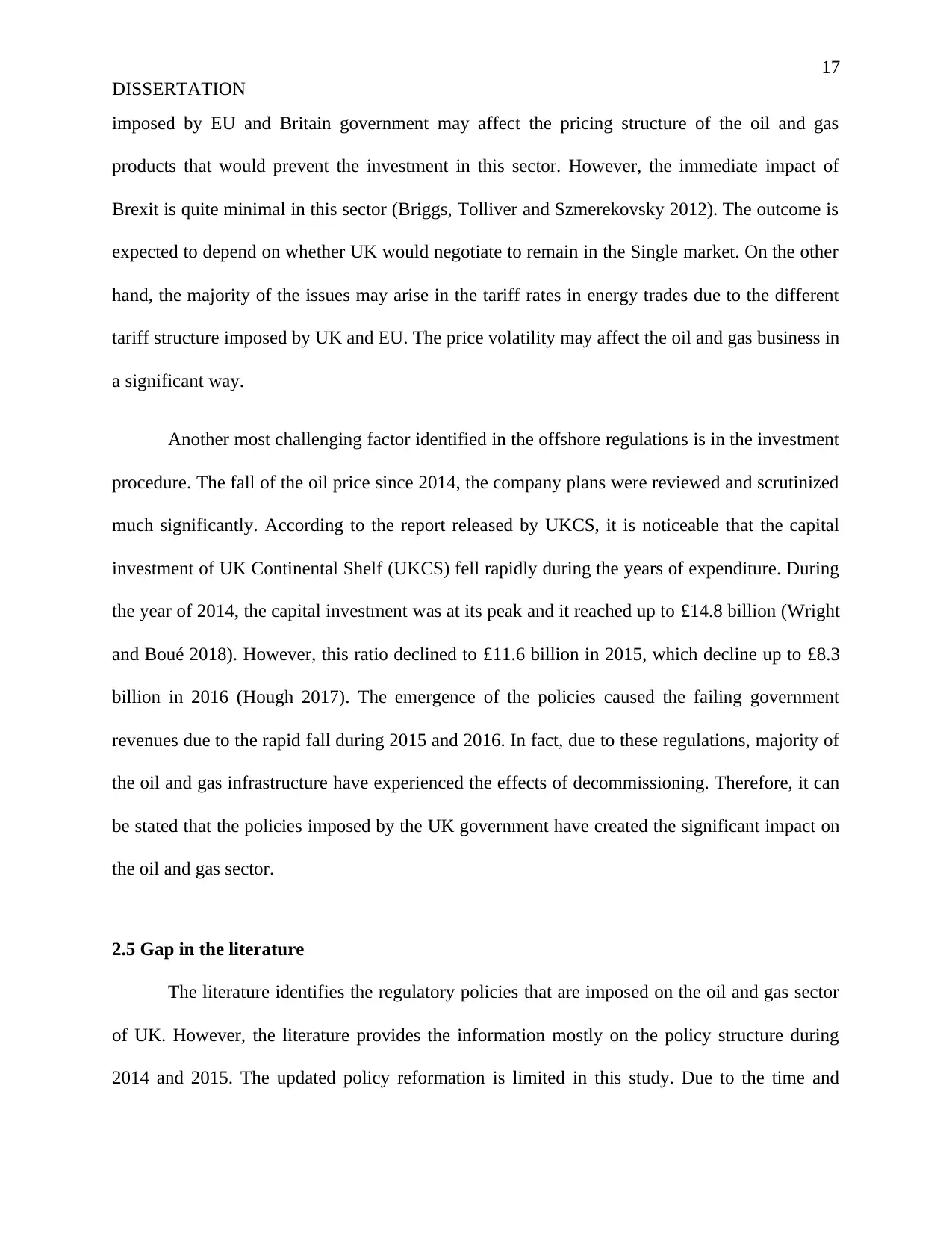
17
DISSERTATION
imposed by EU and Britain government may affect the pricing structure of the oil and gas
products that would prevent the investment in this sector. However, the immediate impact of
Brexit is quite minimal in this sector (Briggs, Tolliver and Szmerekovsky 2012). The outcome is
expected to depend on whether UK would negotiate to remain in the Single market. On the other
hand, the majority of the issues may arise in the tariff rates in energy trades due to the different
tariff structure imposed by UK and EU. The price volatility may affect the oil and gas business in
a significant way.
Another most challenging factor identified in the offshore regulations is in the investment
procedure. The fall of the oil price since 2014, the company plans were reviewed and scrutinized
much significantly. According to the report released by UKCS, it is noticeable that the capital
investment of UK Continental Shelf (UKCS) fell rapidly during the years of expenditure. During
the year of 2014, the capital investment was at its peak and it reached up to £14.8 billion (Wright
and Boué 2018). However, this ratio declined to £11.6 billion in 2015, which decline up to £8.3
billion in 2016 (Hough 2017). The emergence of the policies caused the failing government
revenues due to the rapid fall during 2015 and 2016. In fact, due to these regulations, majority of
the oil and gas infrastructure have experienced the effects of decommissioning. Therefore, it can
be stated that the policies imposed by the UK government have created the significant impact on
the oil and gas sector.
2.5 Gap in the literature
The literature identifies the regulatory policies that are imposed on the oil and gas sector
of UK. However, the literature provides the information mostly on the policy structure during
2014 and 2015. The updated policy reformation is limited in this study. Due to the time and
DISSERTATION
imposed by EU and Britain government may affect the pricing structure of the oil and gas
products that would prevent the investment in this sector. However, the immediate impact of
Brexit is quite minimal in this sector (Briggs, Tolliver and Szmerekovsky 2012). The outcome is
expected to depend on whether UK would negotiate to remain in the Single market. On the other
hand, the majority of the issues may arise in the tariff rates in energy trades due to the different
tariff structure imposed by UK and EU. The price volatility may affect the oil and gas business in
a significant way.
Another most challenging factor identified in the offshore regulations is in the investment
procedure. The fall of the oil price since 2014, the company plans were reviewed and scrutinized
much significantly. According to the report released by UKCS, it is noticeable that the capital
investment of UK Continental Shelf (UKCS) fell rapidly during the years of expenditure. During
the year of 2014, the capital investment was at its peak and it reached up to £14.8 billion (Wright
and Boué 2018). However, this ratio declined to £11.6 billion in 2015, which decline up to £8.3
billion in 2016 (Hough 2017). The emergence of the policies caused the failing government
revenues due to the rapid fall during 2015 and 2016. In fact, due to these regulations, majority of
the oil and gas infrastructure have experienced the effects of decommissioning. Therefore, it can
be stated that the policies imposed by the UK government have created the significant impact on
the oil and gas sector.
2.5 Gap in the literature
The literature identifies the regulatory policies that are imposed on the oil and gas sector
of UK. However, the literature provides the information mostly on the policy structure during
2014 and 2015. The updated policy reformation is limited in this study. Due to the time and
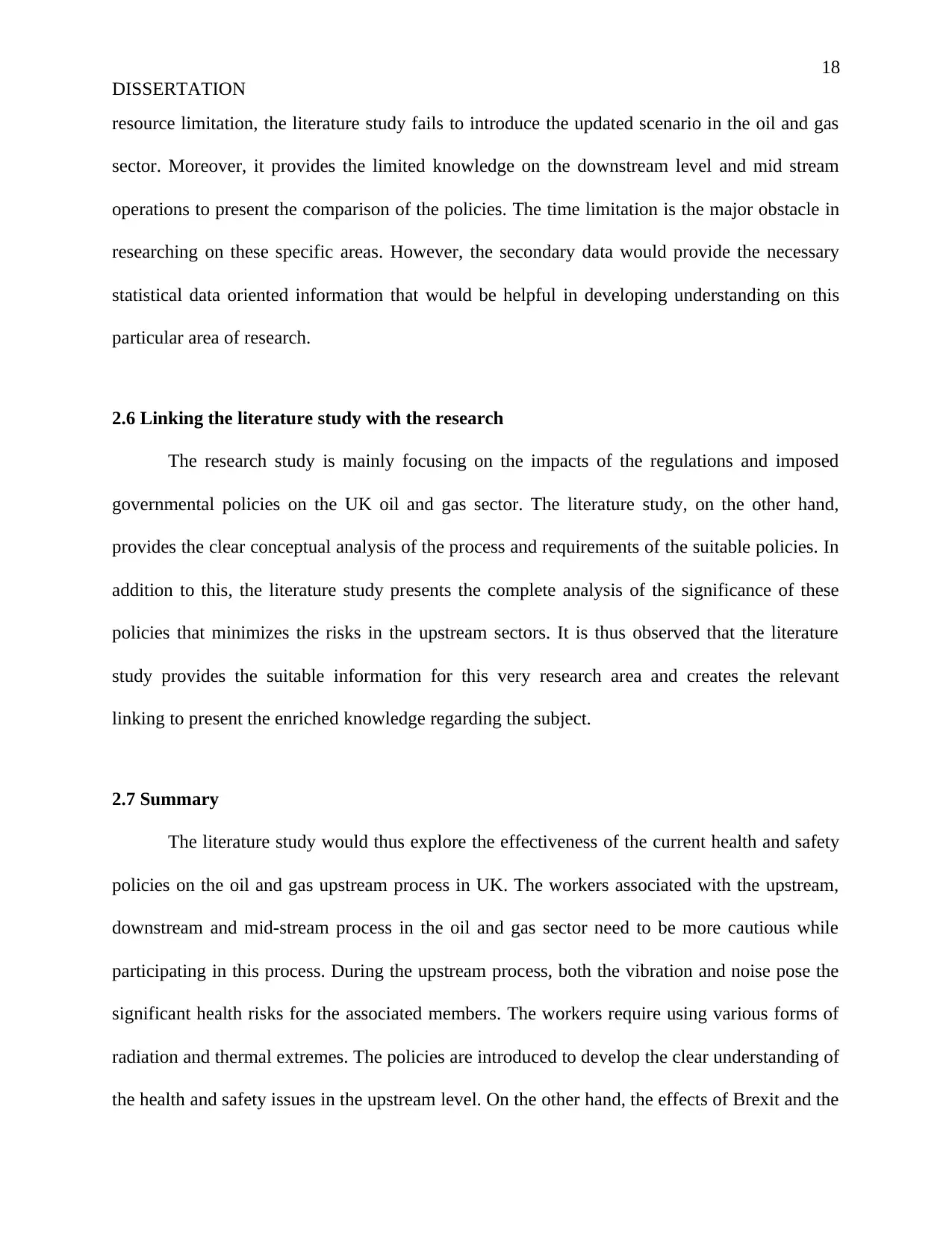
18
DISSERTATION
resource limitation, the literature study fails to introduce the updated scenario in the oil and gas
sector. Moreover, it provides the limited knowledge on the downstream level and mid stream
operations to present the comparison of the policies. The time limitation is the major obstacle in
researching on these specific areas. However, the secondary data would provide the necessary
statistical data oriented information that would be helpful in developing understanding on this
particular area of research.
2.6 Linking the literature study with the research
The research study is mainly focusing on the impacts of the regulations and imposed
governmental policies on the UK oil and gas sector. The literature study, on the other hand,
provides the clear conceptual analysis of the process and requirements of the suitable policies. In
addition to this, the literature study presents the complete analysis of the significance of these
policies that minimizes the risks in the upstream sectors. It is thus observed that the literature
study provides the suitable information for this very research area and creates the relevant
linking to present the enriched knowledge regarding the subject.
2.7 Summary
The literature study would thus explore the effectiveness of the current health and safety
policies on the oil and gas upstream process in UK. The workers associated with the upstream,
downstream and mid-stream process in the oil and gas sector need to be more cautious while
participating in this process. During the upstream process, both the vibration and noise pose the
significant health risks for the associated members. The workers require using various forms of
radiation and thermal extremes. The policies are introduced to develop the clear understanding of
the health and safety issues in the upstream level. On the other hand, the effects of Brexit and the
DISSERTATION
resource limitation, the literature study fails to introduce the updated scenario in the oil and gas
sector. Moreover, it provides the limited knowledge on the downstream level and mid stream
operations to present the comparison of the policies. The time limitation is the major obstacle in
researching on these specific areas. However, the secondary data would provide the necessary
statistical data oriented information that would be helpful in developing understanding on this
particular area of research.
2.6 Linking the literature study with the research
The research study is mainly focusing on the impacts of the regulations and imposed
governmental policies on the UK oil and gas sector. The literature study, on the other hand,
provides the clear conceptual analysis of the process and requirements of the suitable policies. In
addition to this, the literature study presents the complete analysis of the significance of these
policies that minimizes the risks in the upstream sectors. It is thus observed that the literature
study provides the suitable information for this very research area and creates the relevant
linking to present the enriched knowledge regarding the subject.
2.7 Summary
The literature study would thus explore the effectiveness of the current health and safety
policies on the oil and gas upstream process in UK. The workers associated with the upstream,
downstream and mid-stream process in the oil and gas sector need to be more cautious while
participating in this process. During the upstream process, both the vibration and noise pose the
significant health risks for the associated members. The workers require using various forms of
radiation and thermal extremes. The policies are introduced to develop the clear understanding of
the health and safety issues in the upstream level. On the other hand, the effects of Brexit and the
Secure Best Marks with AI Grader
Need help grading? Try our AI Grader for instant feedback on your assignments.

19
DISSERTATION
regulations imposed by the government provide the clear analysis of the impacts created on this
sector. The information obtained from this literature study would be linked with the information
gathered in the secondary analysis and would present the clear understanding on this specific
subject area.
DISSERTATION
regulations imposed by the government provide the clear analysis of the impacts created on this
sector. The information obtained from this literature study would be linked with the information
gathered in the secondary analysis and would present the clear understanding on this specific
subject area.
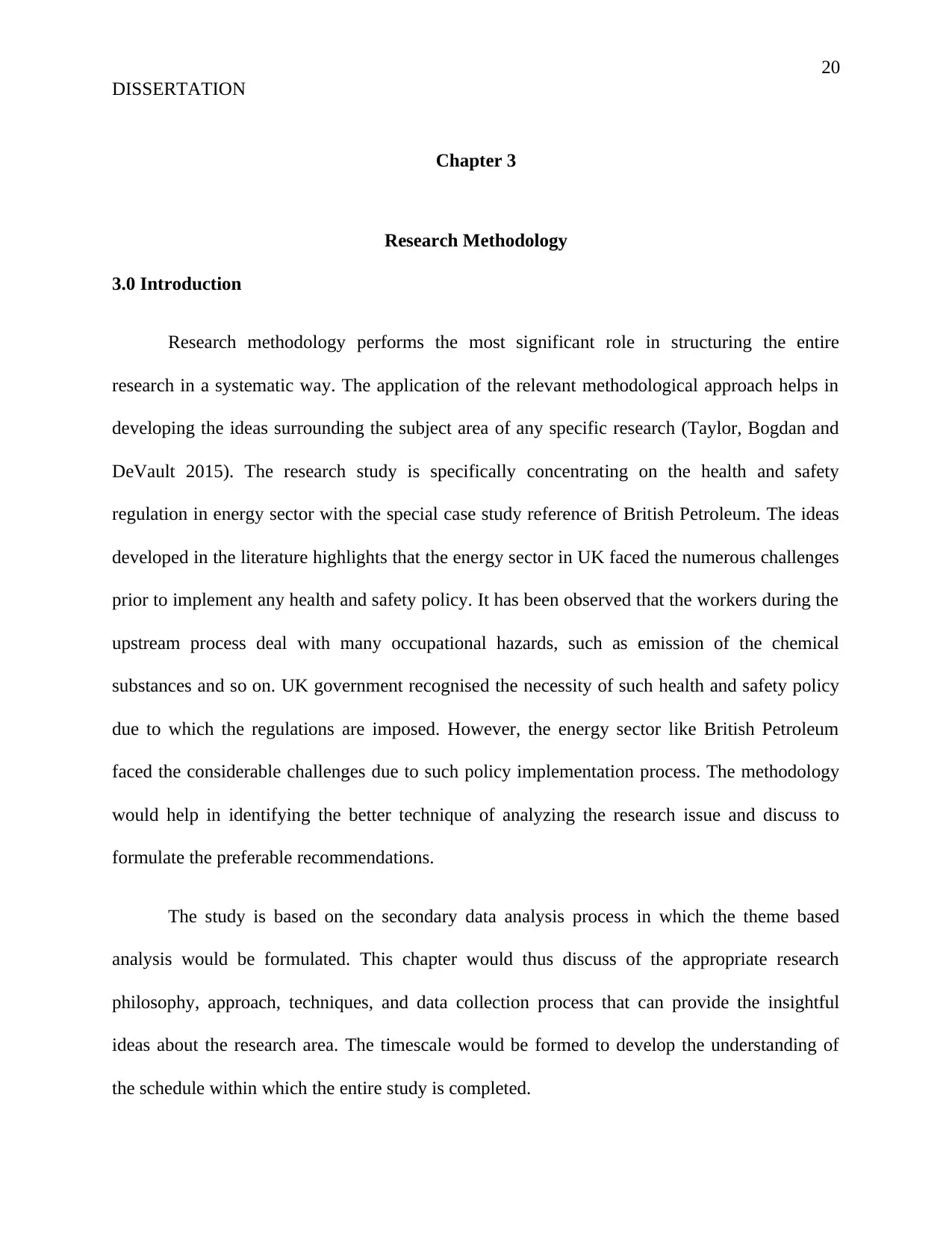
20
DISSERTATION
Chapter 3
Research Methodology
3.0 Introduction
Research methodology performs the most significant role in structuring the entire
research in a systematic way. The application of the relevant methodological approach helps in
developing the ideas surrounding the subject area of any specific research (Taylor, Bogdan and
DeVault 2015). The research study is specifically concentrating on the health and safety
regulation in energy sector with the special case study reference of British Petroleum. The ideas
developed in the literature highlights that the energy sector in UK faced the numerous challenges
prior to implement any health and safety policy. It has been observed that the workers during the
upstream process deal with many occupational hazards, such as emission of the chemical
substances and so on. UK government recognised the necessity of such health and safety policy
due to which the regulations are imposed. However, the energy sector like British Petroleum
faced the considerable challenges due to such policy implementation process. The methodology
would help in identifying the better technique of analyzing the research issue and discuss to
formulate the preferable recommendations.
The study is based on the secondary data analysis process in which the theme based
analysis would be formulated. This chapter would thus discuss of the appropriate research
philosophy, approach, techniques, and data collection process that can provide the insightful
ideas about the research area. The timescale would be formed to develop the understanding of
the schedule within which the entire study is completed.
DISSERTATION
Chapter 3
Research Methodology
3.0 Introduction
Research methodology performs the most significant role in structuring the entire
research in a systematic way. The application of the relevant methodological approach helps in
developing the ideas surrounding the subject area of any specific research (Taylor, Bogdan and
DeVault 2015). The research study is specifically concentrating on the health and safety
regulation in energy sector with the special case study reference of British Petroleum. The ideas
developed in the literature highlights that the energy sector in UK faced the numerous challenges
prior to implement any health and safety policy. It has been observed that the workers during the
upstream process deal with many occupational hazards, such as emission of the chemical
substances and so on. UK government recognised the necessity of such health and safety policy
due to which the regulations are imposed. However, the energy sector like British Petroleum
faced the considerable challenges due to such policy implementation process. The methodology
would help in identifying the better technique of analyzing the research issue and discuss to
formulate the preferable recommendations.
The study is based on the secondary data analysis process in which the theme based
analysis would be formulated. This chapter would thus discuss of the appropriate research
philosophy, approach, techniques, and data collection process that can provide the insightful
ideas about the research area. The timescale would be formed to develop the understanding of
the schedule within which the entire study is completed.

21
DISSERTATION
3.1 Research Philosophy
The research philosophy provides the clear ideas about the selection of the appropriate
techniques of analyzing data. Research philosophy is categorized into three forms, such as
realism, positivism, and interpretivism (Lewis 2015). Realism and Positivism philosophies deal
with the extraction of the exact truth behind the research issues and present in a concise way. On
the other hand, the interpretivism philosophy deals with the human interpretation and identifies a
broader aspect of the research by gathering the information from diverse sources (Flick 2015).
The study has utilized the interpretivism philosophy in this research to analyse the secondary
data.
In case of the secondary researches, it is essential to gather the suitable information
related to the research subject and interpret by using the psychological insights. It is noticeable
that the study would gather the information from diverse secondary sources for understanding
the issues emerge due to the implementation of health and safety policy in the energy sector.
Interpretivism philosophy is quite significant in using the psychological interpretation by
gathering data from various secondary sources. Therefore, the use of the interpretivism
philosophy in this study is quite justified.
3.2 Research Approach
Research approach infers the appropriate utilization of either the hypothetical theory or
existing theory to analyse the subject area. It is characterized into two sections, such as
deductive approach and inductive approach (Smith 2015). The deductive approach deals with
the information gathered from the existing theory based on the subject matter. On the other hand,
the inductive approach presents the idea of formulating the hypothetical values to understand the
DISSERTATION
3.1 Research Philosophy
The research philosophy provides the clear ideas about the selection of the appropriate
techniques of analyzing data. Research philosophy is categorized into three forms, such as
realism, positivism, and interpretivism (Lewis 2015). Realism and Positivism philosophies deal
with the extraction of the exact truth behind the research issues and present in a concise way. On
the other hand, the interpretivism philosophy deals with the human interpretation and identifies a
broader aspect of the research by gathering the information from diverse sources (Flick 2015).
The study has utilized the interpretivism philosophy in this research to analyse the secondary
data.
In case of the secondary researches, it is essential to gather the suitable information
related to the research subject and interpret by using the psychological insights. It is noticeable
that the study would gather the information from diverse secondary sources for understanding
the issues emerge due to the implementation of health and safety policy in the energy sector.
Interpretivism philosophy is quite significant in using the psychological interpretation by
gathering data from various secondary sources. Therefore, the use of the interpretivism
philosophy in this study is quite justified.
3.2 Research Approach
Research approach infers the appropriate utilization of either the hypothetical theory or
existing theory to analyse the subject area. It is characterized into two sections, such as
deductive approach and inductive approach (Smith 2015). The deductive approach deals with
the information gathered from the existing theory based on the subject matter. On the other hand,
the inductive approach presents the idea of formulating the hypothetical values to understand the
Paraphrase This Document
Need a fresh take? Get an instant paraphrase of this document with our AI Paraphraser
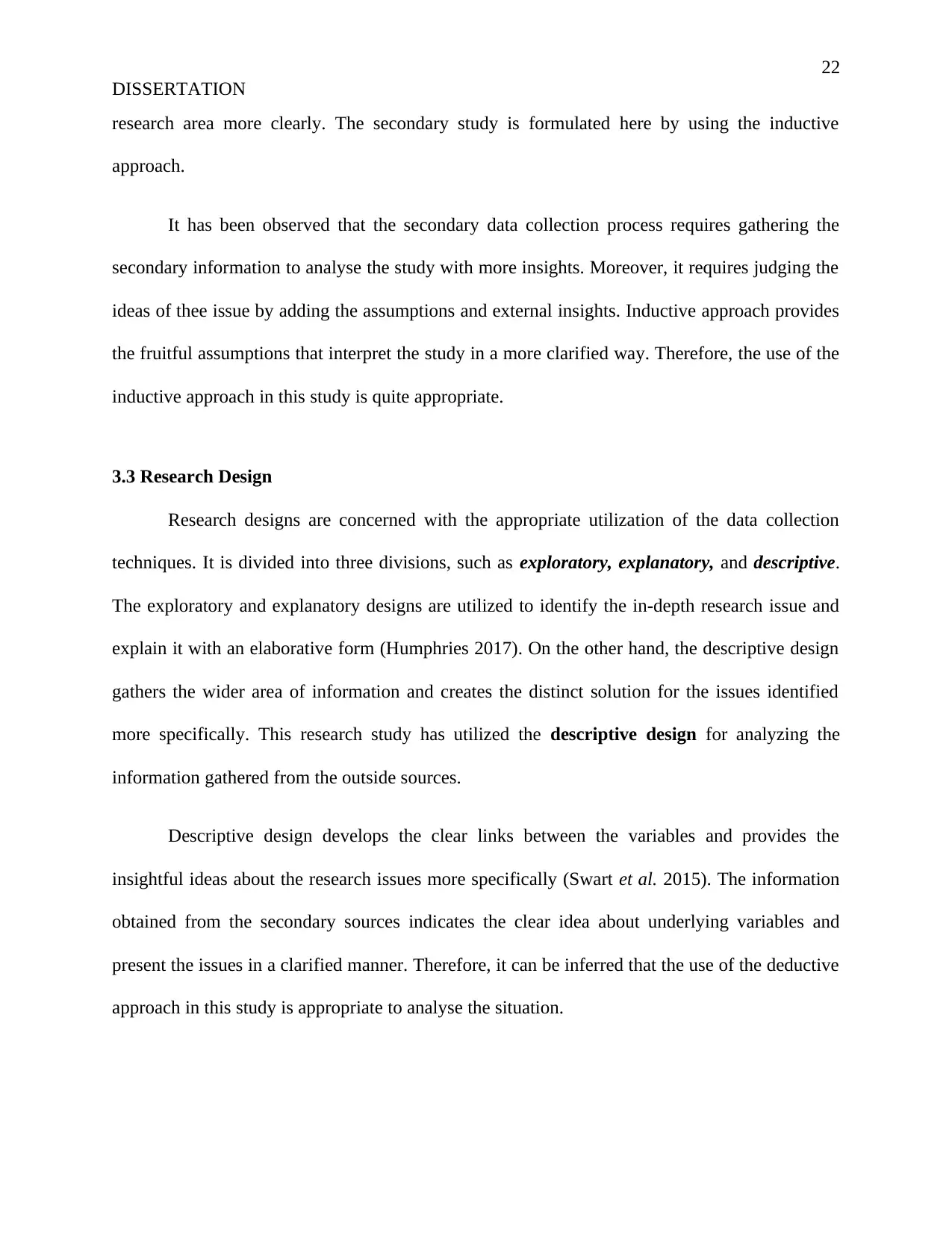
22
DISSERTATION
research area more clearly. The secondary study is formulated here by using the inductive
approach.
It has been observed that the secondary data collection process requires gathering the
secondary information to analyse the study with more insights. Moreover, it requires judging the
ideas of thee issue by adding the assumptions and external insights. Inductive approach provides
the fruitful assumptions that interpret the study in a more clarified way. Therefore, the use of the
inductive approach in this study is quite appropriate.
3.3 Research Design
Research designs are concerned with the appropriate utilization of the data collection
techniques. It is divided into three divisions, such as exploratory, explanatory, and descriptive.
The exploratory and explanatory designs are utilized to identify the in-depth research issue and
explain it with an elaborative form (Humphries 2017). On the other hand, the descriptive design
gathers the wider area of information and creates the distinct solution for the issues identified
more specifically. This research study has utilized the descriptive design for analyzing the
information gathered from the outside sources.
Descriptive design develops the clear links between the variables and provides the
insightful ideas about the research issues more specifically (Swart et al. 2015). The information
obtained from the secondary sources indicates the clear idea about underlying variables and
present the issues in a clarified manner. Therefore, it can be inferred that the use of the deductive
approach in this study is appropriate to analyse the situation.
DISSERTATION
research area more clearly. The secondary study is formulated here by using the inductive
approach.
It has been observed that the secondary data collection process requires gathering the
secondary information to analyse the study with more insights. Moreover, it requires judging the
ideas of thee issue by adding the assumptions and external insights. Inductive approach provides
the fruitful assumptions that interpret the study in a more clarified way. Therefore, the use of the
inductive approach in this study is quite appropriate.
3.3 Research Design
Research designs are concerned with the appropriate utilization of the data collection
techniques. It is divided into three divisions, such as exploratory, explanatory, and descriptive.
The exploratory and explanatory designs are utilized to identify the in-depth research issue and
explain it with an elaborative form (Humphries 2017). On the other hand, the descriptive design
gathers the wider area of information and creates the distinct solution for the issues identified
more specifically. This research study has utilized the descriptive design for analyzing the
information gathered from the outside sources.
Descriptive design develops the clear links between the variables and provides the
insightful ideas about the research issues more specifically (Swart et al. 2015). The information
obtained from the secondary sources indicates the clear idea about underlying variables and
present the issues in a clarified manner. Therefore, it can be inferred that the use of the deductive
approach in this study is appropriate to analyse the situation.
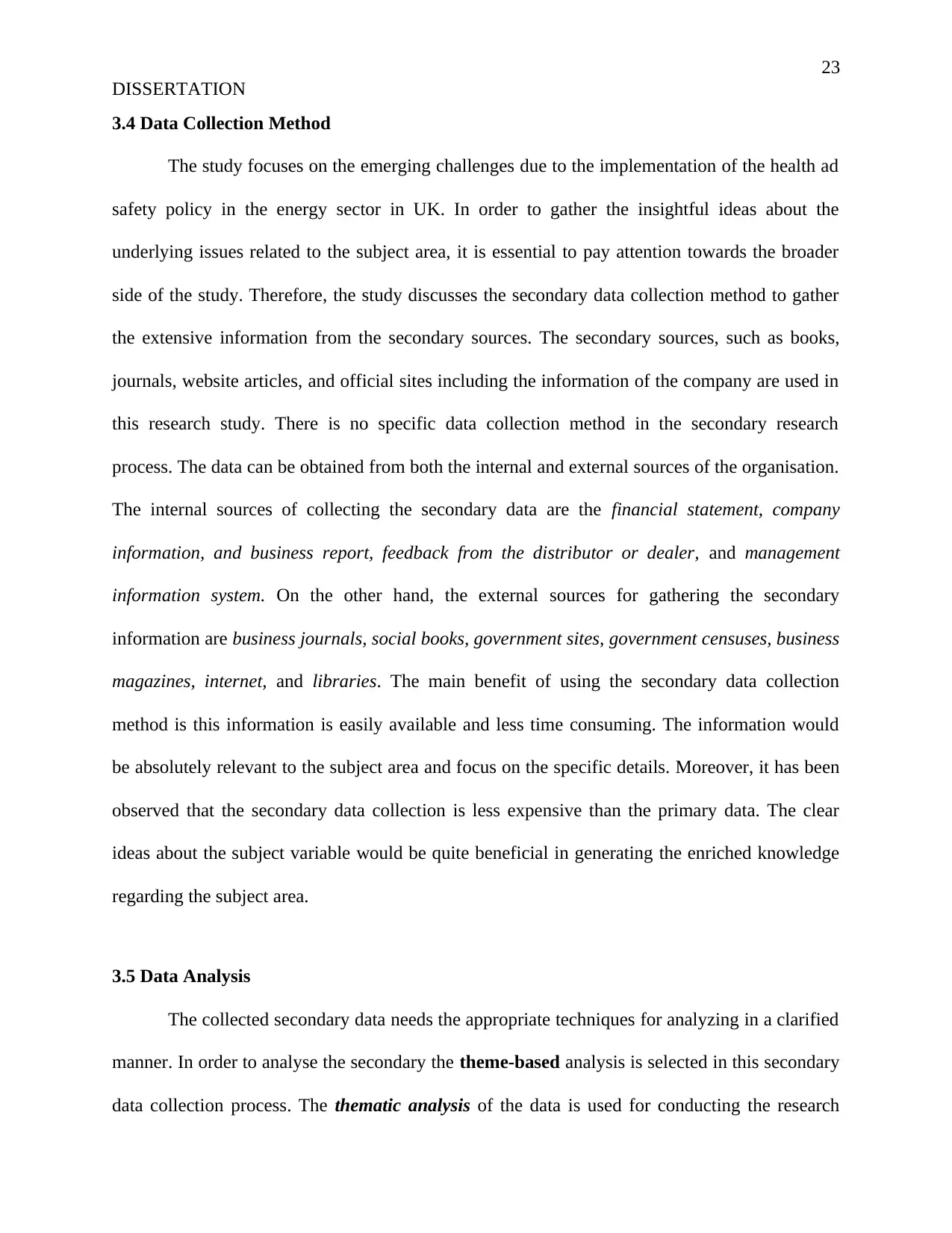
23
DISSERTATION
3.4 Data Collection Method
The study focuses on the emerging challenges due to the implementation of the health ad
safety policy in the energy sector in UK. In order to gather the insightful ideas about the
underlying issues related to the subject area, it is essential to pay attention towards the broader
side of the study. Therefore, the study discusses the secondary data collection method to gather
the extensive information from the secondary sources. The secondary sources, such as books,
journals, website articles, and official sites including the information of the company are used in
this research study. There is no specific data collection method in the secondary research
process. The data can be obtained from both the internal and external sources of the organisation.
The internal sources of collecting the secondary data are the financial statement, company
information, and business report, feedback from the distributor or dealer, and management
information system. On the other hand, the external sources for gathering the secondary
information are business journals, social books, government sites, government censuses, business
magazines, internet, and libraries. The main benefit of using the secondary data collection
method is this information is easily available and less time consuming. The information would
be absolutely relevant to the subject area and focus on the specific details. Moreover, it has been
observed that the secondary data collection is less expensive than the primary data. The clear
ideas about the subject variable would be quite beneficial in generating the enriched knowledge
regarding the subject area.
3.5 Data Analysis
The collected secondary data needs the appropriate techniques for analyzing in a clarified
manner. In order to analyse the secondary the theme-based analysis is selected in this secondary
data collection process. The thematic analysis of the data is used for conducting the research
DISSERTATION
3.4 Data Collection Method
The study focuses on the emerging challenges due to the implementation of the health ad
safety policy in the energy sector in UK. In order to gather the insightful ideas about the
underlying issues related to the subject area, it is essential to pay attention towards the broader
side of the study. Therefore, the study discusses the secondary data collection method to gather
the extensive information from the secondary sources. The secondary sources, such as books,
journals, website articles, and official sites including the information of the company are used in
this research study. There is no specific data collection method in the secondary research
process. The data can be obtained from both the internal and external sources of the organisation.
The internal sources of collecting the secondary data are the financial statement, company
information, and business report, feedback from the distributor or dealer, and management
information system. On the other hand, the external sources for gathering the secondary
information are business journals, social books, government sites, government censuses, business
magazines, internet, and libraries. The main benefit of using the secondary data collection
method is this information is easily available and less time consuming. The information would
be absolutely relevant to the subject area and focus on the specific details. Moreover, it has been
observed that the secondary data collection is less expensive than the primary data. The clear
ideas about the subject variable would be quite beneficial in generating the enriched knowledge
regarding the subject area.
3.5 Data Analysis
The collected secondary data needs the appropriate techniques for analyzing in a clarified
manner. In order to analyse the secondary the theme-based analysis is selected in this secondary
data collection process. The thematic analysis of the data is used for conducting the research
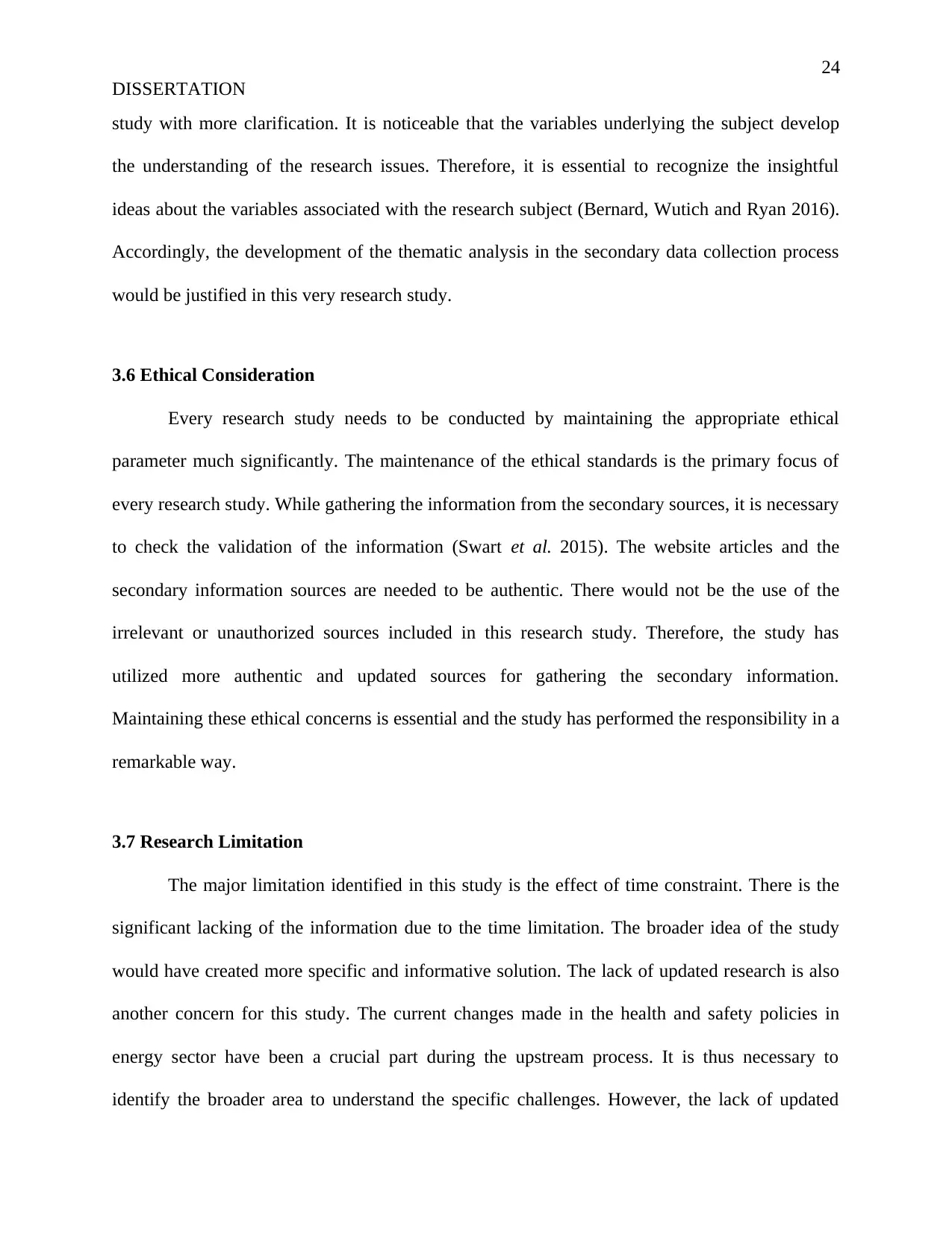
24
DISSERTATION
study with more clarification. It is noticeable that the variables underlying the subject develop
the understanding of the research issues. Therefore, it is essential to recognize the insightful
ideas about the variables associated with the research subject (Bernard, Wutich and Ryan 2016).
Accordingly, the development of the thematic analysis in the secondary data collection process
would be justified in this very research study.
3.6 Ethical Consideration
Every research study needs to be conducted by maintaining the appropriate ethical
parameter much significantly. The maintenance of the ethical standards is the primary focus of
every research study. While gathering the information from the secondary sources, it is necessary
to check the validation of the information (Swart et al. 2015). The website articles and the
secondary information sources are needed to be authentic. There would not be the use of the
irrelevant or unauthorized sources included in this research study. Therefore, the study has
utilized more authentic and updated sources for gathering the secondary information.
Maintaining these ethical concerns is essential and the study has performed the responsibility in a
remarkable way.
3.7 Research Limitation
The major limitation identified in this study is the effect of time constraint. There is the
significant lacking of the information due to the time limitation. The broader idea of the study
would have created more specific and informative solution. The lack of updated research is also
another concern for this study. The current changes made in the health and safety policies in
energy sector have been a crucial part during the upstream process. It is thus necessary to
identify the broader area to understand the specific challenges. However, the lack of updated
DISSERTATION
study with more clarification. It is noticeable that the variables underlying the subject develop
the understanding of the research issues. Therefore, it is essential to recognize the insightful
ideas about the variables associated with the research subject (Bernard, Wutich and Ryan 2016).
Accordingly, the development of the thematic analysis in the secondary data collection process
would be justified in this very research study.
3.6 Ethical Consideration
Every research study needs to be conducted by maintaining the appropriate ethical
parameter much significantly. The maintenance of the ethical standards is the primary focus of
every research study. While gathering the information from the secondary sources, it is necessary
to check the validation of the information (Swart et al. 2015). The website articles and the
secondary information sources are needed to be authentic. There would not be the use of the
irrelevant or unauthorized sources included in this research study. Therefore, the study has
utilized more authentic and updated sources for gathering the secondary information.
Maintaining these ethical concerns is essential and the study has performed the responsibility in a
remarkable way.
3.7 Research Limitation
The major limitation identified in this study is the effect of time constraint. There is the
significant lacking of the information due to the time limitation. The broader idea of the study
would have created more specific and informative solution. The lack of updated research is also
another concern for this study. The current changes made in the health and safety policies in
energy sector have been a crucial part during the upstream process. It is thus necessary to
identify the broader area to understand the specific challenges. However, the lack of updated
Secure Best Marks with AI Grader
Need help grading? Try our AI Grader for instant feedback on your assignments.
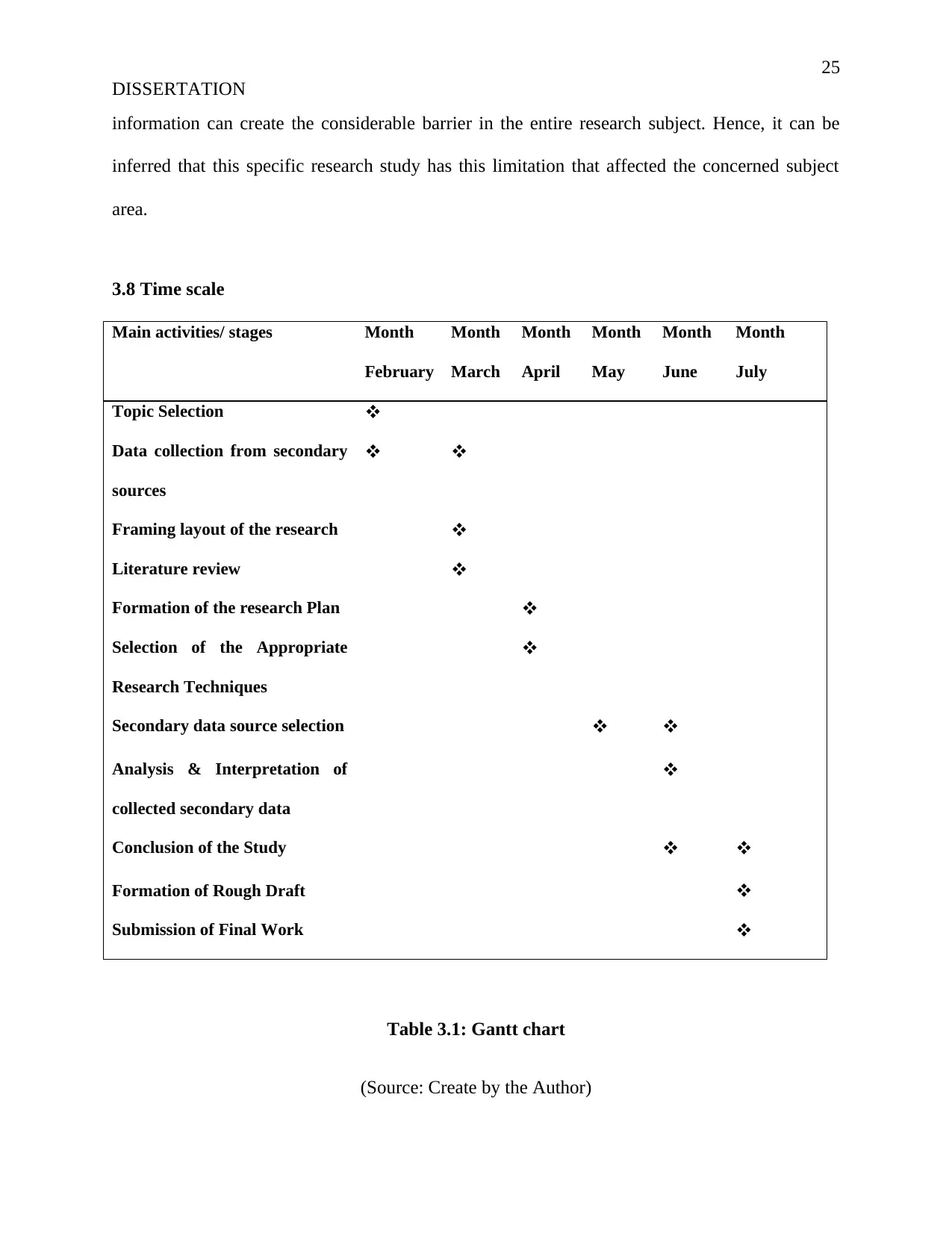
25
DISSERTATION
information can create the considerable barrier in the entire research subject. Hence, it can be
inferred that this specific research study has this limitation that affected the concerned subject
area.
3.8 Time scale
Main activities/ stages Month
February
Month
March
Month
April
Month
May
Month
June
Month
July
Topic Selection
Data collection from secondary
sources
Framing layout of the research
Literature review
Formation of the research Plan
Selection of the Appropriate
Research Techniques
Secondary data source selection
Analysis & Interpretation of
collected secondary data
Conclusion of the Study
Formation of Rough Draft
Submission of Final Work
Table 3.1: Gantt chart
(Source: Create by the Author)
DISSERTATION
information can create the considerable barrier in the entire research subject. Hence, it can be
inferred that this specific research study has this limitation that affected the concerned subject
area.
3.8 Time scale
Main activities/ stages Month
February
Month
March
Month
April
Month
May
Month
June
Month
July
Topic Selection
Data collection from secondary
sources
Framing layout of the research
Literature review
Formation of the research Plan
Selection of the Appropriate
Research Techniques
Secondary data source selection
Analysis & Interpretation of
collected secondary data
Conclusion of the Study
Formation of Rough Draft
Submission of Final Work
Table 3.1: Gantt chart
(Source: Create by the Author)
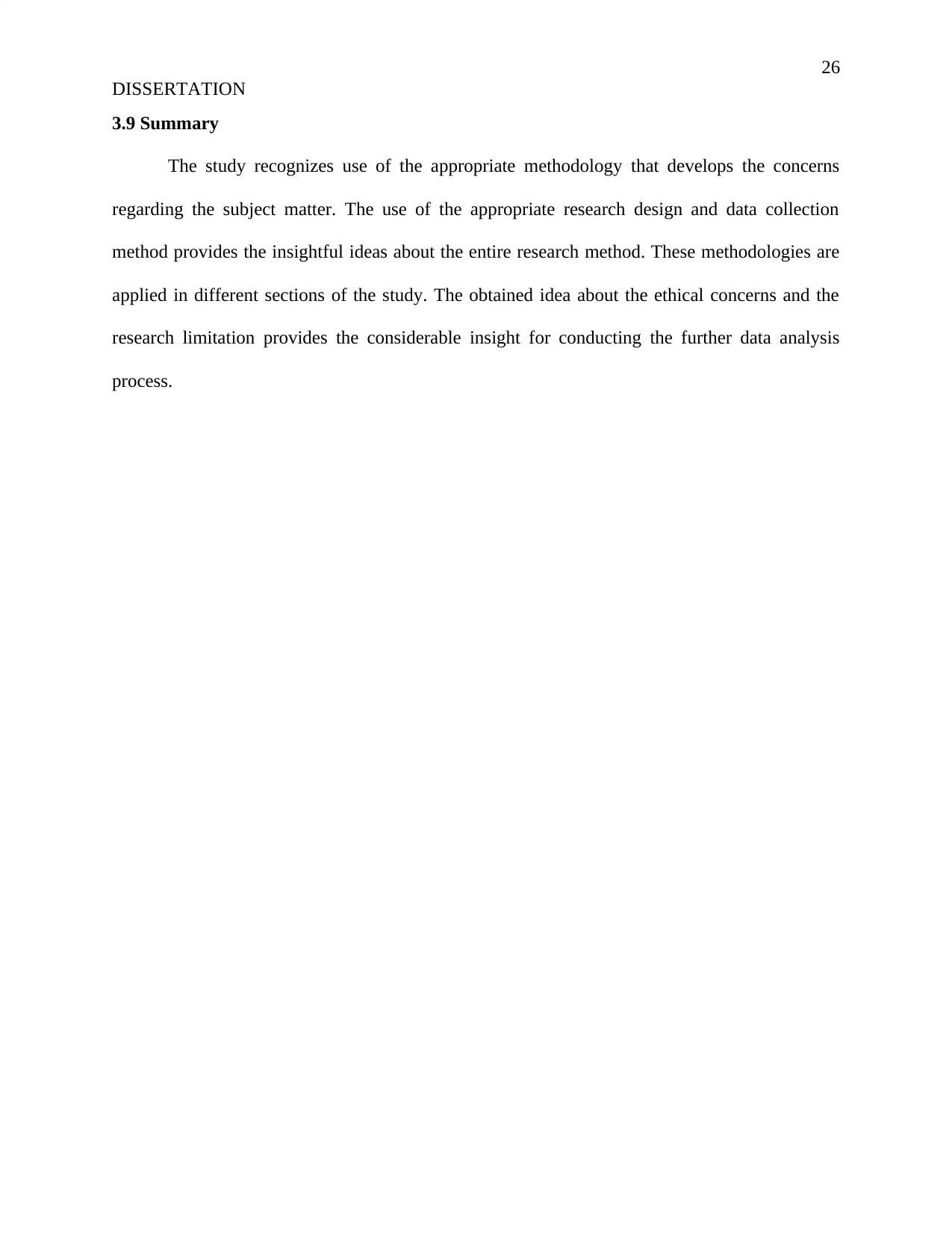
26
DISSERTATION
3.9 Summary
The study recognizes use of the appropriate methodology that develops the concerns
regarding the subject matter. The use of the appropriate research design and data collection
method provides the insightful ideas about the entire research method. These methodologies are
applied in different sections of the study. The obtained idea about the ethical concerns and the
research limitation provides the considerable insight for conducting the further data analysis
process.
DISSERTATION
3.9 Summary
The study recognizes use of the appropriate methodology that develops the concerns
regarding the subject matter. The use of the appropriate research design and data collection
method provides the insightful ideas about the entire research method. These methodologies are
applied in different sections of the study. The obtained idea about the ethical concerns and the
research limitation provides the considerable insight for conducting the further data analysis
process.
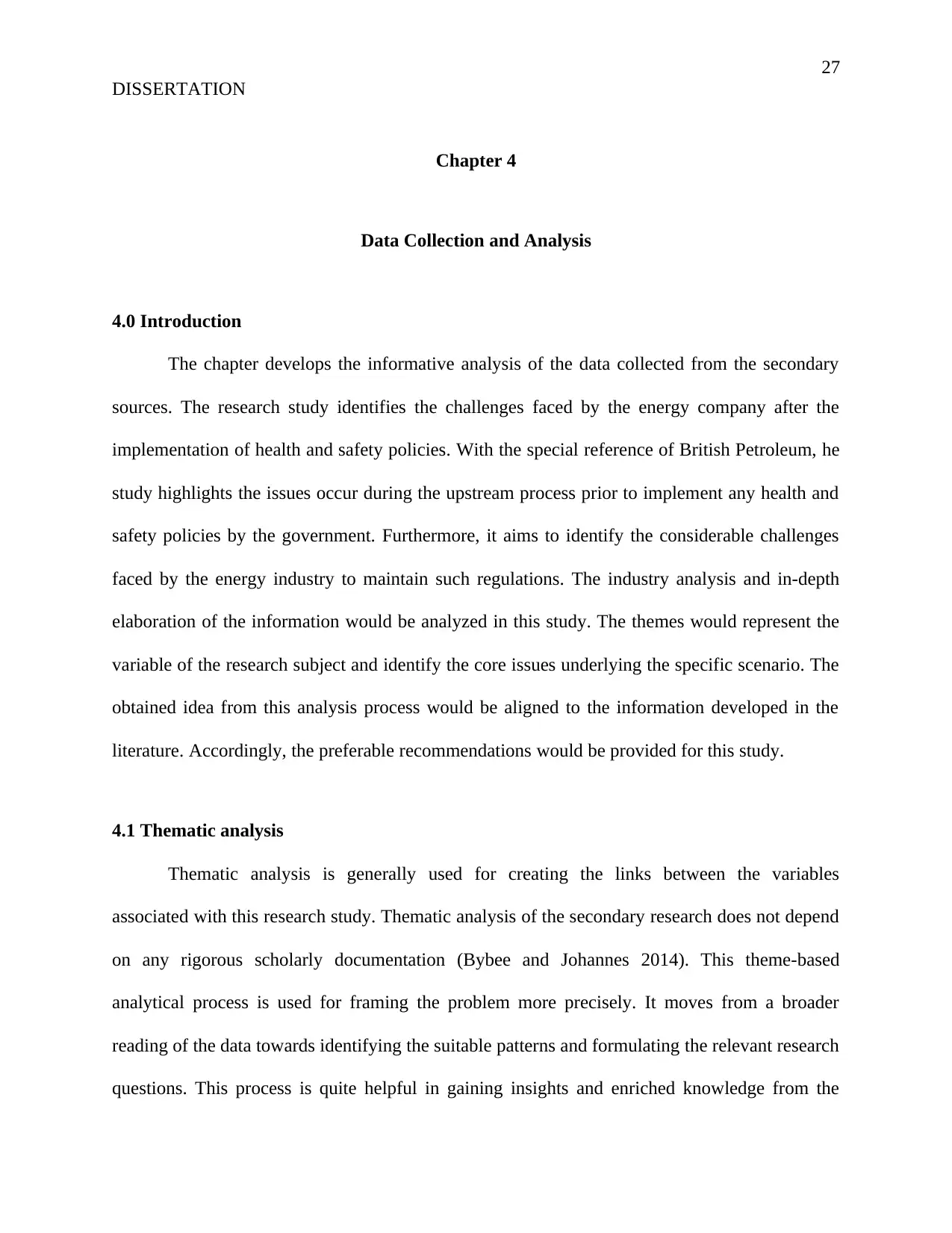
27
DISSERTATION
Chapter 4
Data Collection and Analysis
4.0 Introduction
The chapter develops the informative analysis of the data collected from the secondary
sources. The research study identifies the challenges faced by the energy company after the
implementation of health and safety policies. With the special reference of British Petroleum, he
study highlights the issues occur during the upstream process prior to implement any health and
safety policies by the government. Furthermore, it aims to identify the considerable challenges
faced by the energy industry to maintain such regulations. The industry analysis and in-depth
elaboration of the information would be analyzed in this study. The themes would represent the
variable of the research subject and identify the core issues underlying the specific scenario. The
obtained idea from this analysis process would be aligned to the information developed in the
literature. Accordingly, the preferable recommendations would be provided for this study.
4.1 Thematic analysis
Thematic analysis is generally used for creating the links between the variables
associated with this research study. Thematic analysis of the secondary research does not depend
on any rigorous scholarly documentation (Bybee and Johannes 2014). This theme-based
analytical process is used for framing the problem more precisely. It moves from a broader
reading of the data towards identifying the suitable patterns and formulating the relevant research
questions. This process is quite helpful in gaining insights and enriched knowledge from the
DISSERTATION
Chapter 4
Data Collection and Analysis
4.0 Introduction
The chapter develops the informative analysis of the data collected from the secondary
sources. The research study identifies the challenges faced by the energy company after the
implementation of health and safety policies. With the special reference of British Petroleum, he
study highlights the issues occur during the upstream process prior to implement any health and
safety policies by the government. Furthermore, it aims to identify the considerable challenges
faced by the energy industry to maintain such regulations. The industry analysis and in-depth
elaboration of the information would be analyzed in this study. The themes would represent the
variable of the research subject and identify the core issues underlying the specific scenario. The
obtained idea from this analysis process would be aligned to the information developed in the
literature. Accordingly, the preferable recommendations would be provided for this study.
4.1 Thematic analysis
Thematic analysis is generally used for creating the links between the variables
associated with this research study. Thematic analysis of the secondary research does not depend
on any rigorous scholarly documentation (Bybee and Johannes 2014). This theme-based
analytical process is used for framing the problem more precisely. It moves from a broader
reading of the data towards identifying the suitable patterns and formulating the relevant research
questions. This process is quite helpful in gaining insights and enriched knowledge from the
Paraphrase This Document
Need a fresh take? Get an instant paraphrase of this document with our AI Paraphraser
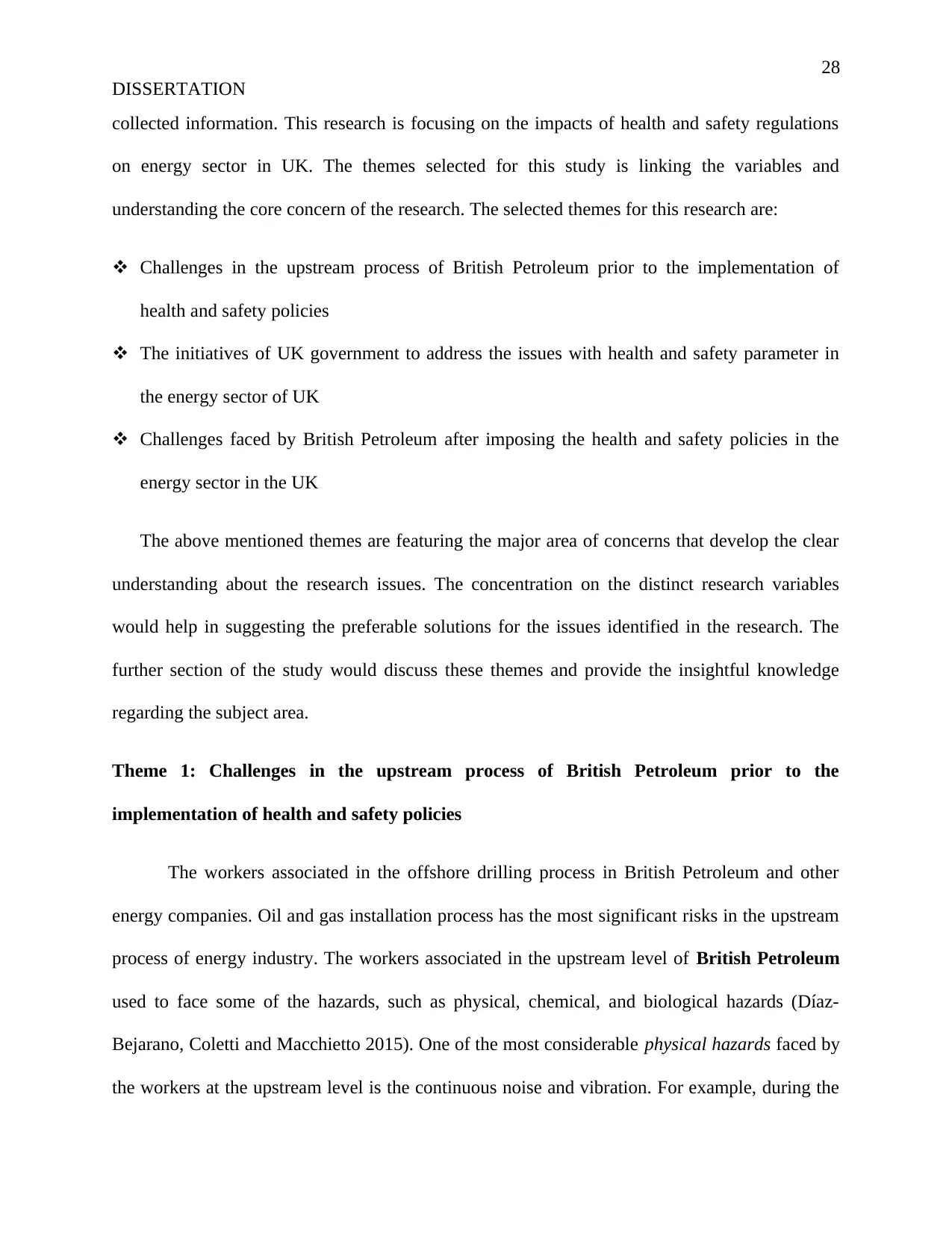
28
DISSERTATION
collected information. This research is focusing on the impacts of health and safety regulations
on energy sector in UK. The themes selected for this study is linking the variables and
understanding the core concern of the research. The selected themes for this research are:
Challenges in the upstream process of British Petroleum prior to the implementation of
health and safety policies
The initiatives of UK government to address the issues with health and safety parameter in
the energy sector of UK
Challenges faced by British Petroleum after imposing the health and safety policies in the
energy sector in the UK
The above mentioned themes are featuring the major area of concerns that develop the clear
understanding about the research issues. The concentration on the distinct research variables
would help in suggesting the preferable solutions for the issues identified in the research. The
further section of the study would discuss these themes and provide the insightful knowledge
regarding the subject area.
Theme 1: Challenges in the upstream process of British Petroleum prior to the
implementation of health and safety policies
The workers associated in the offshore drilling process in British Petroleum and other
energy companies. Oil and gas installation process has the most significant risks in the upstream
process of energy industry. The workers associated in the upstream level of British Petroleum
used to face some of the hazards, such as physical, chemical, and biological hazards (Díaz-
Bejarano, Coletti and Macchietto 2015). One of the most considerable physical hazards faced by
the workers at the upstream level is the continuous noise and vibration. For example, during the
DISSERTATION
collected information. This research is focusing on the impacts of health and safety regulations
on energy sector in UK. The themes selected for this study is linking the variables and
understanding the core concern of the research. The selected themes for this research are:
Challenges in the upstream process of British Petroleum prior to the implementation of
health and safety policies
The initiatives of UK government to address the issues with health and safety parameter in
the energy sector of UK
Challenges faced by British Petroleum after imposing the health and safety policies in the
energy sector in the UK
The above mentioned themes are featuring the major area of concerns that develop the clear
understanding about the research issues. The concentration on the distinct research variables
would help in suggesting the preferable solutions for the issues identified in the research. The
further section of the study would discuss these themes and provide the insightful knowledge
regarding the subject area.
Theme 1: Challenges in the upstream process of British Petroleum prior to the
implementation of health and safety policies
The workers associated in the offshore drilling process in British Petroleum and other
energy companies. Oil and gas installation process has the most significant risks in the upstream
process of energy industry. The workers associated in the upstream level of British Petroleum
used to face some of the hazards, such as physical, chemical, and biological hazards (Díaz-
Bejarano, Coletti and Macchietto 2015). One of the most considerable physical hazards faced by
the workers at the upstream level is the continuous noise and vibration. For example, during the

29
DISSERTATION
drilling process of the floors, generators, misers, and other technological tools may create the
significant health issues of the associated workers in the upstream level. However, it was
suggested that the advanced engineering control process could mitigate the challenges with such
health hazards. Even it has been observed that the diverse thermal extremes and radiations are
also affecting the health of the associated workers (Difiglio 2014). These issues are quite
common in the offshore platform in the operations process performed in British Petroleum. Apart
from such physical hazards, some of the chemical hazards are also identified in the upstream
sector.
In the year of 2016, one internal report was published in which it was mentioned that BP
monitored the faults in the chemical and refinery sites. It was reported that the Greenpace was
leaked and the “urgent attention” was required for the workforces. It was essential for BP to
manage the crucial engineering data across the world. In the year of 2014, BP lost almost $258m
production due to the failure of data (Macalister and Webb 2018). Another issue was found in
the chemical plant in Hull, UK. It was reported that the equipment was not operated correctly
due to which it caused damage of $35-45m. In fact, the critical blueprints had gone missing
during the crucial operational process. In the year of 2010, BP faced the huge explosion in the
Gulf of Mexico that caused deaths to many lives (Lanke, Ghodrati and Lundberg 2016). The
internal report identified that the inadequate management and improper use of the engineering
information are the major reasons for such challenges. In addition to this, it was reported that the
single aggregated list of safety critical equipment was not installed properly. The report indicated
that almost 80% of the BP staff associated with the engineering process exclaimed that they did
not receive any adequate priority or resources to develop safe practices. It was also notified that
in spite of having 7,000 engineering information users in the company, they waste majority of
DISSERTATION
drilling process of the floors, generators, misers, and other technological tools may create the
significant health issues of the associated workers in the upstream level. However, it was
suggested that the advanced engineering control process could mitigate the challenges with such
health hazards. Even it has been observed that the diverse thermal extremes and radiations are
also affecting the health of the associated workers (Difiglio 2014). These issues are quite
common in the offshore platform in the operations process performed in British Petroleum. Apart
from such physical hazards, some of the chemical hazards are also identified in the upstream
sector.
In the year of 2016, one internal report was published in which it was mentioned that BP
monitored the faults in the chemical and refinery sites. It was reported that the Greenpace was
leaked and the “urgent attention” was required for the workforces. It was essential for BP to
manage the crucial engineering data across the world. In the year of 2014, BP lost almost $258m
production due to the failure of data (Macalister and Webb 2018). Another issue was found in
the chemical plant in Hull, UK. It was reported that the equipment was not operated correctly
due to which it caused damage of $35-45m. In fact, the critical blueprints had gone missing
during the crucial operational process. In the year of 2010, BP faced the huge explosion in the
Gulf of Mexico that caused deaths to many lives (Lanke, Ghodrati and Lundberg 2016). The
internal report identified that the inadequate management and improper use of the engineering
information are the major reasons for such challenges. In addition to this, it was reported that the
single aggregated list of safety critical equipment was not installed properly. The report indicated
that almost 80% of the BP staff associated with the engineering process exclaimed that they did
not receive any adequate priority or resources to develop safe practices. It was also notified that
in spite of having 7,000 engineering information users in the company, they waste majority of

30
DISSERTATION
time in finding, using, and maintaining the engineering information (Ebrahemzadih et al. 2014).
The lack of systematic coordination became one of the major reasons due to the improper
management of these aspects.
Theme 2: The initiatives of UK government to address the issues with health and safety
parameter in the energy sector of UK
After reviewing and monitoring the health and safety issues in the upstream process of
energy industry, UK government started modifying the health and safety policies in UK in order
to minimize the risks occurrence in the offshore areas. The health and safety regulations imposed
by the UK government consider that it is essential to manage the health and safety parameter of
the associated workers (Elgowain et al. 2014). It is notified that the health-related regulations
imposed to the offshore working environment are necessarily needed to be controlled. As per the
industry policy, it is necessary for every worker in the offshore zone to undergo the medical
checkup everyday by a medical professional. Only the deemed medically fit people are allowed
to perform the offshore programs.
It is noticed that the energy sector in UK is committed enough to protect people, assets,
and natural environment by maintaining the safer operational process. The industry is even
striving continuously to improve the safer process and performance. The performance indicators
are used for monitoring the progress report of the performance (Fabiano and Currò 2012). The
industry even uses the personal safety metrics point for managing the risks to an individual. In
order to minimize the harm level of the individual, the industry is primarily focusing on the
process safety and the effective containments of the hydrocarbons as well as hazards. The
government instructed the industry to maintain the backlog by keeping the systematic tracks
DISSERTATION
time in finding, using, and maintaining the engineering information (Ebrahemzadih et al. 2014).
The lack of systematic coordination became one of the major reasons due to the improper
management of these aspects.
Theme 2: The initiatives of UK government to address the issues with health and safety
parameter in the energy sector of UK
After reviewing and monitoring the health and safety issues in the upstream process of
energy industry, UK government started modifying the health and safety policies in UK in order
to minimize the risks occurrence in the offshore areas. The health and safety regulations imposed
by the UK government consider that it is essential to manage the health and safety parameter of
the associated workers (Elgowain et al. 2014). It is notified that the health-related regulations
imposed to the offshore working environment are necessarily needed to be controlled. As per the
industry policy, it is necessary for every worker in the offshore zone to undergo the medical
checkup everyday by a medical professional. Only the deemed medically fit people are allowed
to perform the offshore programs.
It is noticed that the energy sector in UK is committed enough to protect people, assets,
and natural environment by maintaining the safer operational process. The industry is even
striving continuously to improve the safer process and performance. The performance indicators
are used for monitoring the progress report of the performance (Fabiano and Currò 2012). The
industry even uses the personal safety metrics point for managing the risks to an individual. In
order to minimize the harm level of the individual, the industry is primarily focusing on the
process safety and the effective containments of the hydrocarbons as well as hazards. The
government instructed the industry to maintain the backlog by keeping the systematic tracks
Secure Best Marks with AI Grader
Need help grading? Try our AI Grader for instant feedback on your assignments.
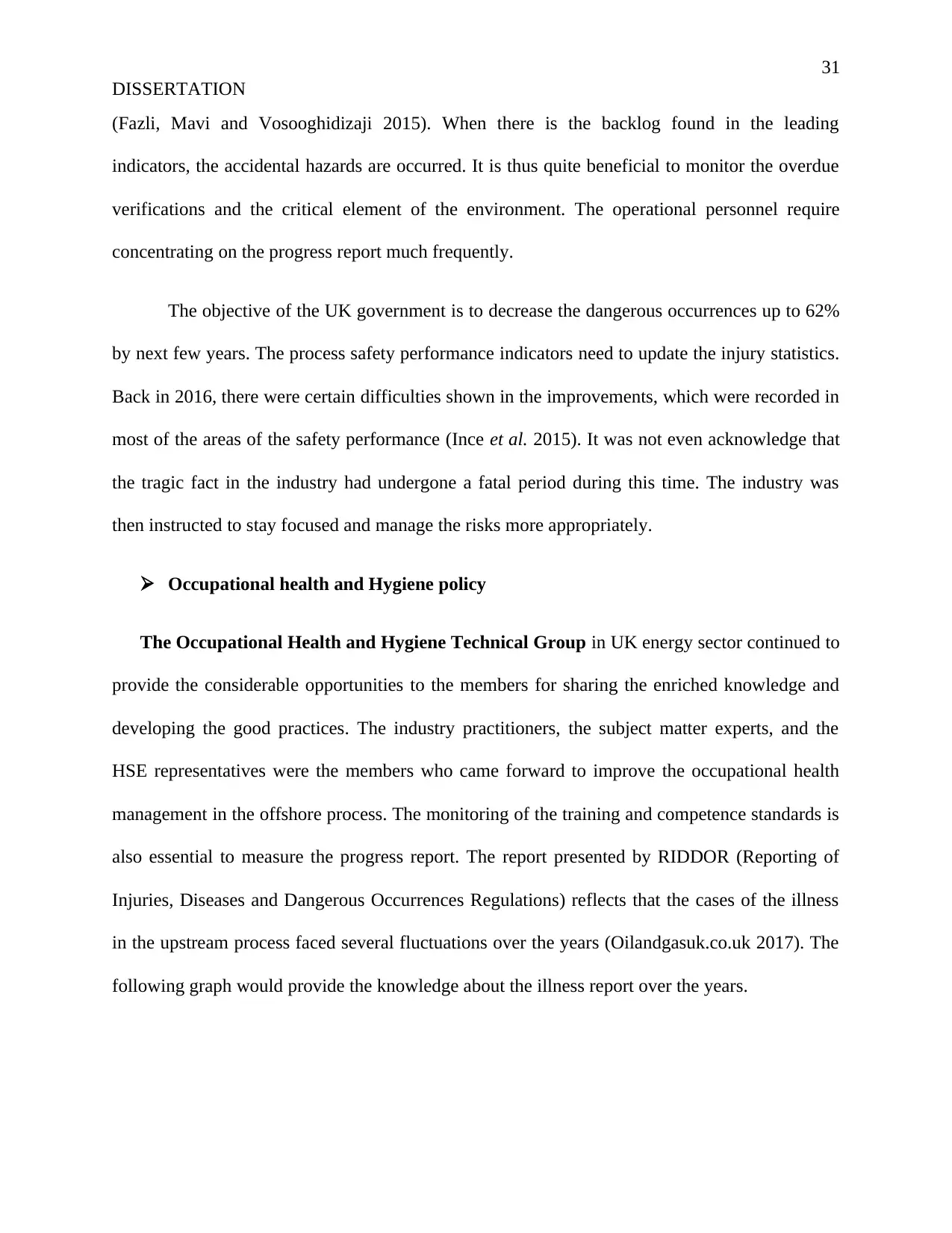
31
DISSERTATION
(Fazli, Mavi and Vosooghidizaji 2015). When there is the backlog found in the leading
indicators, the accidental hazards are occurred. It is thus quite beneficial to monitor the overdue
verifications and the critical element of the environment. The operational personnel require
concentrating on the progress report much frequently.
The objective of the UK government is to decrease the dangerous occurrences up to 62%
by next few years. The process safety performance indicators need to update the injury statistics.
Back in 2016, there were certain difficulties shown in the improvements, which were recorded in
most of the areas of the safety performance (Ince et al. 2015). It was not even acknowledge that
the tragic fact in the industry had undergone a fatal period during this time. The industry was
then instructed to stay focused and manage the risks more appropriately.
Occupational health and Hygiene policy
The Occupational Health and Hygiene Technical Group in UK energy sector continued to
provide the considerable opportunities to the members for sharing the enriched knowledge and
developing the good practices. The industry practitioners, the subject matter experts, and the
HSE representatives were the members who came forward to improve the occupational health
management in the offshore process. The monitoring of the training and competence standards is
also essential to measure the progress report. The report presented by RIDDOR (Reporting of
Injuries, Diseases and Dangerous Occurrences Regulations) reflects that the cases of the illness
in the upstream process faced several fluctuations over the years (Oilandgasuk.co.uk 2017). The
following graph would provide the knowledge about the illness report over the years.
DISSERTATION
(Fazli, Mavi and Vosooghidizaji 2015). When there is the backlog found in the leading
indicators, the accidental hazards are occurred. It is thus quite beneficial to monitor the overdue
verifications and the critical element of the environment. The operational personnel require
concentrating on the progress report much frequently.
The objective of the UK government is to decrease the dangerous occurrences up to 62%
by next few years. The process safety performance indicators need to update the injury statistics.
Back in 2016, there were certain difficulties shown in the improvements, which were recorded in
most of the areas of the safety performance (Ince et al. 2015). It was not even acknowledge that
the tragic fact in the industry had undergone a fatal period during this time. The industry was
then instructed to stay focused and manage the risks more appropriately.
Occupational health and Hygiene policy
The Occupational Health and Hygiene Technical Group in UK energy sector continued to
provide the considerable opportunities to the members for sharing the enriched knowledge and
developing the good practices. The industry practitioners, the subject matter experts, and the
HSE representatives were the members who came forward to improve the occupational health
management in the offshore process. The monitoring of the training and competence standards is
also essential to measure the progress report. The report presented by RIDDOR (Reporting of
Injuries, Diseases and Dangerous Occurrences Regulations) reflects that the cases of the illness
in the upstream process faced several fluctuations over the years (Oilandgasuk.co.uk 2017). The
following graph would provide the knowledge about the illness report over the years.
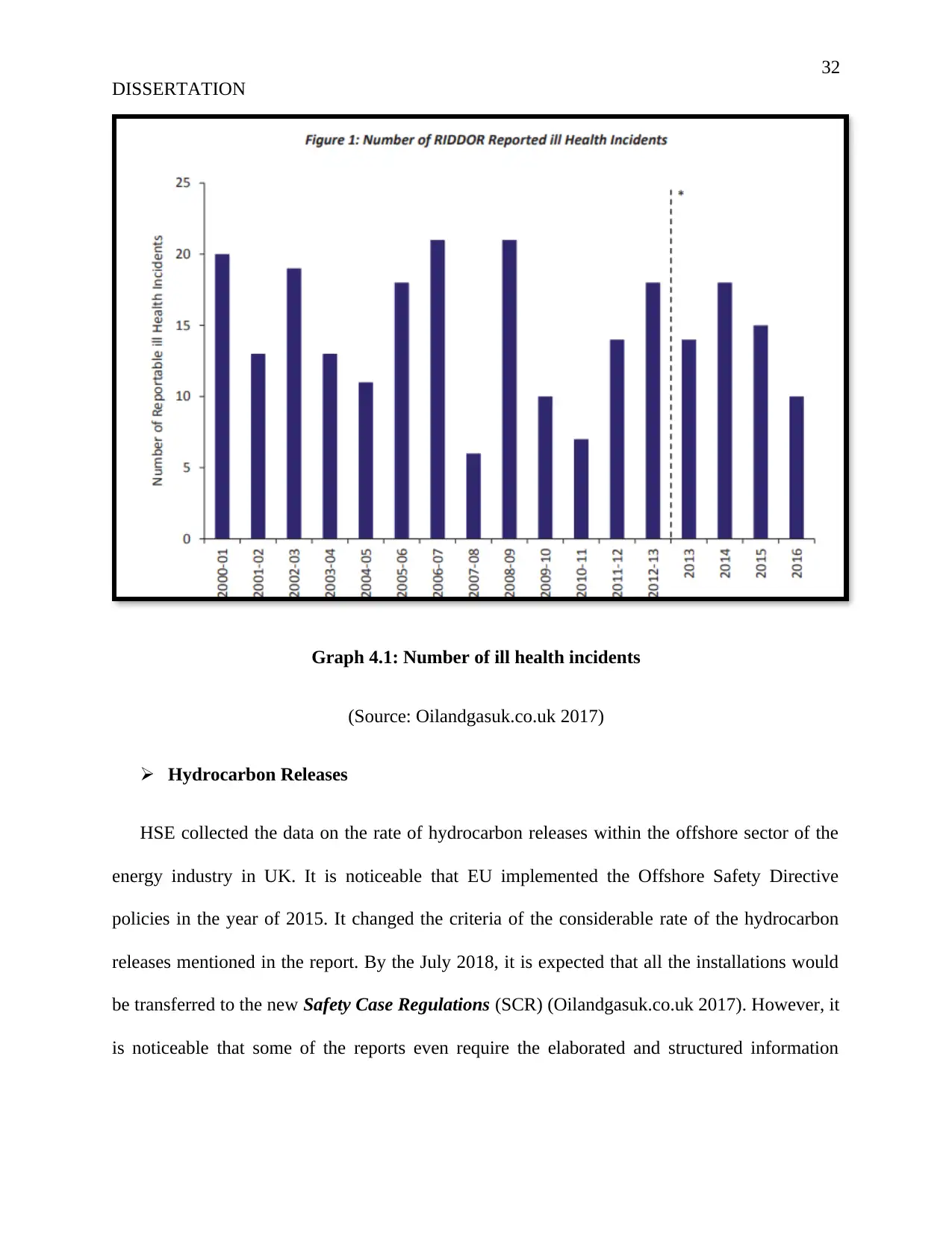
32
DISSERTATION
Graph 4.1: Number of ill health incidents
(Source: Oilandgasuk.co.uk 2017)
Hydrocarbon Releases
HSE collected the data on the rate of hydrocarbon releases within the offshore sector of the
energy industry in UK. It is noticeable that EU implemented the Offshore Safety Directive
policies in the year of 2015. It changed the criteria of the considerable rate of the hydrocarbon
releases mentioned in the report. By the July 2018, it is expected that all the installations would
be transferred to the new Safety Case Regulations (SCR) (Oilandgasuk.co.uk 2017). However, it
is noticeable that some of the reports even require the elaborated and structured information
DISSERTATION
Graph 4.1: Number of ill health incidents
(Source: Oilandgasuk.co.uk 2017)
Hydrocarbon Releases
HSE collected the data on the rate of hydrocarbon releases within the offshore sector of the
energy industry in UK. It is noticeable that EU implemented the Offshore Safety Directive
policies in the year of 2015. It changed the criteria of the considerable rate of the hydrocarbon
releases mentioned in the report. By the July 2018, it is expected that all the installations would
be transferred to the new Safety Case Regulations (SCR) (Oilandgasuk.co.uk 2017). However, it
is noticeable that some of the reports even require the elaborated and structured information
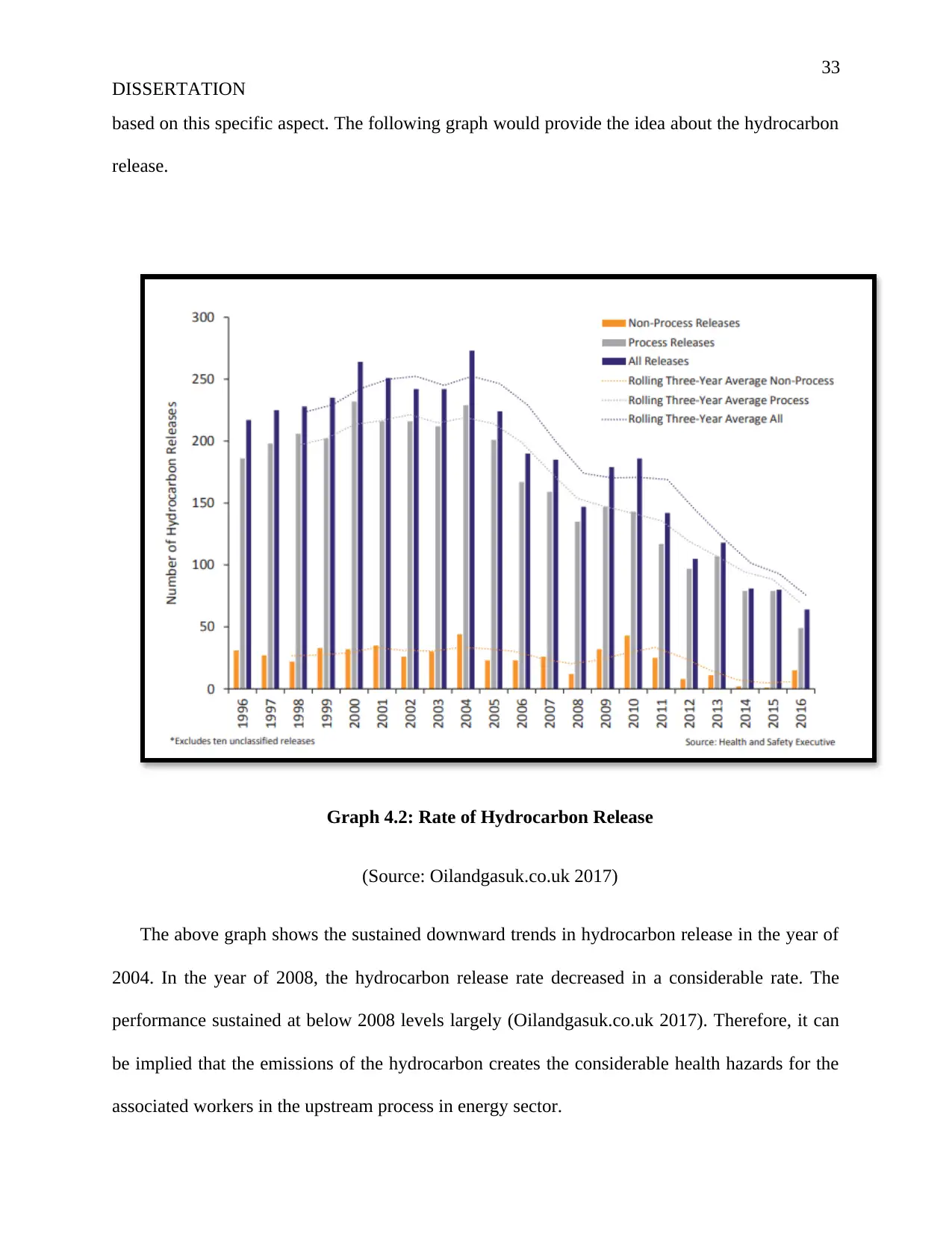
33
DISSERTATION
based on this specific aspect. The following graph would provide the idea about the hydrocarbon
release.
Graph 4.2: Rate of Hydrocarbon Release
(Source: Oilandgasuk.co.uk 2017)
The above graph shows the sustained downward trends in hydrocarbon release in the year of
2004. In the year of 2008, the hydrocarbon release rate decreased in a considerable rate. The
performance sustained at below 2008 levels largely (Oilandgasuk.co.uk 2017). Therefore, it can
be implied that the emissions of the hydrocarbon creates the considerable health hazards for the
associated workers in the upstream process in energy sector.
DISSERTATION
based on this specific aspect. The following graph would provide the idea about the hydrocarbon
release.
Graph 4.2: Rate of Hydrocarbon Release
(Source: Oilandgasuk.co.uk 2017)
The above graph shows the sustained downward trends in hydrocarbon release in the year of
2004. In the year of 2008, the hydrocarbon release rate decreased in a considerable rate. The
performance sustained at below 2008 levels largely (Oilandgasuk.co.uk 2017). Therefore, it can
be implied that the emissions of the hydrocarbon creates the considerable health hazards for the
associated workers in the upstream process in energy sector.
Paraphrase This Document
Need a fresh take? Get an instant paraphrase of this document with our AI Paraphraser

34
DISSERTATION
Theme 3: Challenges faced by British Petroleum after imposing the health and safety
policies in the energy sector in the UK
The HSE (Health and Safety Executives) conducted the safety standards of the health and
safety parameter in the upstream process practiced in the energy companies in UK including BP.
After reviewing the health and safety process, HSE warned these companies since they failed to
operate the rigs and other associated equipment required for the offshore upstream process. The
offshore regulator sent the ‘improvement notice’ after reviewing the report of the numerous
numbers of accidents occurred in BP (James 2012). The statistics increased in a considerable
way. After the deep water explosion in US, BP has been continuously facing environmental and
political challenges. Moreover, HSE websites proved the faulty work practices as well. The latest
‘improvement notice’ sent to British Petroleum indicated the message from HSE. It informed
that British Petroleum failed to ensure the safety parameter for the associated employees and
they do not even provide the feasible maintaining systems of the work for controlling the
operational process (Klass and Meinhardt 2014). The lack of safe practices is the major obstacle
for the company to develop the better operational processes.
BP received another notice from the regulators stating that it failed to ensure the
reasonably practicable the health and safety parameter of the employees. Moreover, it was
acclaimed that employment did not use the fabric components for installing the offshore
Magnum, such as gratings, walkways, and stairways. It was also reported that the company even
list the failed to maintain the control measures within the potable water system that could have
prevented the exposure to bacteria. The HSE websites still contain these warnings and notices
sent to BP. However, it was noticed that BP exclaimed that they were alleged due to the minor
issues that could have been easily sorted. (Macalister and Webb 2018) A spokeswoman stated
DISSERTATION
Theme 3: Challenges faced by British Petroleum after imposing the health and safety
policies in the energy sector in the UK
The HSE (Health and Safety Executives) conducted the safety standards of the health and
safety parameter in the upstream process practiced in the energy companies in UK including BP.
After reviewing the health and safety process, HSE warned these companies since they failed to
operate the rigs and other associated equipment required for the offshore upstream process. The
offshore regulator sent the ‘improvement notice’ after reviewing the report of the numerous
numbers of accidents occurred in BP (James 2012). The statistics increased in a considerable
way. After the deep water explosion in US, BP has been continuously facing environmental and
political challenges. Moreover, HSE websites proved the faulty work practices as well. The latest
‘improvement notice’ sent to British Petroleum indicated the message from HSE. It informed
that British Petroleum failed to ensure the safety parameter for the associated employees and
they do not even provide the feasible maintaining systems of the work for controlling the
operational process (Klass and Meinhardt 2014). The lack of safe practices is the major obstacle
for the company to develop the better operational processes.
BP received another notice from the regulators stating that it failed to ensure the
reasonably practicable the health and safety parameter of the employees. Moreover, it was
acclaimed that employment did not use the fabric components for installing the offshore
Magnum, such as gratings, walkways, and stairways. It was also reported that the company even
list the failed to maintain the control measures within the potable water system that could have
prevented the exposure to bacteria. The HSE websites still contain these warnings and notices
sent to BP. However, it was noticed that BP exclaimed that they were alleged due to the minor
issues that could have been easily sorted. (Macalister and Webb 2018) A spokeswoman stated
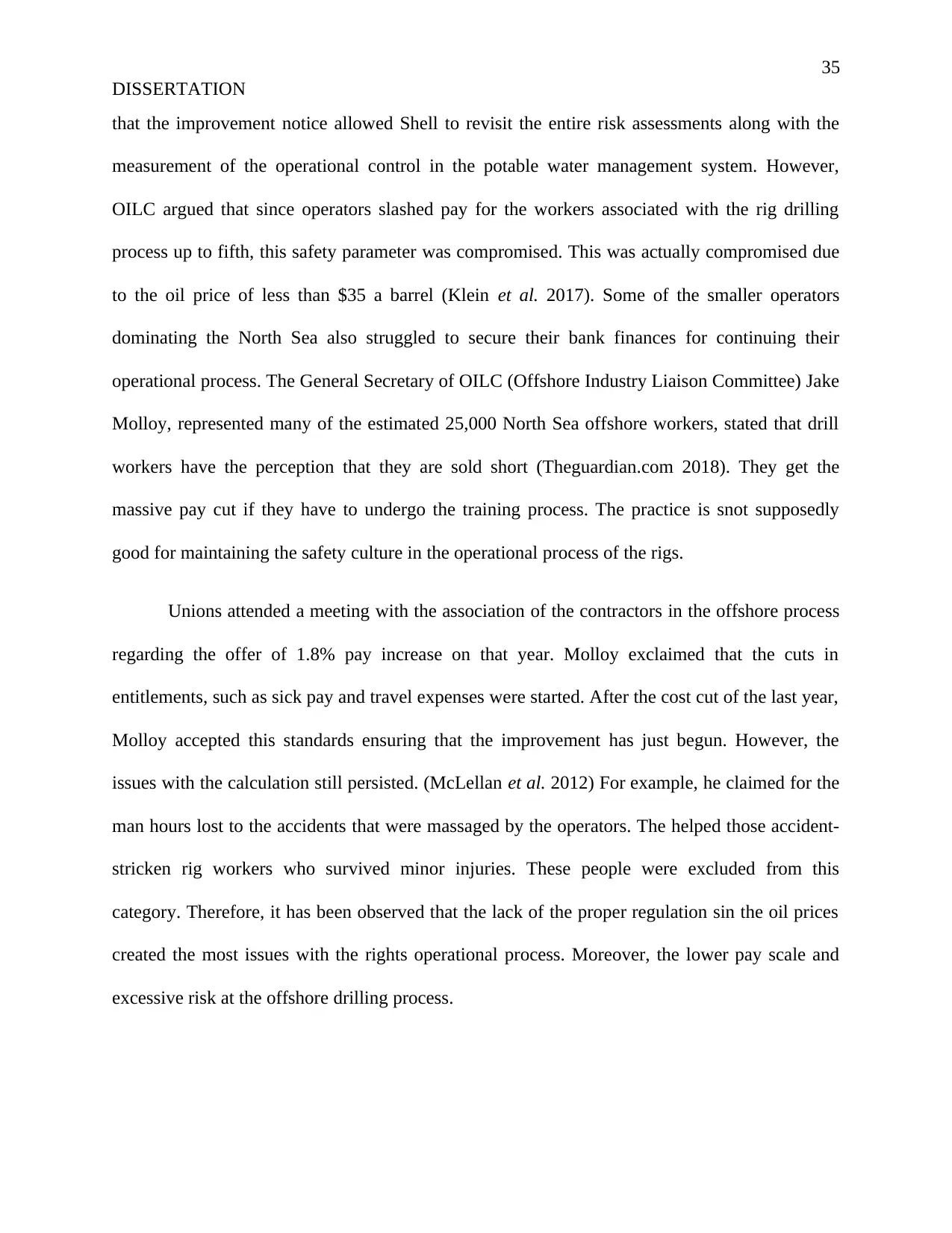
35
DISSERTATION
that the improvement notice allowed Shell to revisit the entire risk assessments along with the
measurement of the operational control in the potable water management system. However,
OILC argued that since operators slashed pay for the workers associated with the rig drilling
process up to fifth, this safety parameter was compromised. This was actually compromised due
to the oil price of less than $35 a barrel (Klein et al. 2017). Some of the smaller operators
dominating the North Sea also struggled to secure their bank finances for continuing their
operational process. The General Secretary of OILC (Offshore Industry Liaison Committee) Jake
Molloy, represented many of the estimated 25,000 North Sea offshore workers, stated that drill
workers have the perception that they are sold short (Theguardian.com 2018). They get the
massive pay cut if they have to undergo the training process. The practice is snot supposedly
good for maintaining the safety culture in the operational process of the rigs.
Unions attended a meeting with the association of the contractors in the offshore process
regarding the offer of 1.8% pay increase on that year. Molloy exclaimed that the cuts in
entitlements, such as sick pay and travel expenses were started. After the cost cut of the last year,
Molloy accepted this standards ensuring that the improvement has just begun. However, the
issues with the calculation still persisted. (McLellan et al. 2012) For example, he claimed for the
man hours lost to the accidents that were massaged by the operators. The helped those accident-
stricken rig workers who survived minor injuries. These people were excluded from this
category. Therefore, it has been observed that the lack of the proper regulation sin the oil prices
created the most issues with the rights operational process. Moreover, the lower pay scale and
excessive risk at the offshore drilling process.
DISSERTATION
that the improvement notice allowed Shell to revisit the entire risk assessments along with the
measurement of the operational control in the potable water management system. However,
OILC argued that since operators slashed pay for the workers associated with the rig drilling
process up to fifth, this safety parameter was compromised. This was actually compromised due
to the oil price of less than $35 a barrel (Klein et al. 2017). Some of the smaller operators
dominating the North Sea also struggled to secure their bank finances for continuing their
operational process. The General Secretary of OILC (Offshore Industry Liaison Committee) Jake
Molloy, represented many of the estimated 25,000 North Sea offshore workers, stated that drill
workers have the perception that they are sold short (Theguardian.com 2018). They get the
massive pay cut if they have to undergo the training process. The practice is snot supposedly
good for maintaining the safety culture in the operational process of the rigs.
Unions attended a meeting with the association of the contractors in the offshore process
regarding the offer of 1.8% pay increase on that year. Molloy exclaimed that the cuts in
entitlements, such as sick pay and travel expenses were started. After the cost cut of the last year,
Molloy accepted this standards ensuring that the improvement has just begun. However, the
issues with the calculation still persisted. (McLellan et al. 2012) For example, he claimed for the
man hours lost to the accidents that were massaged by the operators. The helped those accident-
stricken rig workers who survived minor injuries. These people were excluded from this
category. Therefore, it has been observed that the lack of the proper regulation sin the oil prices
created the most issues with the rights operational process. Moreover, the lower pay scale and
excessive risk at the offshore drilling process.
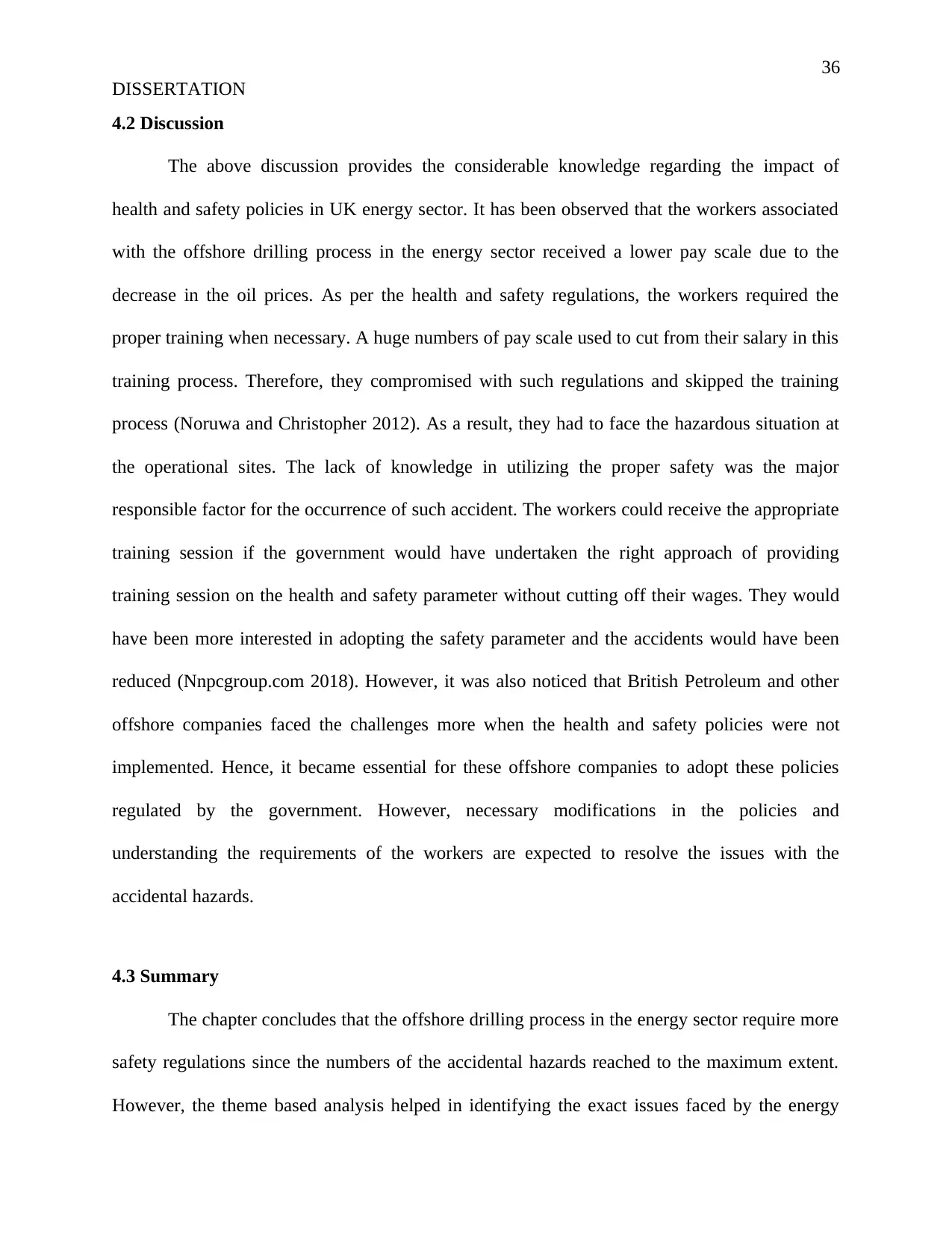
36
DISSERTATION
4.2 Discussion
The above discussion provides the considerable knowledge regarding the impact of
health and safety policies in UK energy sector. It has been observed that the workers associated
with the offshore drilling process in the energy sector received a lower pay scale due to the
decrease in the oil prices. As per the health and safety regulations, the workers required the
proper training when necessary. A huge numbers of pay scale used to cut from their salary in this
training process. Therefore, they compromised with such regulations and skipped the training
process (Noruwa and Christopher 2012). As a result, they had to face the hazardous situation at
the operational sites. The lack of knowledge in utilizing the proper safety was the major
responsible factor for the occurrence of such accident. The workers could receive the appropriate
training session if the government would have undertaken the right approach of providing
training session on the health and safety parameter without cutting off their wages. They would
have been more interested in adopting the safety parameter and the accidents would have been
reduced (Nnpcgroup.com 2018). However, it was also noticed that British Petroleum and other
offshore companies faced the challenges more when the health and safety policies were not
implemented. Hence, it became essential for these offshore companies to adopt these policies
regulated by the government. However, necessary modifications in the policies and
understanding the requirements of the workers are expected to resolve the issues with the
accidental hazards.
4.3 Summary
The chapter concludes that the offshore drilling process in the energy sector require more
safety regulations since the numbers of the accidental hazards reached to the maximum extent.
However, the theme based analysis helped in identifying the exact issues faced by the energy
DISSERTATION
4.2 Discussion
The above discussion provides the considerable knowledge regarding the impact of
health and safety policies in UK energy sector. It has been observed that the workers associated
with the offshore drilling process in the energy sector received a lower pay scale due to the
decrease in the oil prices. As per the health and safety regulations, the workers required the
proper training when necessary. A huge numbers of pay scale used to cut from their salary in this
training process. Therefore, they compromised with such regulations and skipped the training
process (Noruwa and Christopher 2012). As a result, they had to face the hazardous situation at
the operational sites. The lack of knowledge in utilizing the proper safety was the major
responsible factor for the occurrence of such accident. The workers could receive the appropriate
training session if the government would have undertaken the right approach of providing
training session on the health and safety parameter without cutting off their wages. They would
have been more interested in adopting the safety parameter and the accidents would have been
reduced (Nnpcgroup.com 2018). However, it was also noticed that British Petroleum and other
offshore companies faced the challenges more when the health and safety policies were not
implemented. Hence, it became essential for these offshore companies to adopt these policies
regulated by the government. However, necessary modifications in the policies and
understanding the requirements of the workers are expected to resolve the issues with the
accidental hazards.
4.3 Summary
The chapter concludes that the offshore drilling process in the energy sector require more
safety regulations since the numbers of the accidental hazards reached to the maximum extent.
However, the theme based analysis helped in identifying the exact issues faced by the energy
Secure Best Marks with AI Grader
Need help grading? Try our AI Grader for instant feedback on your assignments.
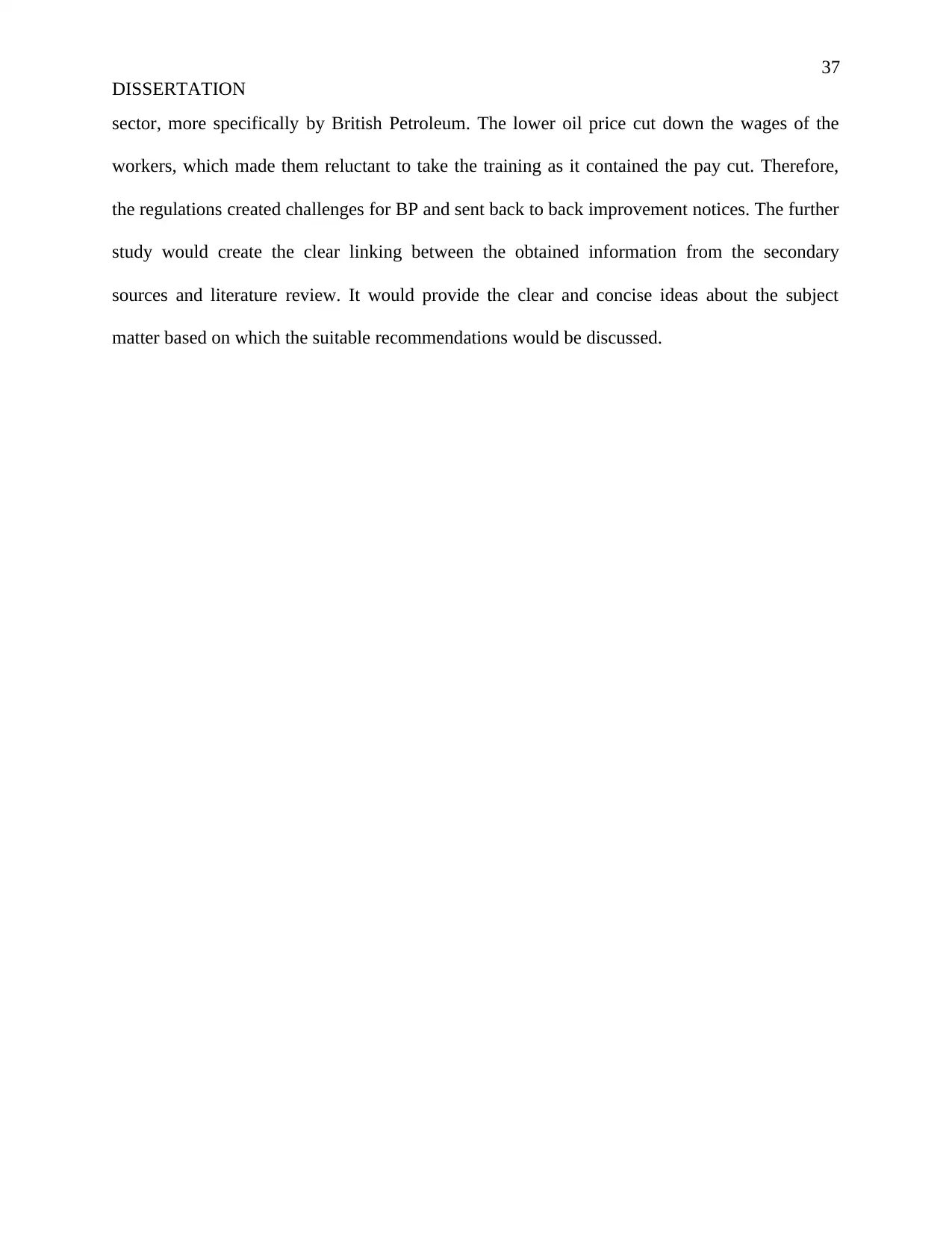
37
DISSERTATION
sector, more specifically by British Petroleum. The lower oil price cut down the wages of the
workers, which made them reluctant to take the training as it contained the pay cut. Therefore,
the regulations created challenges for BP and sent back to back improvement notices. The further
study would create the clear linking between the obtained information from the secondary
sources and literature review. It would provide the clear and concise ideas about the subject
matter based on which the suitable recommendations would be discussed.
DISSERTATION
sector, more specifically by British Petroleum. The lower oil price cut down the wages of the
workers, which made them reluctant to take the training as it contained the pay cut. Therefore,
the regulations created challenges for BP and sent back to back improvement notices. The further
study would create the clear linking between the obtained information from the secondary
sources and literature review. It would provide the clear and concise ideas about the subject
matter based on which the suitable recommendations would be discussed.
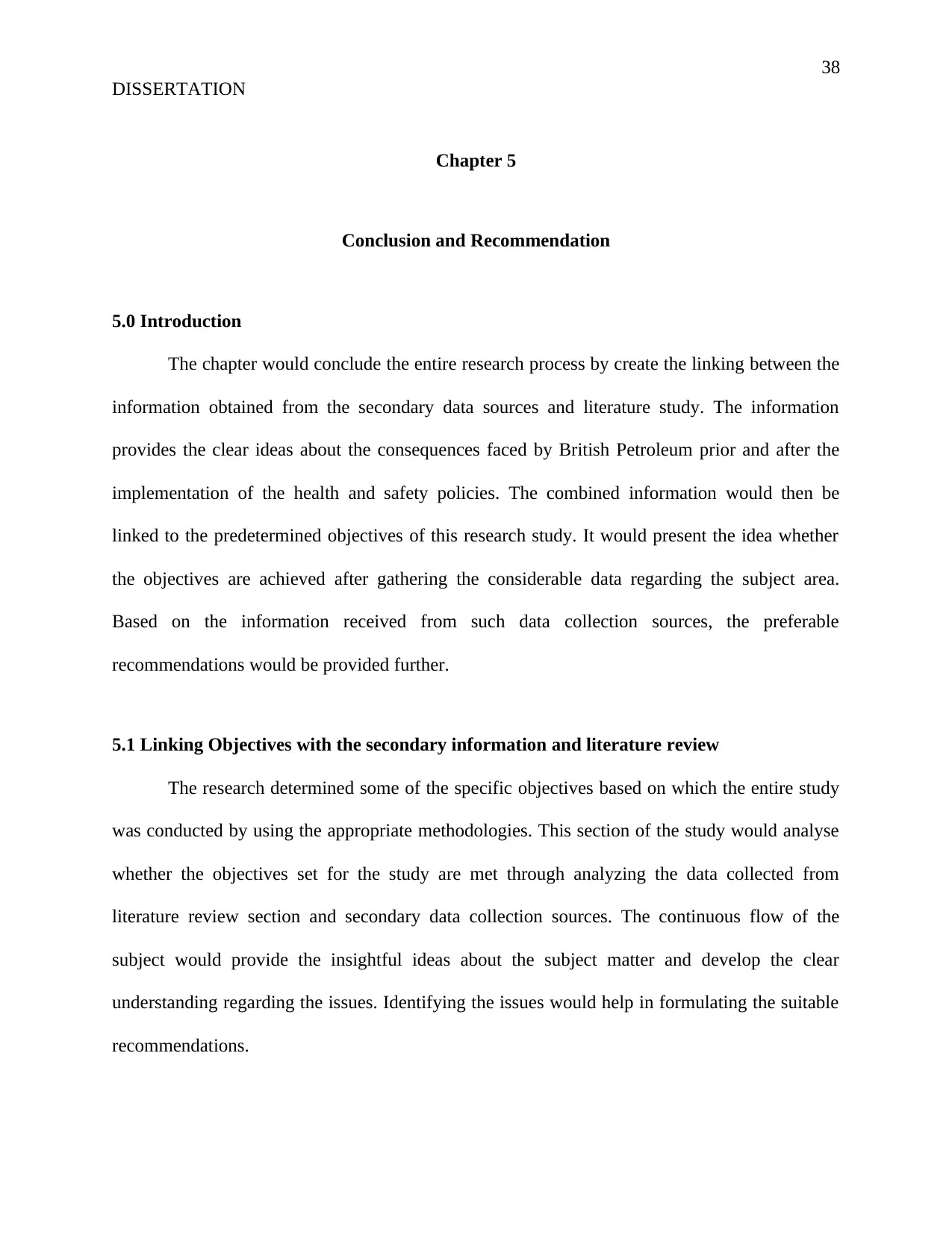
38
DISSERTATION
Chapter 5
Conclusion and Recommendation
5.0 Introduction
The chapter would conclude the entire research process by create the linking between the
information obtained from the secondary data sources and literature study. The information
provides the clear ideas about the consequences faced by British Petroleum prior and after the
implementation of the health and safety policies. The combined information would then be
linked to the predetermined objectives of this research study. It would present the idea whether
the objectives are achieved after gathering the considerable data regarding the subject area.
Based on the information received from such data collection sources, the preferable
recommendations would be provided further.
5.1 Linking Objectives with the secondary information and literature review
The research determined some of the specific objectives based on which the entire study
was conducted by using the appropriate methodologies. This section of the study would analyse
whether the objectives set for the study are met through analyzing the data collected from
literature review section and secondary data collection sources. The continuous flow of the
subject would provide the insightful ideas about the subject matter and develop the clear
understanding regarding the issues. Identifying the issues would help in formulating the suitable
recommendations.
DISSERTATION
Chapter 5
Conclusion and Recommendation
5.0 Introduction
The chapter would conclude the entire research process by create the linking between the
information obtained from the secondary data sources and literature study. The information
provides the clear ideas about the consequences faced by British Petroleum prior and after the
implementation of the health and safety policies. The combined information would then be
linked to the predetermined objectives of this research study. It would present the idea whether
the objectives are achieved after gathering the considerable data regarding the subject area.
Based on the information received from such data collection sources, the preferable
recommendations would be provided further.
5.1 Linking Objectives with the secondary information and literature review
The research determined some of the specific objectives based on which the entire study
was conducted by using the appropriate methodologies. This section of the study would analyse
whether the objectives set for the study are met through analyzing the data collected from
literature review section and secondary data collection sources. The continuous flow of the
subject would provide the insightful ideas about the subject matter and develop the clear
understanding regarding the issues. Identifying the issues would help in formulating the suitable
recommendations.
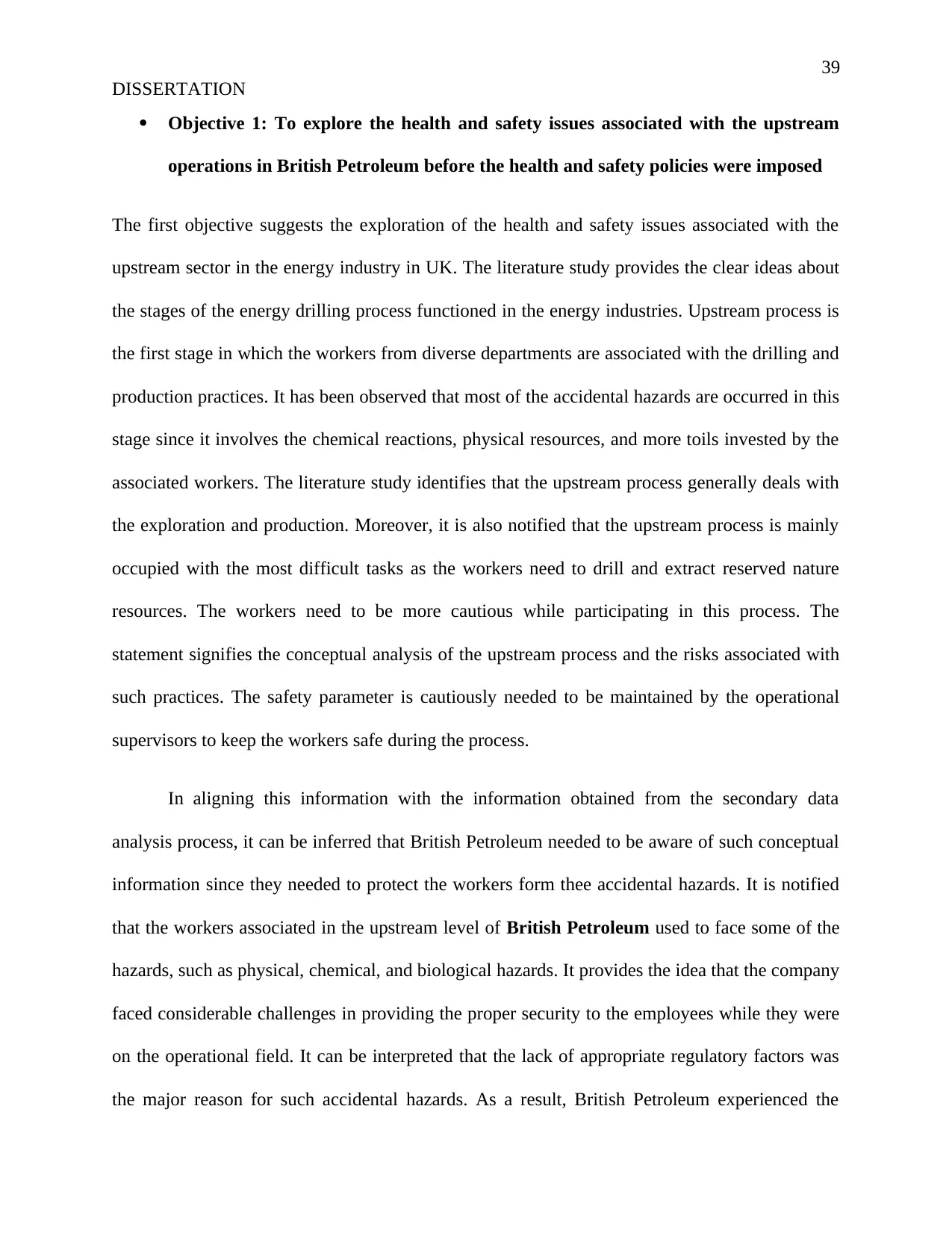
39
DISSERTATION
Objective 1: To explore the health and safety issues associated with the upstream
operations in British Petroleum before the health and safety policies were imposed
The first objective suggests the exploration of the health and safety issues associated with the
upstream sector in the energy industry in UK. The literature study provides the clear ideas about
the stages of the energy drilling process functioned in the energy industries. Upstream process is
the first stage in which the workers from diverse departments are associated with the drilling and
production practices. It has been observed that most of the accidental hazards are occurred in this
stage since it involves the chemical reactions, physical resources, and more toils invested by the
associated workers. The literature study identifies that the upstream process generally deals with
the exploration and production. Moreover, it is also notified that the upstream process is mainly
occupied with the most difficult tasks as the workers need to drill and extract reserved nature
resources. The workers need to be more cautious while participating in this process. The
statement signifies the conceptual analysis of the upstream process and the risks associated with
such practices. The safety parameter is cautiously needed to be maintained by the operational
supervisors to keep the workers safe during the process.
In aligning this information with the information obtained from the secondary data
analysis process, it can be inferred that British Petroleum needed to be aware of such conceptual
information since they needed to protect the workers form thee accidental hazards. It is notified
that the workers associated in the upstream level of British Petroleum used to face some of the
hazards, such as physical, chemical, and biological hazards. It provides the idea that the company
faced considerable challenges in providing the proper security to the employees while they were
on the operational field. It can be interpreted that the lack of appropriate regulatory factors was
the major reason for such accidental hazards. As a result, British Petroleum experienced the
DISSERTATION
Objective 1: To explore the health and safety issues associated with the upstream
operations in British Petroleum before the health and safety policies were imposed
The first objective suggests the exploration of the health and safety issues associated with the
upstream sector in the energy industry in UK. The literature study provides the clear ideas about
the stages of the energy drilling process functioned in the energy industries. Upstream process is
the first stage in which the workers from diverse departments are associated with the drilling and
production practices. It has been observed that most of the accidental hazards are occurred in this
stage since it involves the chemical reactions, physical resources, and more toils invested by the
associated workers. The literature study identifies that the upstream process generally deals with
the exploration and production. Moreover, it is also notified that the upstream process is mainly
occupied with the most difficult tasks as the workers need to drill and extract reserved nature
resources. The workers need to be more cautious while participating in this process. The
statement signifies the conceptual analysis of the upstream process and the risks associated with
such practices. The safety parameter is cautiously needed to be maintained by the operational
supervisors to keep the workers safe during the process.
In aligning this information with the information obtained from the secondary data
analysis process, it can be inferred that British Petroleum needed to be aware of such conceptual
information since they needed to protect the workers form thee accidental hazards. It is notified
that the workers associated in the upstream level of British Petroleum used to face some of the
hazards, such as physical, chemical, and biological hazards. It provides the idea that the company
faced considerable challenges in providing the proper security to the employees while they were
on the operational field. It can be interpreted that the lack of appropriate regulatory factors was
the major reason for such accidental hazards. As a result, British Petroleum experienced the
Paraphrase This Document
Need a fresh take? Get an instant paraphrase of this document with our AI Paraphraser
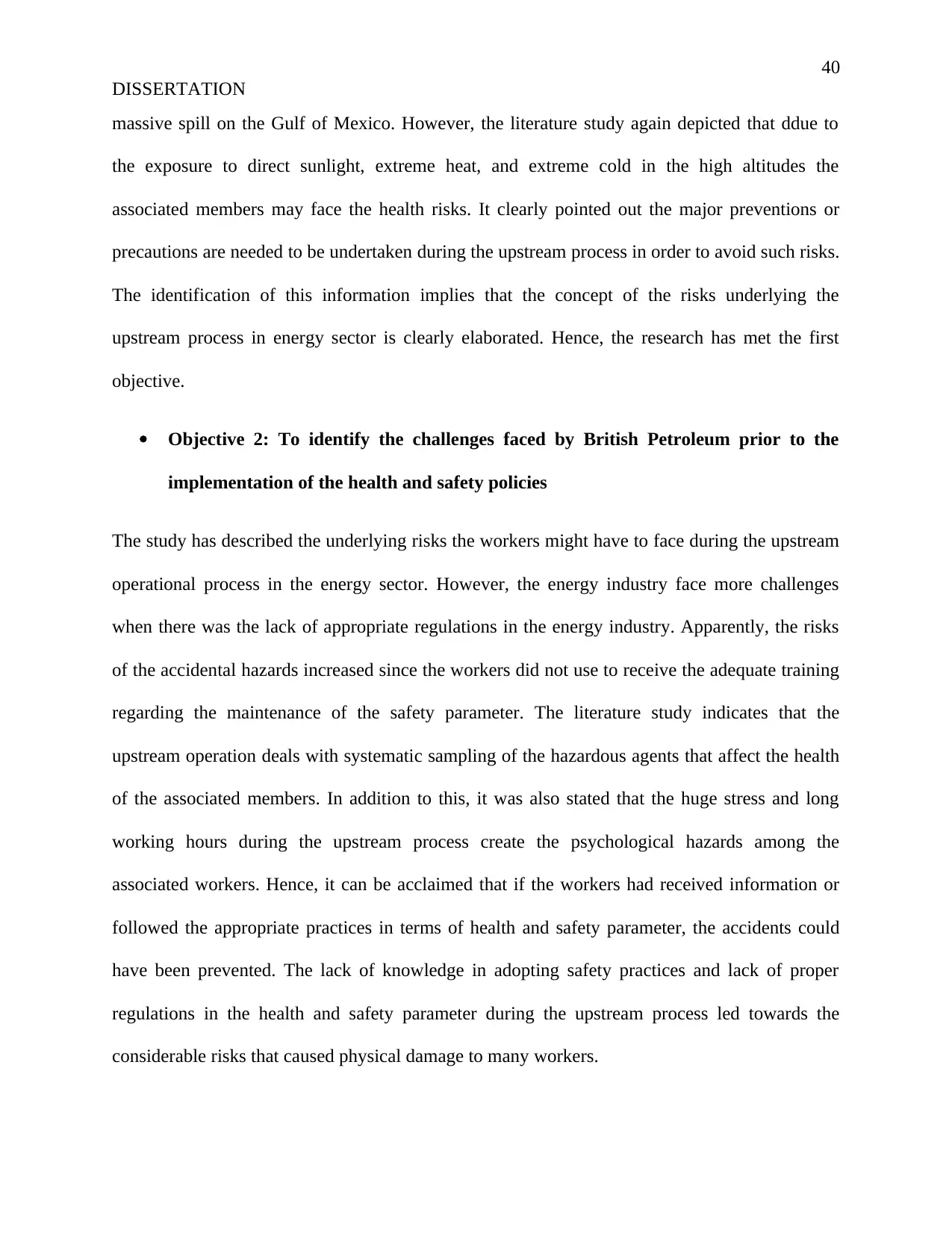
40
DISSERTATION
massive spill on the Gulf of Mexico. However, the literature study again depicted that ddue to
the exposure to direct sunlight, extreme heat, and extreme cold in the high altitudes the
associated members may face the health risks. It clearly pointed out the major preventions or
precautions are needed to be undertaken during the upstream process in order to avoid such risks.
The identification of this information implies that the concept of the risks underlying the
upstream process in energy sector is clearly elaborated. Hence, the research has met the first
objective.
Objective 2: To identify the challenges faced by British Petroleum prior to the
implementation of the health and safety policies
The study has described the underlying risks the workers might have to face during the upstream
operational process in the energy sector. However, the energy industry face more challenges
when there was the lack of appropriate regulations in the energy industry. Apparently, the risks
of the accidental hazards increased since the workers did not use to receive the adequate training
regarding the maintenance of the safety parameter. The literature study indicates that the
upstream operation deals with systematic sampling of the hazardous agents that affect the health
of the associated members. In addition to this, it was also stated that the huge stress and long
working hours during the upstream process create the psychological hazards among the
associated workers. Hence, it can be acclaimed that if the workers had received information or
followed the appropriate practices in terms of health and safety parameter, the accidents could
have been prevented. The lack of knowledge in adopting safety practices and lack of proper
regulations in the health and safety parameter during the upstream process led towards the
considerable risks that caused physical damage to many workers.
DISSERTATION
massive spill on the Gulf of Mexico. However, the literature study again depicted that ddue to
the exposure to direct sunlight, extreme heat, and extreme cold in the high altitudes the
associated members may face the health risks. It clearly pointed out the major preventions or
precautions are needed to be undertaken during the upstream process in order to avoid such risks.
The identification of this information implies that the concept of the risks underlying the
upstream process in energy sector is clearly elaborated. Hence, the research has met the first
objective.
Objective 2: To identify the challenges faced by British Petroleum prior to the
implementation of the health and safety policies
The study has described the underlying risks the workers might have to face during the upstream
operational process in the energy sector. However, the energy industry face more challenges
when there was the lack of appropriate regulations in the energy industry. Apparently, the risks
of the accidental hazards increased since the workers did not use to receive the adequate training
regarding the maintenance of the safety parameter. The literature study indicates that the
upstream operation deals with systematic sampling of the hazardous agents that affect the health
of the associated members. In addition to this, it was also stated that the huge stress and long
working hours during the upstream process create the psychological hazards among the
associated workers. Hence, it can be acclaimed that if the workers had received information or
followed the appropriate practices in terms of health and safety parameter, the accidents could
have been prevented. The lack of knowledge in adopting safety practices and lack of proper
regulations in the health and safety parameter during the upstream process led towards the
considerable risks that caused physical damage to many workers.
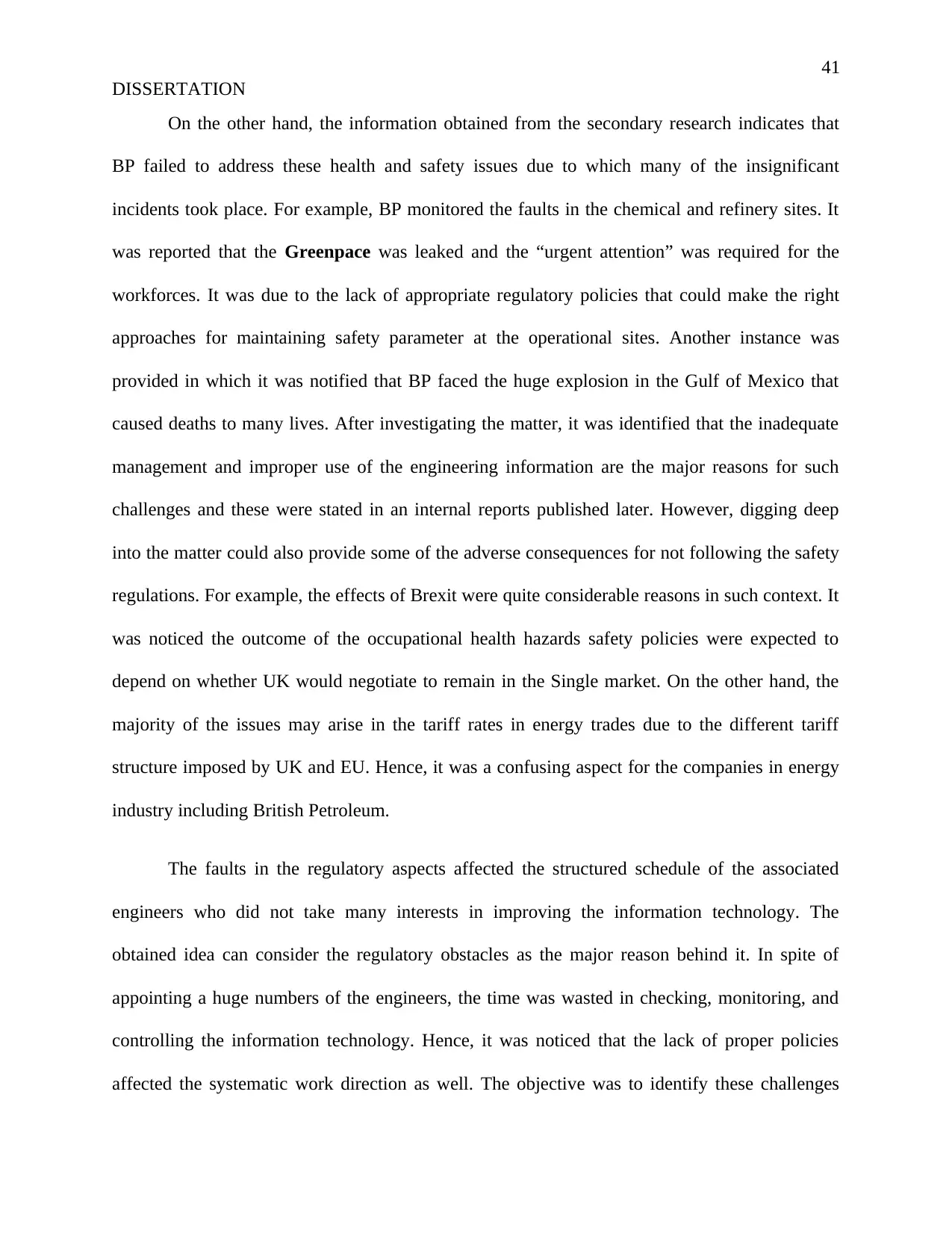
41
DISSERTATION
On the other hand, the information obtained from the secondary research indicates that
BP failed to address these health and safety issues due to which many of the insignificant
incidents took place. For example, BP monitored the faults in the chemical and refinery sites. It
was reported that the Greenpace was leaked and the “urgent attention” was required for the
workforces. It was due to the lack of appropriate regulatory policies that could make the right
approaches for maintaining safety parameter at the operational sites. Another instance was
provided in which it was notified that BP faced the huge explosion in the Gulf of Mexico that
caused deaths to many lives. After investigating the matter, it was identified that the inadequate
management and improper use of the engineering information are the major reasons for such
challenges and these were stated in an internal reports published later. However, digging deep
into the matter could also provide some of the adverse consequences for not following the safety
regulations. For example, the effects of Brexit were quite considerable reasons in such context. It
was noticed the outcome of the occupational health hazards safety policies were expected to
depend on whether UK would negotiate to remain in the Single market. On the other hand, the
majority of the issues may arise in the tariff rates in energy trades due to the different tariff
structure imposed by UK and EU. Hence, it was a confusing aspect for the companies in energy
industry including British Petroleum.
The faults in the regulatory aspects affected the structured schedule of the associated
engineers who did not take many interests in improving the information technology. The
obtained idea can consider the regulatory obstacles as the major reason behind it. In spite of
appointing a huge numbers of the engineers, the time was wasted in checking, monitoring, and
controlling the information technology. Hence, it was noticed that the lack of proper policies
affected the systematic work direction as well. The objective was to identify these challenges
DISSERTATION
On the other hand, the information obtained from the secondary research indicates that
BP failed to address these health and safety issues due to which many of the insignificant
incidents took place. For example, BP monitored the faults in the chemical and refinery sites. It
was reported that the Greenpace was leaked and the “urgent attention” was required for the
workforces. It was due to the lack of appropriate regulatory policies that could make the right
approaches for maintaining safety parameter at the operational sites. Another instance was
provided in which it was notified that BP faced the huge explosion in the Gulf of Mexico that
caused deaths to many lives. After investigating the matter, it was identified that the inadequate
management and improper use of the engineering information are the major reasons for such
challenges and these were stated in an internal reports published later. However, digging deep
into the matter could also provide some of the adverse consequences for not following the safety
regulations. For example, the effects of Brexit were quite considerable reasons in such context. It
was noticed the outcome of the occupational health hazards safety policies were expected to
depend on whether UK would negotiate to remain in the Single market. On the other hand, the
majority of the issues may arise in the tariff rates in energy trades due to the different tariff
structure imposed by UK and EU. Hence, it was a confusing aspect for the companies in energy
industry including British Petroleum.
The faults in the regulatory aspects affected the structured schedule of the associated
engineers who did not take many interests in improving the information technology. The
obtained idea can consider the regulatory obstacles as the major reason behind it. In spite of
appointing a huge numbers of the engineers, the time was wasted in checking, monitoring, and
controlling the information technology. Hence, it was noticed that the lack of proper policies
affected the systematic work direction as well. The objective was to identify these challenges
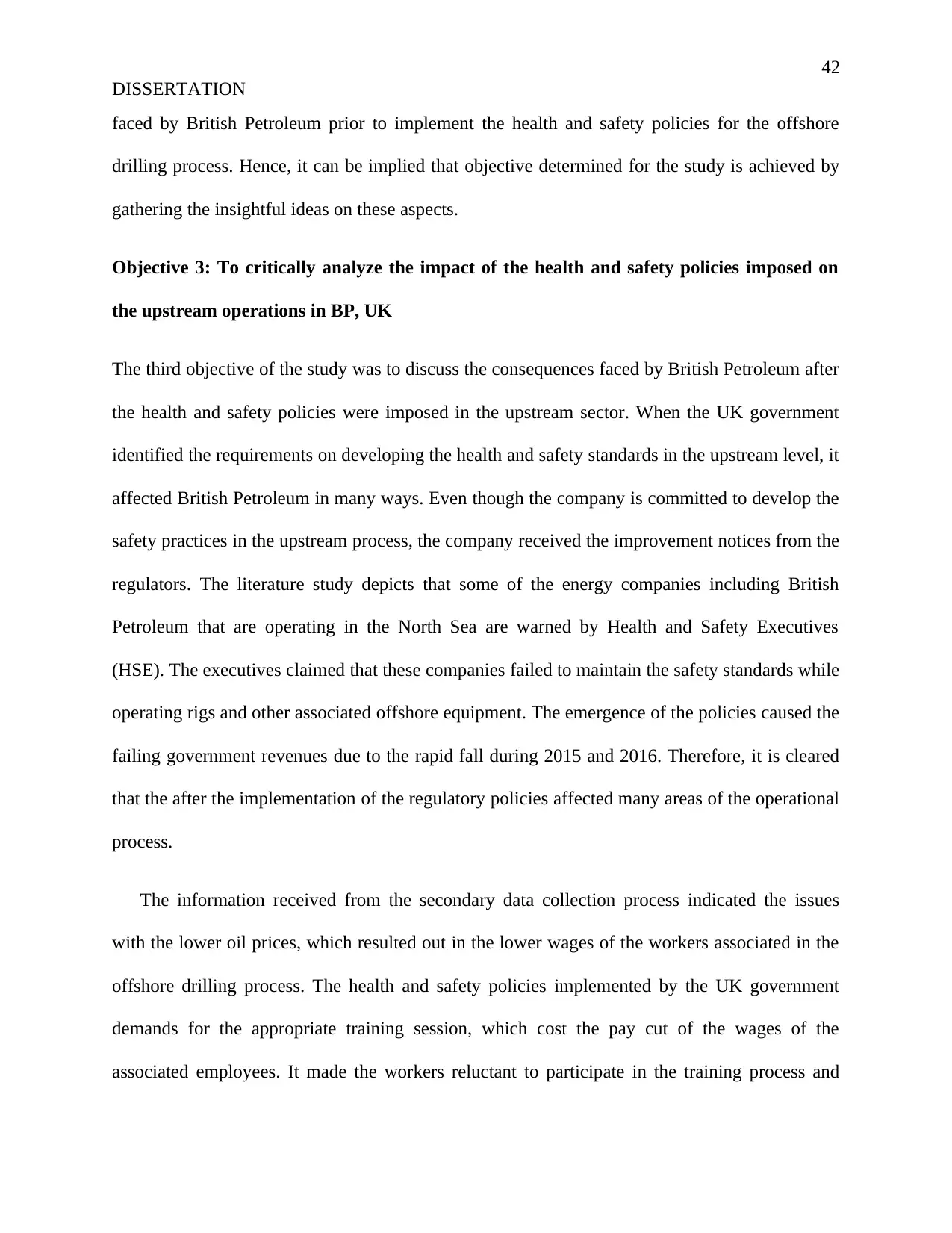
42
DISSERTATION
faced by British Petroleum prior to implement the health and safety policies for the offshore
drilling process. Hence, it can be implied that objective determined for the study is achieved by
gathering the insightful ideas on these aspects.
Objective 3: To critically analyze the impact of the health and safety policies imposed on
the upstream operations in BP, UK
The third objective of the study was to discuss the consequences faced by British Petroleum after
the health and safety policies were imposed in the upstream sector. When the UK government
identified the requirements on developing the health and safety standards in the upstream level, it
affected British Petroleum in many ways. Even though the company is committed to develop the
safety practices in the upstream process, the company received the improvement notices from the
regulators. The literature study depicts that some of the energy companies including British
Petroleum that are operating in the North Sea are warned by Health and Safety Executives
(HSE). The executives claimed that these companies failed to maintain the safety standards while
operating rigs and other associated offshore equipment. The emergence of the policies caused the
failing government revenues due to the rapid fall during 2015 and 2016. Therefore, it is cleared
that the after the implementation of the regulatory policies affected many areas of the operational
process.
The information received from the secondary data collection process indicated the issues
with the lower oil prices, which resulted out in the lower wages of the workers associated in the
offshore drilling process. The health and safety policies implemented by the UK government
demands for the appropriate training session, which cost the pay cut of the wages of the
associated employees. It made the workers reluctant to participate in the training process and
DISSERTATION
faced by British Petroleum prior to implement the health and safety policies for the offshore
drilling process. Hence, it can be implied that objective determined for the study is achieved by
gathering the insightful ideas on these aspects.
Objective 3: To critically analyze the impact of the health and safety policies imposed on
the upstream operations in BP, UK
The third objective of the study was to discuss the consequences faced by British Petroleum after
the health and safety policies were imposed in the upstream sector. When the UK government
identified the requirements on developing the health and safety standards in the upstream level, it
affected British Petroleum in many ways. Even though the company is committed to develop the
safety practices in the upstream process, the company received the improvement notices from the
regulators. The literature study depicts that some of the energy companies including British
Petroleum that are operating in the North Sea are warned by Health and Safety Executives
(HSE). The executives claimed that these companies failed to maintain the safety standards while
operating rigs and other associated offshore equipment. The emergence of the policies caused the
failing government revenues due to the rapid fall during 2015 and 2016. Therefore, it is cleared
that the after the implementation of the regulatory policies affected many areas of the operational
process.
The information received from the secondary data collection process indicated the issues
with the lower oil prices, which resulted out in the lower wages of the workers associated in the
offshore drilling process. The health and safety policies implemented by the UK government
demands for the appropriate training session, which cost the pay cut of the wages of the
associated employees. It made the workers reluctant to participate in the training process and
Secure Best Marks with AI Grader
Need help grading? Try our AI Grader for instant feedback on your assignments.
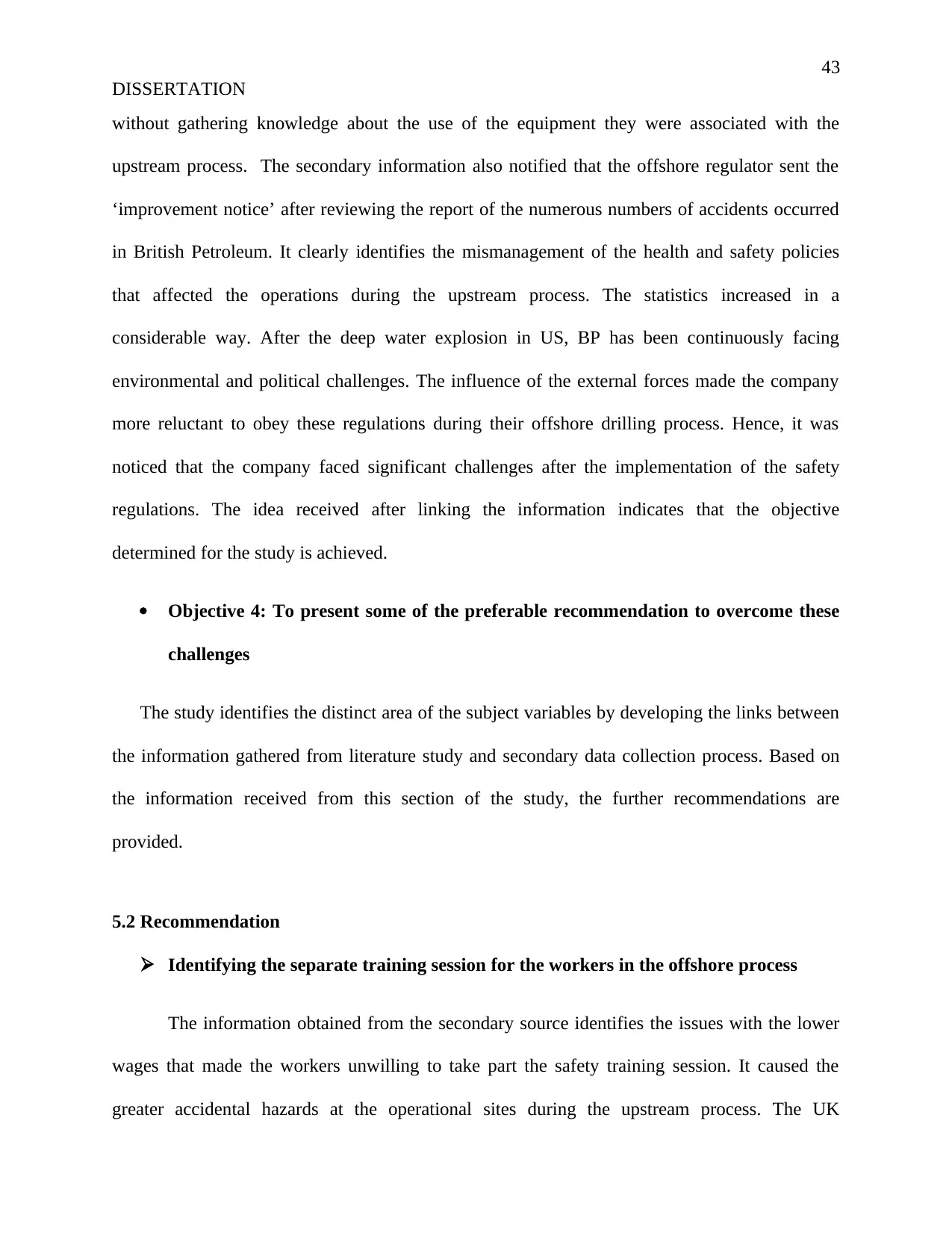
43
DISSERTATION
without gathering knowledge about the use of the equipment they were associated with the
upstream process. The secondary information also notified that the offshore regulator sent the
‘improvement notice’ after reviewing the report of the numerous numbers of accidents occurred
in British Petroleum. It clearly identifies the mismanagement of the health and safety policies
that affected the operations during the upstream process. The statistics increased in a
considerable way. After the deep water explosion in US, BP has been continuously facing
environmental and political challenges. The influence of the external forces made the company
more reluctant to obey these regulations during their offshore drilling process. Hence, it was
noticed that the company faced significant challenges after the implementation of the safety
regulations. The idea received after linking the information indicates that the objective
determined for the study is achieved.
Objective 4: To present some of the preferable recommendation to overcome these
challenges
The study identifies the distinct area of the subject variables by developing the links between
the information gathered from literature study and secondary data collection process. Based on
the information received from this section of the study, the further recommendations are
provided.
5.2 Recommendation
Identifying the separate training session for the workers in the offshore process
The information obtained from the secondary source identifies the issues with the lower
wages that made the workers unwilling to take part the safety training session. It caused the
greater accidental hazards at the operational sites during the upstream process. The UK
DISSERTATION
without gathering knowledge about the use of the equipment they were associated with the
upstream process. The secondary information also notified that the offshore regulator sent the
‘improvement notice’ after reviewing the report of the numerous numbers of accidents occurred
in British Petroleum. It clearly identifies the mismanagement of the health and safety policies
that affected the operations during the upstream process. The statistics increased in a
considerable way. After the deep water explosion in US, BP has been continuously facing
environmental and political challenges. The influence of the external forces made the company
more reluctant to obey these regulations during their offshore drilling process. Hence, it was
noticed that the company faced significant challenges after the implementation of the safety
regulations. The idea received after linking the information indicates that the objective
determined for the study is achieved.
Objective 4: To present some of the preferable recommendation to overcome these
challenges
The study identifies the distinct area of the subject variables by developing the links between
the information gathered from literature study and secondary data collection process. Based on
the information received from this section of the study, the further recommendations are
provided.
5.2 Recommendation
Identifying the separate training session for the workers in the offshore process
The information obtained from the secondary source identifies the issues with the lower
wages that made the workers unwilling to take part the safety training session. It caused the
greater accidental hazards at the operational sites during the upstream process. The UK
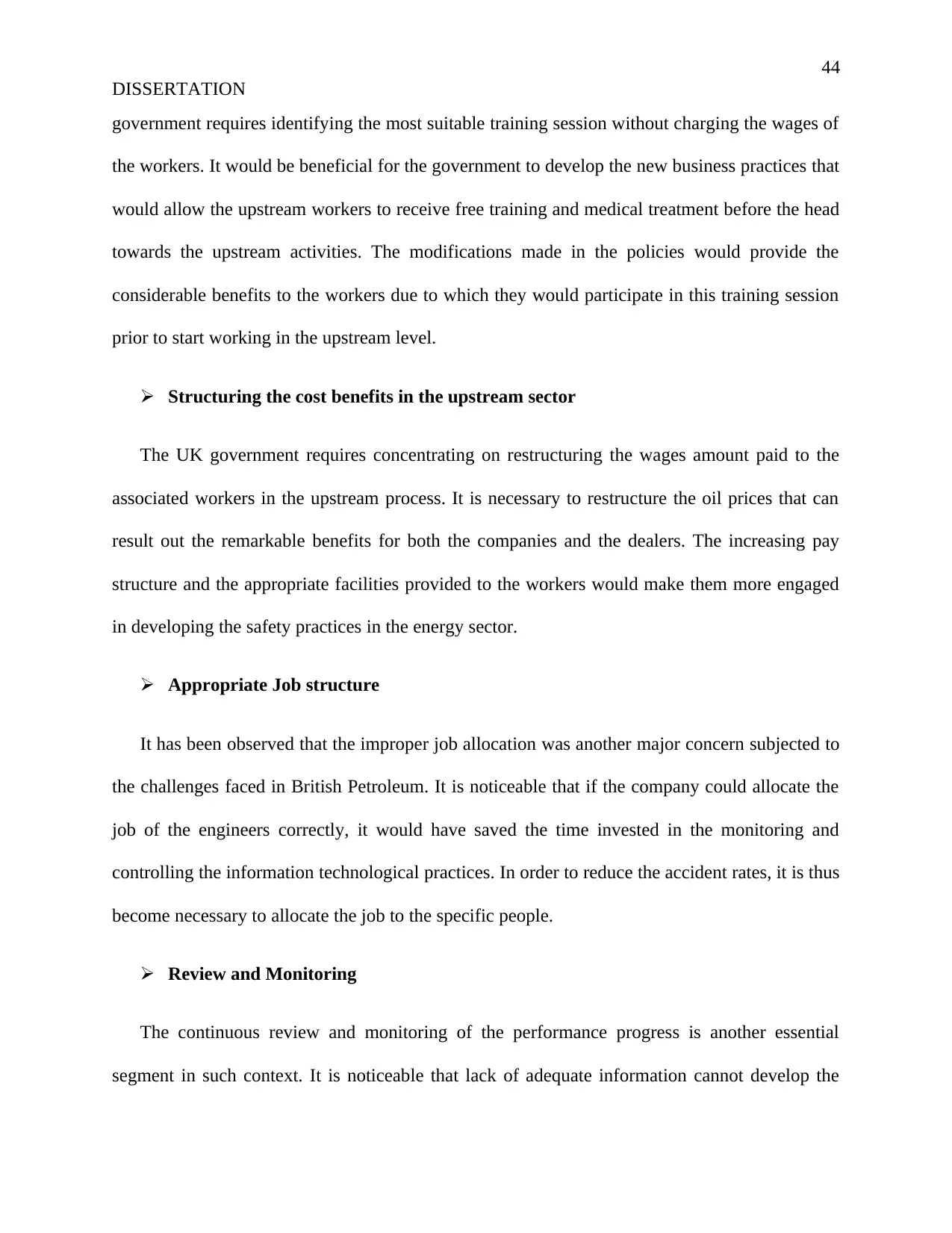
44
DISSERTATION
government requires identifying the most suitable training session without charging the wages of
the workers. It would be beneficial for the government to develop the new business practices that
would allow the upstream workers to receive free training and medical treatment before the head
towards the upstream activities. The modifications made in the policies would provide the
considerable benefits to the workers due to which they would participate in this training session
prior to start working in the upstream level.
Structuring the cost benefits in the upstream sector
The UK government requires concentrating on restructuring the wages amount paid to the
associated workers in the upstream process. It is necessary to restructure the oil prices that can
result out the remarkable benefits for both the companies and the dealers. The increasing pay
structure and the appropriate facilities provided to the workers would make them more engaged
in developing the safety practices in the energy sector.
Appropriate Job structure
It has been observed that the improper job allocation was another major concern subjected to
the challenges faced in British Petroleum. It is noticeable that if the company could allocate the
job of the engineers correctly, it would have saved the time invested in the monitoring and
controlling the information technological practices. In order to reduce the accident rates, it is thus
become necessary to allocate the job to the specific people.
Review and Monitoring
The continuous review and monitoring of the performance progress is another essential
segment in such context. It is noticeable that lack of adequate information cannot develop the
DISSERTATION
government requires identifying the most suitable training session without charging the wages of
the workers. It would be beneficial for the government to develop the new business practices that
would allow the upstream workers to receive free training and medical treatment before the head
towards the upstream activities. The modifications made in the policies would provide the
considerable benefits to the workers due to which they would participate in this training session
prior to start working in the upstream level.
Structuring the cost benefits in the upstream sector
The UK government requires concentrating on restructuring the wages amount paid to the
associated workers in the upstream process. It is necessary to restructure the oil prices that can
result out the remarkable benefits for both the companies and the dealers. The increasing pay
structure and the appropriate facilities provided to the workers would make them more engaged
in developing the safety practices in the energy sector.
Appropriate Job structure
It has been observed that the improper job allocation was another major concern subjected to
the challenges faced in British Petroleum. It is noticeable that if the company could allocate the
job of the engineers correctly, it would have saved the time invested in the monitoring and
controlling the information technological practices. In order to reduce the accident rates, it is thus
become necessary to allocate the job to the specific people.
Review and Monitoring
The continuous review and monitoring of the performance progress is another essential
segment in such context. It is noticeable that lack of adequate information cannot develop the

45
DISSERTATION
proper cautions regarding the safety issues. Therefore, it is essential to continuous review,
monitoring, and modifying the practices to observe the progress and develop the better practices.
It would prevent the accidental hazards at the operational sites in a more specific way.
5.3 Future Scope of the Study
The information gathered from the secondary sources would be used by the other
researchers for conducting the similar study. The literature section explores the conceptual
analysis of the work practices in the upstream process that clarifies the idea of the associated
health and safety hazards. Identifying these specific issues, the future researchers would also
apply the relevant techniques of conducting major subject area. The information would be
fruitful enough to develop the insightful knowledge in a significant way.
DISSERTATION
proper cautions regarding the safety issues. Therefore, it is essential to continuous review,
monitoring, and modifying the practices to observe the progress and develop the better practices.
It would prevent the accidental hazards at the operational sites in a more specific way.
5.3 Future Scope of the Study
The information gathered from the secondary sources would be used by the other
researchers for conducting the similar study. The literature section explores the conceptual
analysis of the work practices in the upstream process that clarifies the idea of the associated
health and safety hazards. Identifying these specific issues, the future researchers would also
apply the relevant techniques of conducting major subject area. The information would be
fruitful enough to develop the insightful knowledge in a significant way.
Paraphrase This Document
Need a fresh take? Get an instant paraphrase of this document with our AI Paraphraser
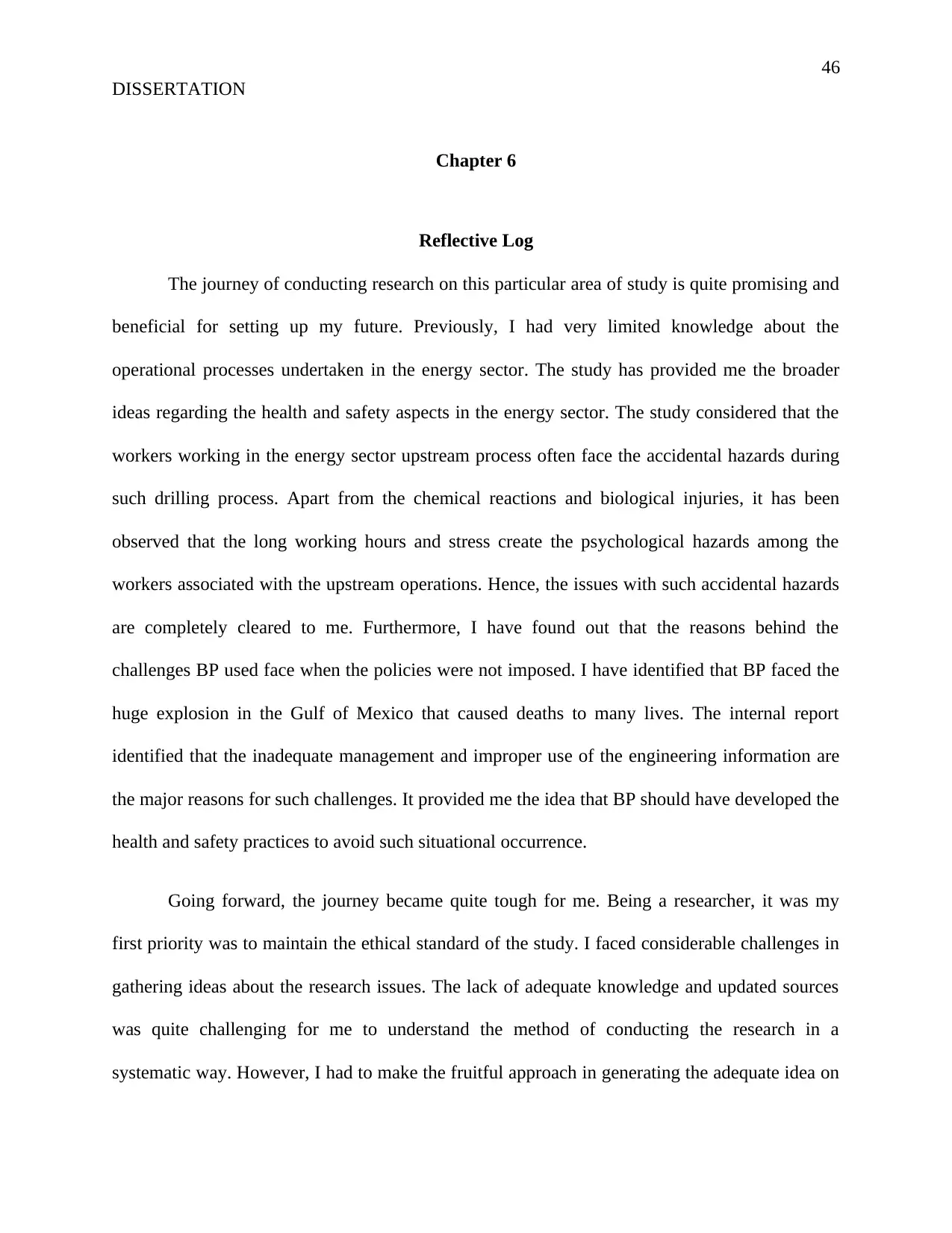
46
DISSERTATION
Chapter 6
Reflective Log
The journey of conducting research on this particular area of study is quite promising and
beneficial for setting up my future. Previously, I had very limited knowledge about the
operational processes undertaken in the energy sector. The study has provided me the broader
ideas regarding the health and safety aspects in the energy sector. The study considered that the
workers working in the energy sector upstream process often face the accidental hazards during
such drilling process. Apart from the chemical reactions and biological injuries, it has been
observed that the long working hours and stress create the psychological hazards among the
workers associated with the upstream operations. Hence, the issues with such accidental hazards
are completely cleared to me. Furthermore, I have found out that the reasons behind the
challenges BP used face when the policies were not imposed. I have identified that BP faced the
huge explosion in the Gulf of Mexico that caused deaths to many lives. The internal report
identified that the inadequate management and improper use of the engineering information are
the major reasons for such challenges. It provided me the idea that BP should have developed the
health and safety practices to avoid such situational occurrence.
Going forward, the journey became quite tough for me. Being a researcher, it was my
first priority was to maintain the ethical standard of the study. I faced considerable challenges in
gathering ideas about the research issues. The lack of adequate knowledge and updated sources
was quite challenging for me to understand the method of conducting the research in a
systematic way. However, I had to make the fruitful approach in generating the adequate idea on
DISSERTATION
Chapter 6
Reflective Log
The journey of conducting research on this particular area of study is quite promising and
beneficial for setting up my future. Previously, I had very limited knowledge about the
operational processes undertaken in the energy sector. The study has provided me the broader
ideas regarding the health and safety aspects in the energy sector. The study considered that the
workers working in the energy sector upstream process often face the accidental hazards during
such drilling process. Apart from the chemical reactions and biological injuries, it has been
observed that the long working hours and stress create the psychological hazards among the
workers associated with the upstream operations. Hence, the issues with such accidental hazards
are completely cleared to me. Furthermore, I have found out that the reasons behind the
challenges BP used face when the policies were not imposed. I have identified that BP faced the
huge explosion in the Gulf of Mexico that caused deaths to many lives. The internal report
identified that the inadequate management and improper use of the engineering information are
the major reasons for such challenges. It provided me the idea that BP should have developed the
health and safety practices to avoid such situational occurrence.
Going forward, the journey became quite tough for me. Being a researcher, it was my
first priority was to maintain the ethical standard of the study. I faced considerable challenges in
gathering ideas about the research issues. The lack of adequate knowledge and updated sources
was quite challenging for me to understand the method of conducting the research in a
systematic way. However, I had to make the fruitful approach in generating the adequate idea on
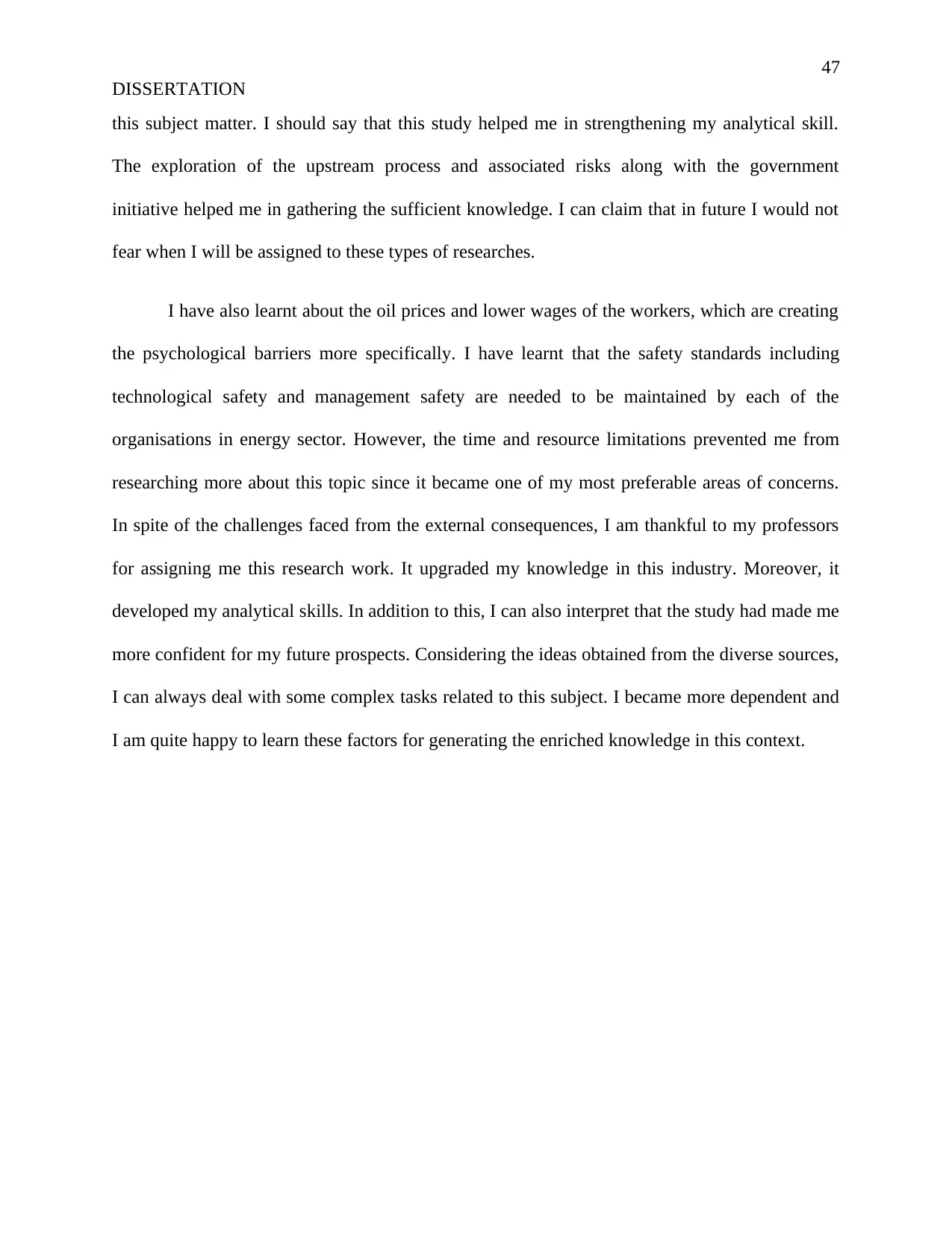
47
DISSERTATION
this subject matter. I should say that this study helped me in strengthening my analytical skill.
The exploration of the upstream process and associated risks along with the government
initiative helped me in gathering the sufficient knowledge. I can claim that in future I would not
fear when I will be assigned to these types of researches.
I have also learnt about the oil prices and lower wages of the workers, which are creating
the psychological barriers more specifically. I have learnt that the safety standards including
technological safety and management safety are needed to be maintained by each of the
organisations in energy sector. However, the time and resource limitations prevented me from
researching more about this topic since it became one of my most preferable areas of concerns.
In spite of the challenges faced from the external consequences, I am thankful to my professors
for assigning me this research work. It upgraded my knowledge in this industry. Moreover, it
developed my analytical skills. In addition to this, I can also interpret that the study had made me
more confident for my future prospects. Considering the ideas obtained from the diverse sources,
I can always deal with some complex tasks related to this subject. I became more dependent and
I am quite happy to learn these factors for generating the enriched knowledge in this context.
DISSERTATION
this subject matter. I should say that this study helped me in strengthening my analytical skill.
The exploration of the upstream process and associated risks along with the government
initiative helped me in gathering the sufficient knowledge. I can claim that in future I would not
fear when I will be assigned to these types of researches.
I have also learnt about the oil prices and lower wages of the workers, which are creating
the psychological barriers more specifically. I have learnt that the safety standards including
technological safety and management safety are needed to be maintained by each of the
organisations in energy sector. However, the time and resource limitations prevented me from
researching more about this topic since it became one of my most preferable areas of concerns.
In spite of the challenges faced from the external consequences, I am thankful to my professors
for assigning me this research work. It upgraded my knowledge in this industry. Moreover, it
developed my analytical skills. In addition to this, I can also interpret that the study had made me
more confident for my future prospects. Considering the ideas obtained from the diverse sources,
I can always deal with some complex tasks related to this subject. I became more dependent and
I am quite happy to learn these factors for generating the enriched knowledge in this context.
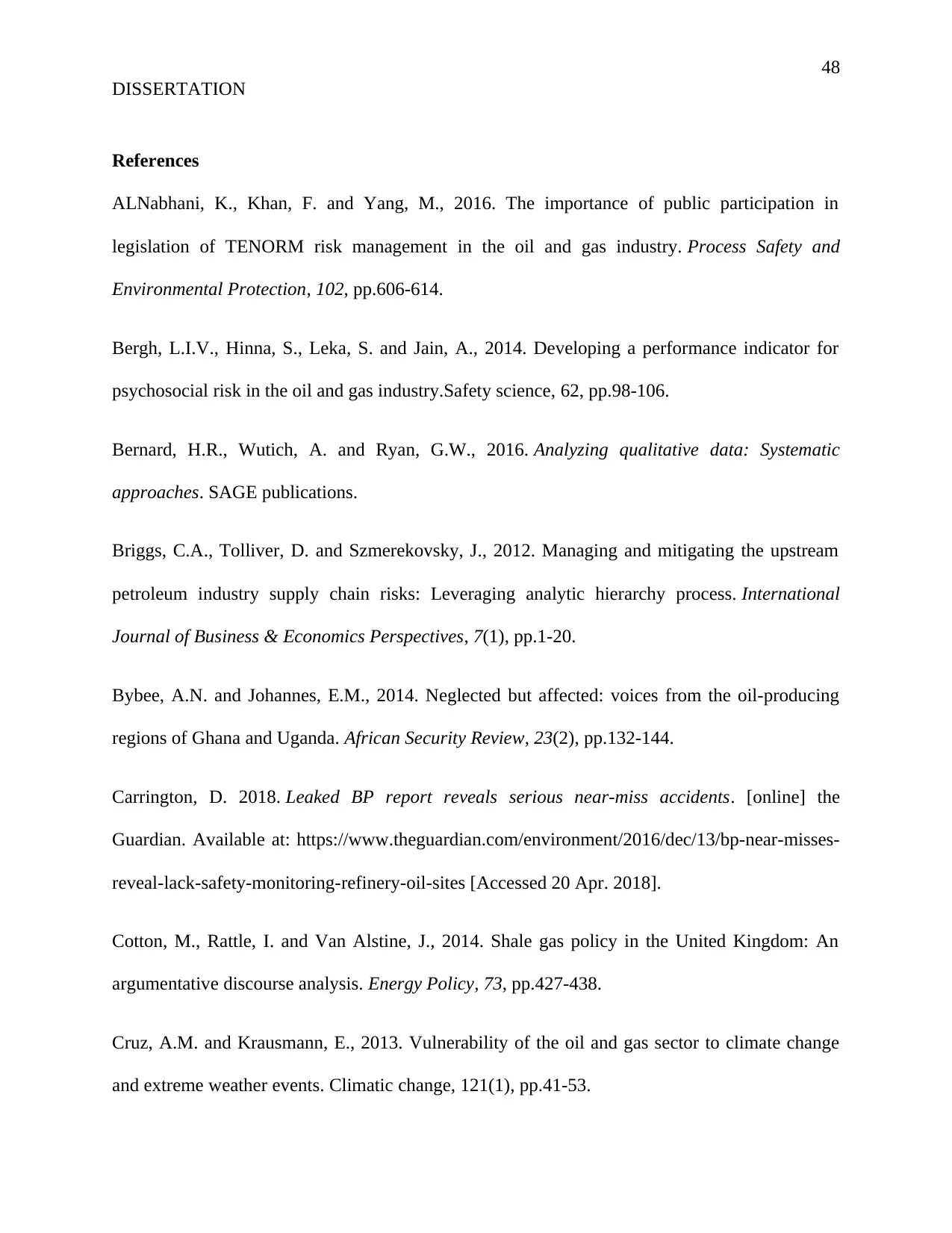
48
DISSERTATION
References
ALNabhani, K., Khan, F. and Yang, M., 2016. The importance of public participation in
legislation of TENORM risk management in the oil and gas industry. Process Safety and
Environmental Protection, 102, pp.606-614.
Bergh, L.I.V., Hinna, S., Leka, S. and Jain, A., 2014. Developing a performance indicator for
psychosocial risk in the oil and gas industry.Safety science, 62, pp.98-106.
Bernard, H.R., Wutich, A. and Ryan, G.W., 2016. Analyzing qualitative data: Systematic
approaches. SAGE publications.
Briggs, C.A., Tolliver, D. and Szmerekovsky, J., 2012. Managing and mitigating the upstream
petroleum industry supply chain risks: Leveraging analytic hierarchy process. International
Journal of Business & Economics Perspectives, 7(1), pp.1-20.
Bybee, A.N. and Johannes, E.M., 2014. Neglected but affected: voices from the oil-producing
regions of Ghana and Uganda. African Security Review, 23(2), pp.132-144.
Carrington, D. 2018. Leaked BP report reveals serious near-miss accidents. [online] the
Guardian. Available at: https://www.theguardian.com/environment/2016/dec/13/bp-near-misses-
reveal-lack-safety-monitoring-refinery-oil-sites [Accessed 20 Apr. 2018].
Cotton, M., Rattle, I. and Van Alstine, J., 2014. Shale gas policy in the United Kingdom: An
argumentative discourse analysis. Energy Policy, 73, pp.427-438.
Cruz, A.M. and Krausmann, E., 2013. Vulnerability of the oil and gas sector to climate change
and extreme weather events. Climatic change, 121(1), pp.41-53.
DISSERTATION
References
ALNabhani, K., Khan, F. and Yang, M., 2016. The importance of public participation in
legislation of TENORM risk management in the oil and gas industry. Process Safety and
Environmental Protection, 102, pp.606-614.
Bergh, L.I.V., Hinna, S., Leka, S. and Jain, A., 2014. Developing a performance indicator for
psychosocial risk in the oil and gas industry.Safety science, 62, pp.98-106.
Bernard, H.R., Wutich, A. and Ryan, G.W., 2016. Analyzing qualitative data: Systematic
approaches. SAGE publications.
Briggs, C.A., Tolliver, D. and Szmerekovsky, J., 2012. Managing and mitigating the upstream
petroleum industry supply chain risks: Leveraging analytic hierarchy process. International
Journal of Business & Economics Perspectives, 7(1), pp.1-20.
Bybee, A.N. and Johannes, E.M., 2014. Neglected but affected: voices from the oil-producing
regions of Ghana and Uganda. African Security Review, 23(2), pp.132-144.
Carrington, D. 2018. Leaked BP report reveals serious near-miss accidents. [online] the
Guardian. Available at: https://www.theguardian.com/environment/2016/dec/13/bp-near-misses-
reveal-lack-safety-monitoring-refinery-oil-sites [Accessed 20 Apr. 2018].
Cotton, M., Rattle, I. and Van Alstine, J., 2014. Shale gas policy in the United Kingdom: An
argumentative discourse analysis. Energy Policy, 73, pp.427-438.
Cruz, A.M. and Krausmann, E., 2013. Vulnerability of the oil and gas sector to climate change
and extreme weather events. Climatic change, 121(1), pp.41-53.
Secure Best Marks with AI Grader
Need help grading? Try our AI Grader for instant feedback on your assignments.
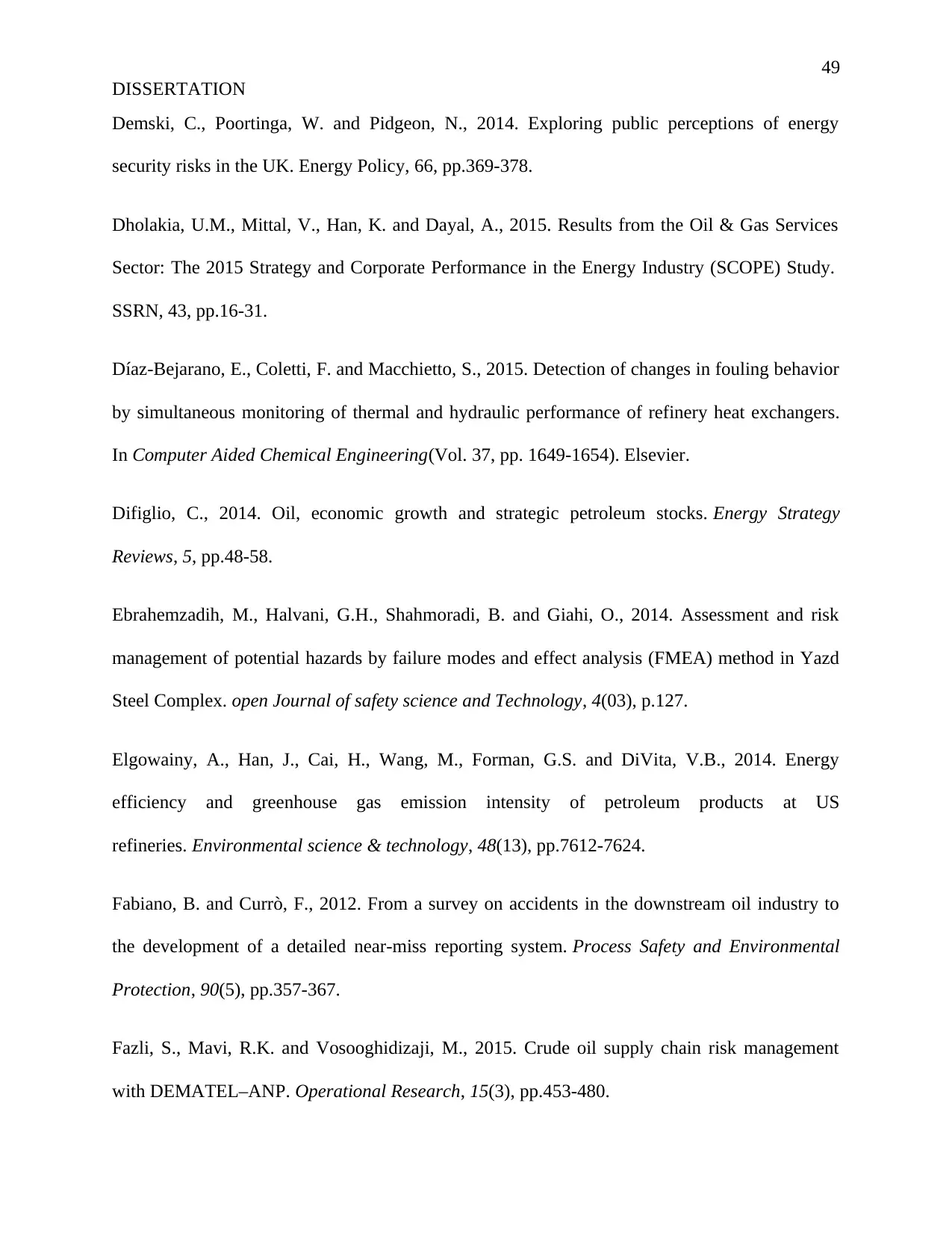
49
DISSERTATION
Demski, C., Poortinga, W. and Pidgeon, N., 2014. Exploring public perceptions of energy
security risks in the UK. Energy Policy, 66, pp.369-378.
Dholakia, U.M., Mittal, V., Han, K. and Dayal, A., 2015. Results from the Oil & Gas Services
Sector: The 2015 Strategy and Corporate Performance in the Energy Industry (SCOPE) Study.
SSRN, 43, pp.16-31.
Díaz-Bejarano, E., Coletti, F. and Macchietto, S., 2015. Detection of changes in fouling behavior
by simultaneous monitoring of thermal and hydraulic performance of refinery heat exchangers.
In Computer Aided Chemical Engineering(Vol. 37, pp. 1649-1654). Elsevier.
Difiglio, C., 2014. Oil, economic growth and strategic petroleum stocks. Energy Strategy
Reviews, 5, pp.48-58.
Ebrahemzadih, M., Halvani, G.H., Shahmoradi, B. and Giahi, O., 2014. Assessment and risk
management of potential hazards by failure modes and effect analysis (FMEA) method in Yazd
Steel Complex. open Journal of safety science and Technology, 4(03), p.127.
Elgowainy, A., Han, J., Cai, H., Wang, M., Forman, G.S. and DiVita, V.B., 2014. Energy
efficiency and greenhouse gas emission intensity of petroleum products at US
refineries. Environmental science & technology, 48(13), pp.7612-7624.
Fabiano, B. and Currò, F., 2012. From a survey on accidents in the downstream oil industry to
the development of a detailed near-miss reporting system. Process Safety and Environmental
Protection, 90(5), pp.357-367.
Fazli, S., Mavi, R.K. and Vosooghidizaji, M., 2015. Crude oil supply chain risk management
with DEMATEL–ANP. Operational Research, 15(3), pp.453-480.
DISSERTATION
Demski, C., Poortinga, W. and Pidgeon, N., 2014. Exploring public perceptions of energy
security risks in the UK. Energy Policy, 66, pp.369-378.
Dholakia, U.M., Mittal, V., Han, K. and Dayal, A., 2015. Results from the Oil & Gas Services
Sector: The 2015 Strategy and Corporate Performance in the Energy Industry (SCOPE) Study.
SSRN, 43, pp.16-31.
Díaz-Bejarano, E., Coletti, F. and Macchietto, S., 2015. Detection of changes in fouling behavior
by simultaneous monitoring of thermal and hydraulic performance of refinery heat exchangers.
In Computer Aided Chemical Engineering(Vol. 37, pp. 1649-1654). Elsevier.
Difiglio, C., 2014. Oil, economic growth and strategic petroleum stocks. Energy Strategy
Reviews, 5, pp.48-58.
Ebrahemzadih, M., Halvani, G.H., Shahmoradi, B. and Giahi, O., 2014. Assessment and risk
management of potential hazards by failure modes and effect analysis (FMEA) method in Yazd
Steel Complex. open Journal of safety science and Technology, 4(03), p.127.
Elgowainy, A., Han, J., Cai, H., Wang, M., Forman, G.S. and DiVita, V.B., 2014. Energy
efficiency and greenhouse gas emission intensity of petroleum products at US
refineries. Environmental science & technology, 48(13), pp.7612-7624.
Fabiano, B. and Currò, F., 2012. From a survey on accidents in the downstream oil industry to
the development of a detailed near-miss reporting system. Process Safety and Environmental
Protection, 90(5), pp.357-367.
Fazli, S., Mavi, R.K. and Vosooghidizaji, M., 2015. Crude oil supply chain risk management
with DEMATEL–ANP. Operational Research, 15(3), pp.453-480.
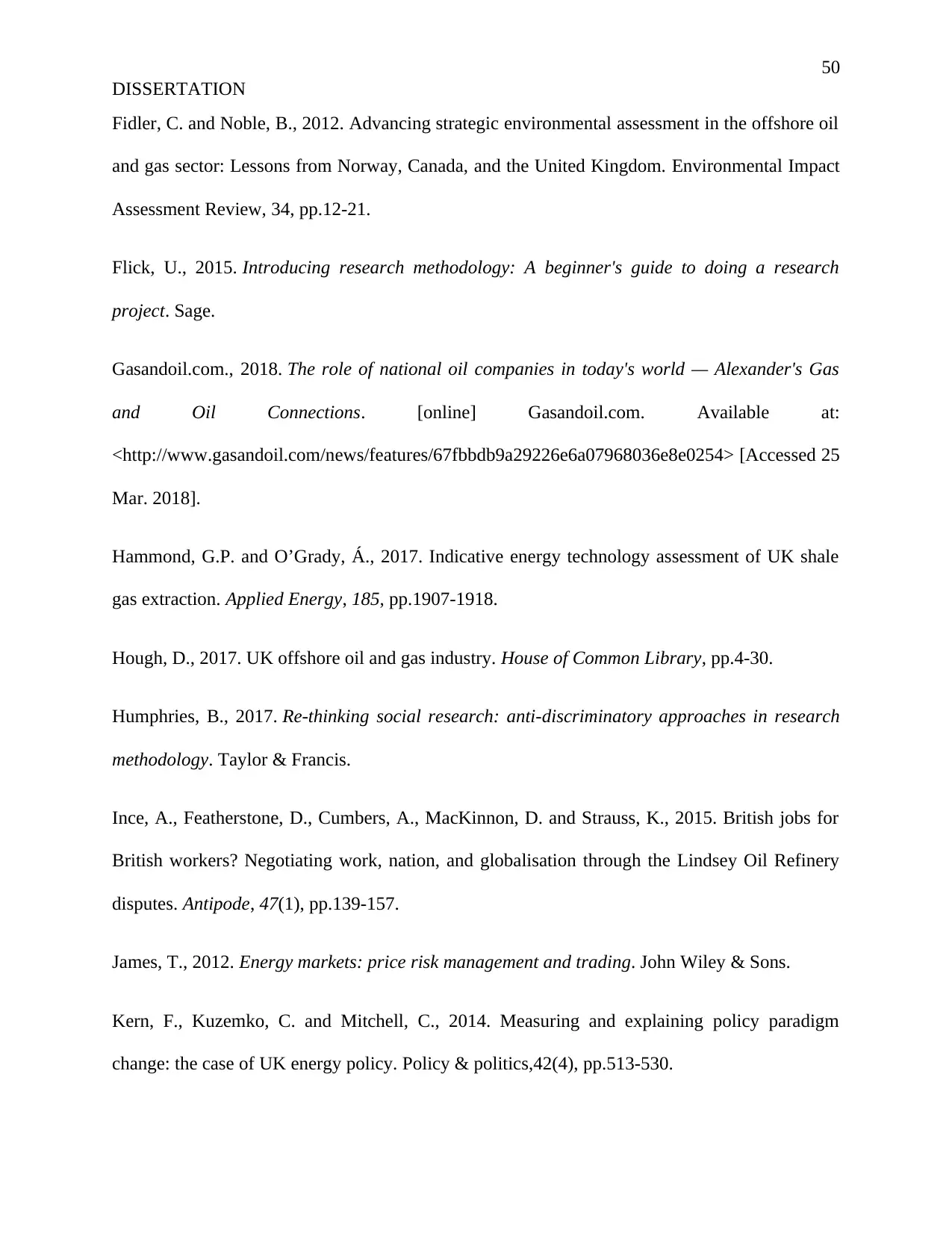
50
DISSERTATION
Fidler, C. and Noble, B., 2012. Advancing strategic environmental assessment in the offshore oil
and gas sector: Lessons from Norway, Canada, and the United Kingdom. Environmental Impact
Assessment Review, 34, pp.12-21.
Flick, U., 2015. Introducing research methodology: A beginner's guide to doing a research
project. Sage.
Gasandoil.com., 2018. The role of national oil companies in today's world — Alexander's Gas
and Oil Connections. [online] Gasandoil.com. Available at:
<http://www.gasandoil.com/news/features/67fbbdb9a29226e6a07968036e8e0254> [Accessed 25
Mar. 2018].
Hammond, G.P. and O’Grady, Á., 2017. Indicative energy technology assessment of UK shale
gas extraction. Applied Energy, 185, pp.1907-1918.
Hough, D., 2017. UK offshore oil and gas industry. House of Common Library, pp.4-30.
Humphries, B., 2017. Re-thinking social research: anti-discriminatory approaches in research
methodology. Taylor & Francis.
Ince, A., Featherstone, D., Cumbers, A., MacKinnon, D. and Strauss, K., 2015. British jobs for
British workers? Negotiating work, nation, and globalisation through the Lindsey Oil Refinery
disputes. Antipode, 47(1), pp.139-157.
James, T., 2012. Energy markets: price risk management and trading. John Wiley & Sons.
Kern, F., Kuzemko, C. and Mitchell, C., 2014. Measuring and explaining policy paradigm
change: the case of UK energy policy. Policy & politics,42(4), pp.513-530.
DISSERTATION
Fidler, C. and Noble, B., 2012. Advancing strategic environmental assessment in the offshore oil
and gas sector: Lessons from Norway, Canada, and the United Kingdom. Environmental Impact
Assessment Review, 34, pp.12-21.
Flick, U., 2015. Introducing research methodology: A beginner's guide to doing a research
project. Sage.
Gasandoil.com., 2018. The role of national oil companies in today's world — Alexander's Gas
and Oil Connections. [online] Gasandoil.com. Available at:
<http://www.gasandoil.com/news/features/67fbbdb9a29226e6a07968036e8e0254> [Accessed 25
Mar. 2018].
Hammond, G.P. and O’Grady, Á., 2017. Indicative energy technology assessment of UK shale
gas extraction. Applied Energy, 185, pp.1907-1918.
Hough, D., 2017. UK offshore oil and gas industry. House of Common Library, pp.4-30.
Humphries, B., 2017. Re-thinking social research: anti-discriminatory approaches in research
methodology. Taylor & Francis.
Ince, A., Featherstone, D., Cumbers, A., MacKinnon, D. and Strauss, K., 2015. British jobs for
British workers? Negotiating work, nation, and globalisation through the Lindsey Oil Refinery
disputes. Antipode, 47(1), pp.139-157.
James, T., 2012. Energy markets: price risk management and trading. John Wiley & Sons.
Kern, F., Kuzemko, C. and Mitchell, C., 2014. Measuring and explaining policy paradigm
change: the case of UK energy policy. Policy & politics,42(4), pp.513-530.
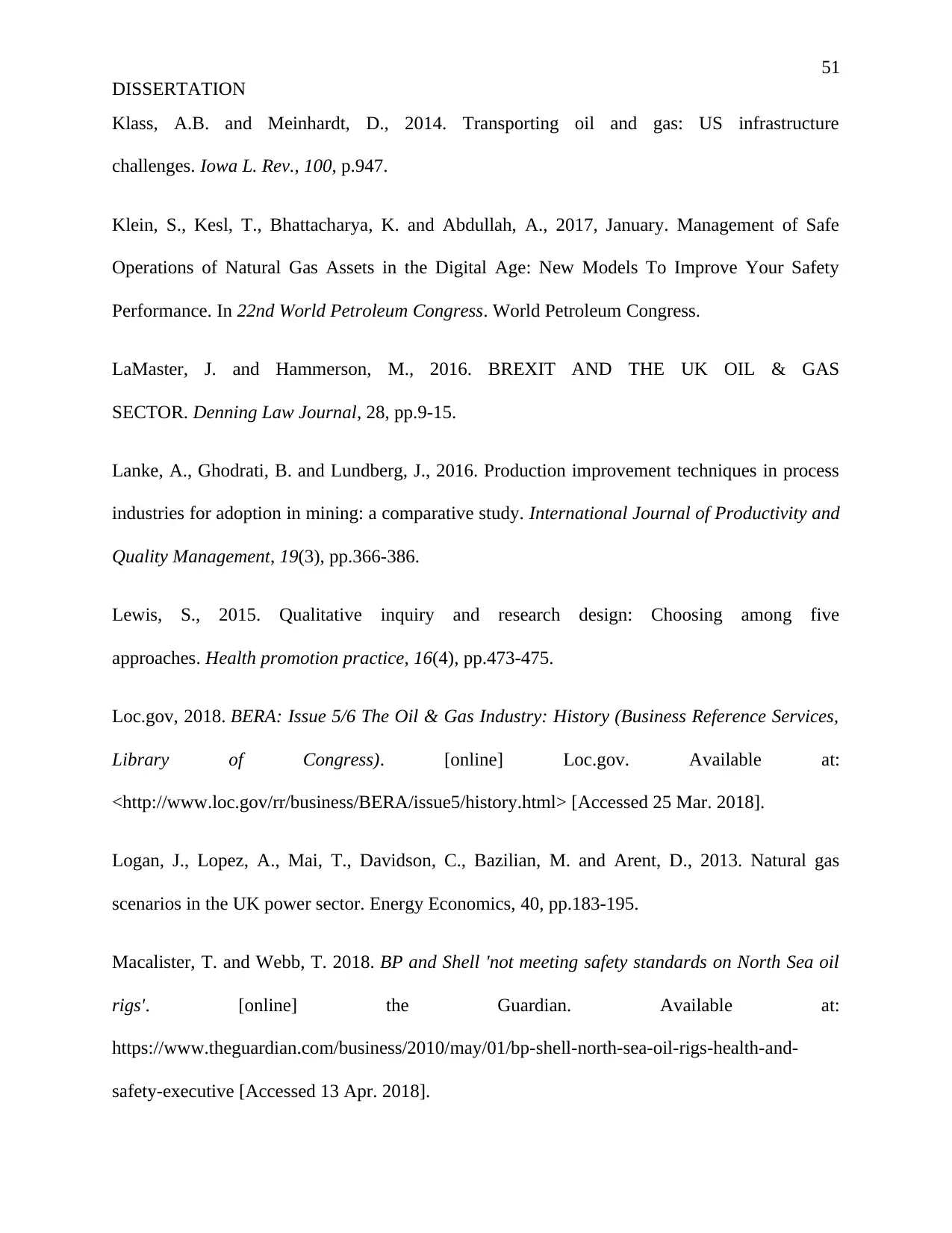
51
DISSERTATION
Klass, A.B. and Meinhardt, D., 2014. Transporting oil and gas: US infrastructure
challenges. Iowa L. Rev., 100, p.947.
Klein, S., Kesl, T., Bhattacharya, K. and Abdullah, A., 2017, January. Management of Safe
Operations of Natural Gas Assets in the Digital Age: New Models To Improve Your Safety
Performance. In 22nd World Petroleum Congress. World Petroleum Congress.
LaMaster, J. and Hammerson, M., 2016. BREXIT AND THE UK OIL & GAS
SECTOR. Denning Law Journal, 28, pp.9-15.
Lanke, A., Ghodrati, B. and Lundberg, J., 2016. Production improvement techniques in process
industries for adoption in mining: a comparative study. International Journal of Productivity and
Quality Management, 19(3), pp.366-386.
Lewis, S., 2015. Qualitative inquiry and research design: Choosing among five
approaches. Health promotion practice, 16(4), pp.473-475.
Loc.gov, 2018. BERA: Issue 5/6 The Oil & Gas Industry: History (Business Reference Services,
Library of Congress). [online] Loc.gov. Available at:
<http://www.loc.gov/rr/business/BERA/issue5/history.html> [Accessed 25 Mar. 2018].
Logan, J., Lopez, A., Mai, T., Davidson, C., Bazilian, M. and Arent, D., 2013. Natural gas
scenarios in the UK power sector. Energy Economics, 40, pp.183-195.
Macalister, T. and Webb, T. 2018. BP and Shell 'not meeting safety standards on North Sea oil
rigs'. [online] the Guardian. Available at:
https://www.theguardian.com/business/2010/may/01/bp-shell-north-sea-oil-rigs-health-and-
safety-executive [Accessed 13 Apr. 2018].
DISSERTATION
Klass, A.B. and Meinhardt, D., 2014. Transporting oil and gas: US infrastructure
challenges. Iowa L. Rev., 100, p.947.
Klein, S., Kesl, T., Bhattacharya, K. and Abdullah, A., 2017, January. Management of Safe
Operations of Natural Gas Assets in the Digital Age: New Models To Improve Your Safety
Performance. In 22nd World Petroleum Congress. World Petroleum Congress.
LaMaster, J. and Hammerson, M., 2016. BREXIT AND THE UK OIL & GAS
SECTOR. Denning Law Journal, 28, pp.9-15.
Lanke, A., Ghodrati, B. and Lundberg, J., 2016. Production improvement techniques in process
industries for adoption in mining: a comparative study. International Journal of Productivity and
Quality Management, 19(3), pp.366-386.
Lewis, S., 2015. Qualitative inquiry and research design: Choosing among five
approaches. Health promotion practice, 16(4), pp.473-475.
Loc.gov, 2018. BERA: Issue 5/6 The Oil & Gas Industry: History (Business Reference Services,
Library of Congress). [online] Loc.gov. Available at:
<http://www.loc.gov/rr/business/BERA/issue5/history.html> [Accessed 25 Mar. 2018].
Logan, J., Lopez, A., Mai, T., Davidson, C., Bazilian, M. and Arent, D., 2013. Natural gas
scenarios in the UK power sector. Energy Economics, 40, pp.183-195.
Macalister, T. and Webb, T. 2018. BP and Shell 'not meeting safety standards on North Sea oil
rigs'. [online] the Guardian. Available at:
https://www.theguardian.com/business/2010/may/01/bp-shell-north-sea-oil-rigs-health-and-
safety-executive [Accessed 13 Apr. 2018].
Paraphrase This Document
Need a fresh take? Get an instant paraphrase of this document with our AI Paraphraser
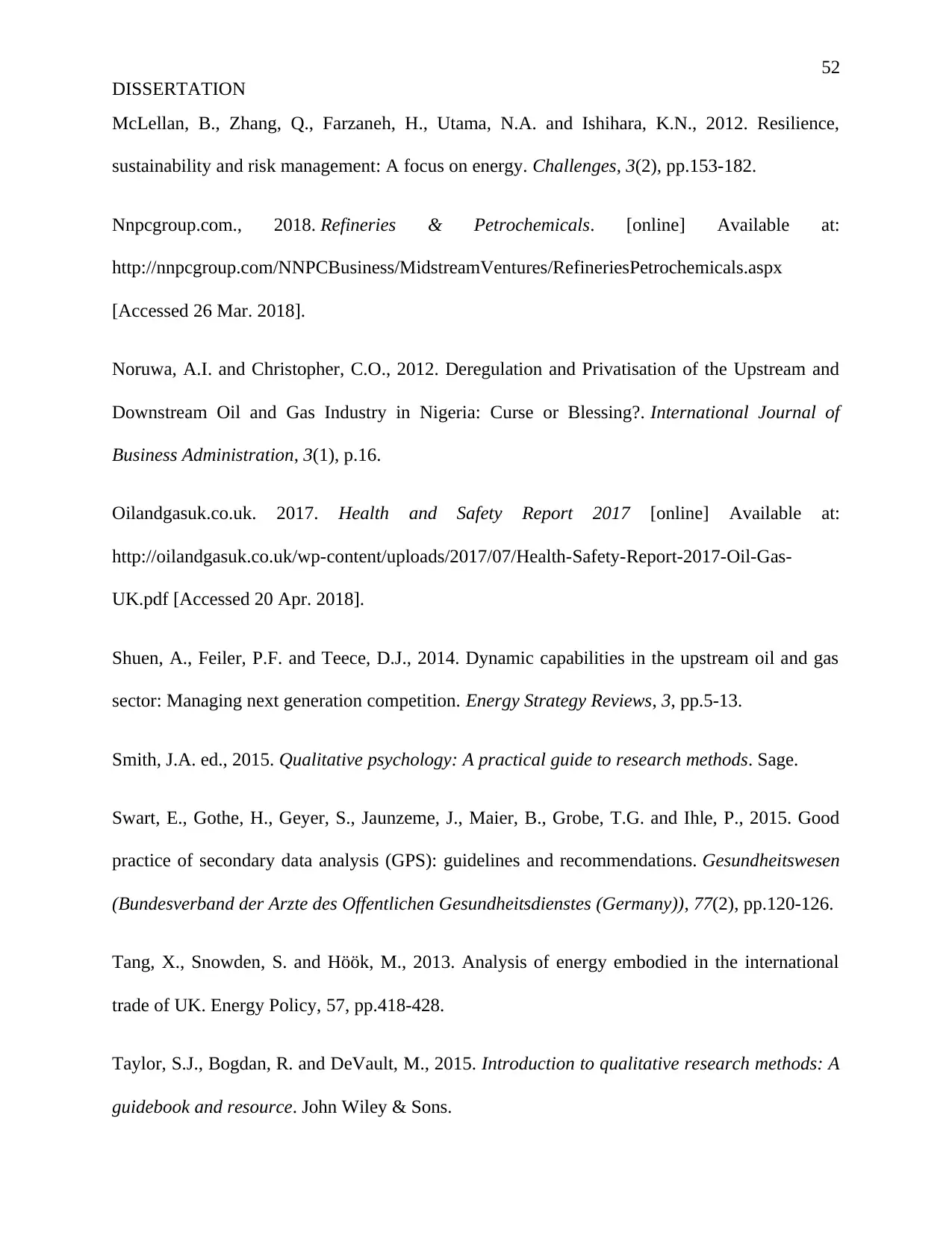
52
DISSERTATION
McLellan, B., Zhang, Q., Farzaneh, H., Utama, N.A. and Ishihara, K.N., 2012. Resilience,
sustainability and risk management: A focus on energy. Challenges, 3(2), pp.153-182.
Nnpcgroup.com., 2018. Refineries & Petrochemicals. [online] Available at:
http://nnpcgroup.com/NNPCBusiness/MidstreamVentures/RefineriesPetrochemicals.aspx
[Accessed 26 Mar. 2018].
Noruwa, A.I. and Christopher, C.O., 2012. Deregulation and Privatisation of the Upstream and
Downstream Oil and Gas Industry in Nigeria: Curse or Blessing?. International Journal of
Business Administration, 3(1), p.16.
Oilandgasuk.co.uk. 2017. Health and Safety Report 2017 [online] Available at:
http://oilandgasuk.co.uk/wp-content/uploads/2017/07/Health-Safety-Report-2017-Oil-Gas-
UK.pdf [Accessed 20 Apr. 2018].
Shuen, A., Feiler, P.F. and Teece, D.J., 2014. Dynamic capabilities in the upstream oil and gas
sector: Managing next generation competition. Energy Strategy Reviews, 3, pp.5-13.
Smith, J.A. ed., 2015. Qualitative psychology: A practical guide to research methods. Sage.
Swart, E., Gothe, H., Geyer, S., Jaunzeme, J., Maier, B., Grobe, T.G. and Ihle, P., 2015. Good
practice of secondary data analysis (GPS): guidelines and recommendations. Gesundheitswesen
(Bundesverband der Arzte des Offentlichen Gesundheitsdienstes (Germany)), 77(2), pp.120-126.
Tang, X., Snowden, S. and Höök, M., 2013. Analysis of energy embodied in the international
trade of UK. Energy Policy, 57, pp.418-428.
Taylor, S.J., Bogdan, R. and DeVault, M., 2015. Introduction to qualitative research methods: A
guidebook and resource. John Wiley & Sons.
DISSERTATION
McLellan, B., Zhang, Q., Farzaneh, H., Utama, N.A. and Ishihara, K.N., 2012. Resilience,
sustainability and risk management: A focus on energy. Challenges, 3(2), pp.153-182.
Nnpcgroup.com., 2018. Refineries & Petrochemicals. [online] Available at:
http://nnpcgroup.com/NNPCBusiness/MidstreamVentures/RefineriesPetrochemicals.aspx
[Accessed 26 Mar. 2018].
Noruwa, A.I. and Christopher, C.O., 2012. Deregulation and Privatisation of the Upstream and
Downstream Oil and Gas Industry in Nigeria: Curse or Blessing?. International Journal of
Business Administration, 3(1), p.16.
Oilandgasuk.co.uk. 2017. Health and Safety Report 2017 [online] Available at:
http://oilandgasuk.co.uk/wp-content/uploads/2017/07/Health-Safety-Report-2017-Oil-Gas-
UK.pdf [Accessed 20 Apr. 2018].
Shuen, A., Feiler, P.F. and Teece, D.J., 2014. Dynamic capabilities in the upstream oil and gas
sector: Managing next generation competition. Energy Strategy Reviews, 3, pp.5-13.
Smith, J.A. ed., 2015. Qualitative psychology: A practical guide to research methods. Sage.
Swart, E., Gothe, H., Geyer, S., Jaunzeme, J., Maier, B., Grobe, T.G. and Ihle, P., 2015. Good
practice of secondary data analysis (GPS): guidelines and recommendations. Gesundheitswesen
(Bundesverband der Arzte des Offentlichen Gesundheitsdienstes (Germany)), 77(2), pp.120-126.
Tang, X., Snowden, S. and Höök, M., 2013. Analysis of energy embodied in the international
trade of UK. Energy Policy, 57, pp.418-428.
Taylor, S.J., Bogdan, R. and DeVault, M., 2015. Introduction to qualitative research methods: A
guidebook and resource. John Wiley & Sons.
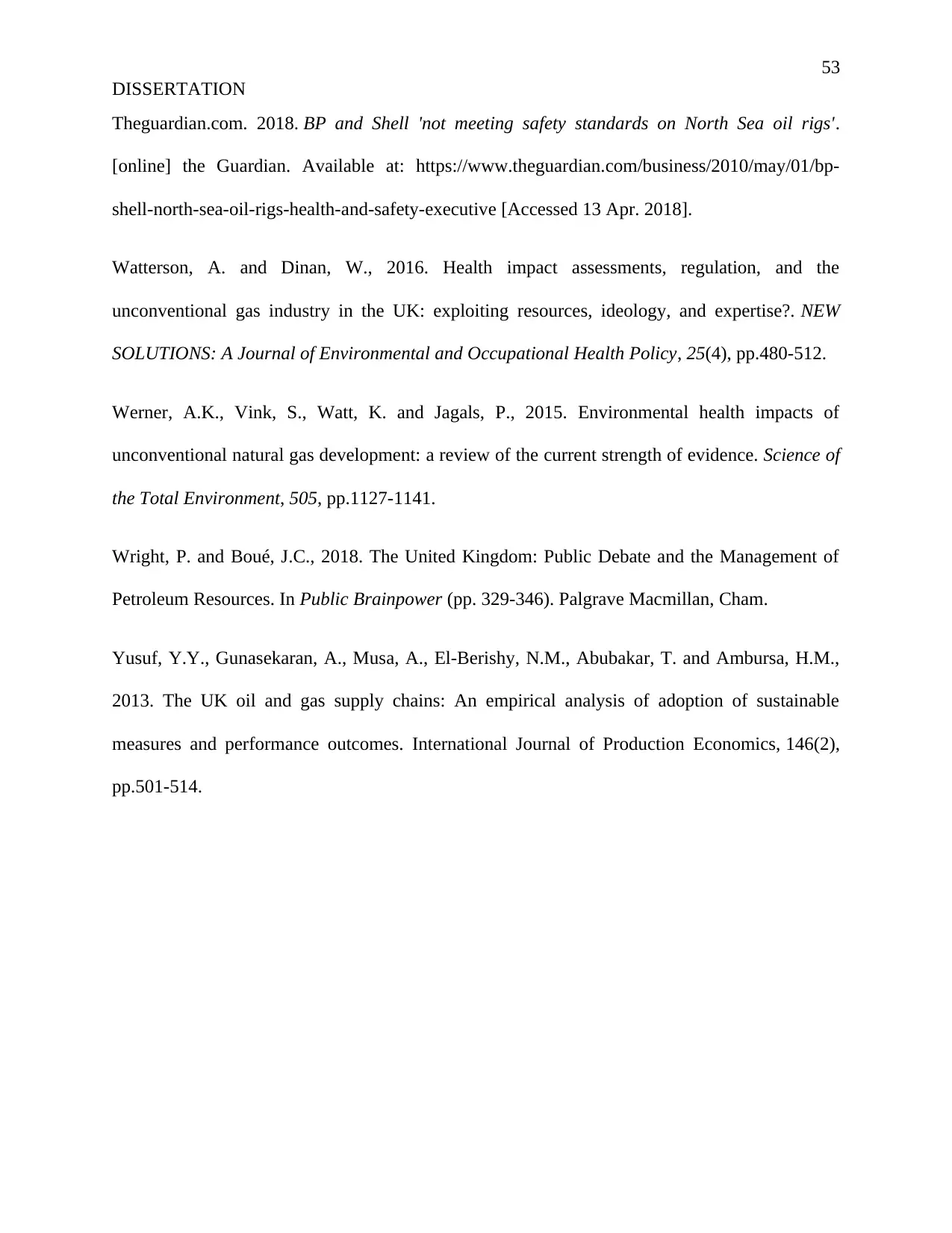
53
DISSERTATION
Theguardian.com. 2018. BP and Shell 'not meeting safety standards on North Sea oil rigs'.
[online] the Guardian. Available at: https://www.theguardian.com/business/2010/may/01/bp-
shell-north-sea-oil-rigs-health-and-safety-executive [Accessed 13 Apr. 2018].
Watterson, A. and Dinan, W., 2016. Health impact assessments, regulation, and the
unconventional gas industry in the UK: exploiting resources, ideology, and expertise?. NEW
SOLUTIONS: A Journal of Environmental and Occupational Health Policy, 25(4), pp.480-512.
Werner, A.K., Vink, S., Watt, K. and Jagals, P., 2015. Environmental health impacts of
unconventional natural gas development: a review of the current strength of evidence. Science of
the Total Environment, 505, pp.1127-1141.
Wright, P. and Boué, J.C., 2018. The United Kingdom: Public Debate and the Management of
Petroleum Resources. In Public Brainpower (pp. 329-346). Palgrave Macmillan, Cham.
Yusuf, Y.Y., Gunasekaran, A., Musa, A., El-Berishy, N.M., Abubakar, T. and Ambursa, H.M.,
2013. The UK oil and gas supply chains: An empirical analysis of adoption of sustainable
measures and performance outcomes. International Journal of Production Economics, 146(2),
pp.501-514.
DISSERTATION
Theguardian.com. 2018. BP and Shell 'not meeting safety standards on North Sea oil rigs'.
[online] the Guardian. Available at: https://www.theguardian.com/business/2010/may/01/bp-
shell-north-sea-oil-rigs-health-and-safety-executive [Accessed 13 Apr. 2018].
Watterson, A. and Dinan, W., 2016. Health impact assessments, regulation, and the
unconventional gas industry in the UK: exploiting resources, ideology, and expertise?. NEW
SOLUTIONS: A Journal of Environmental and Occupational Health Policy, 25(4), pp.480-512.
Werner, A.K., Vink, S., Watt, K. and Jagals, P., 2015. Environmental health impacts of
unconventional natural gas development: a review of the current strength of evidence. Science of
the Total Environment, 505, pp.1127-1141.
Wright, P. and Boué, J.C., 2018. The United Kingdom: Public Debate and the Management of
Petroleum Resources. In Public Brainpower (pp. 329-346). Palgrave Macmillan, Cham.
Yusuf, Y.Y., Gunasekaran, A., Musa, A., El-Berishy, N.M., Abubakar, T. and Ambursa, H.M.,
2013. The UK oil and gas supply chains: An empirical analysis of adoption of sustainable
measures and performance outcomes. International Journal of Production Economics, 146(2),
pp.501-514.
1 out of 54
Related Documents
Your All-in-One AI-Powered Toolkit for Academic Success.
+13062052269
info@desklib.com
Available 24*7 on WhatsApp / Email
![[object Object]](/_next/static/media/star-bottom.7253800d.svg)
Unlock your academic potential
© 2024 | Zucol Services PVT LTD | All rights reserved.





